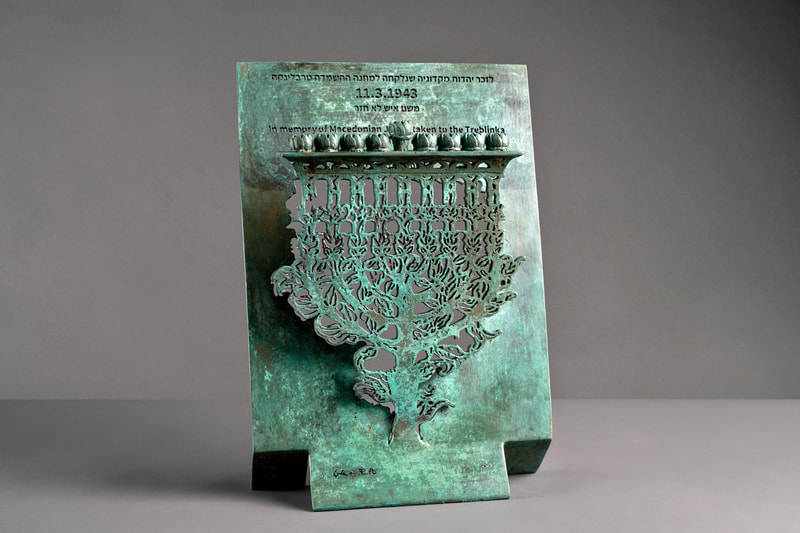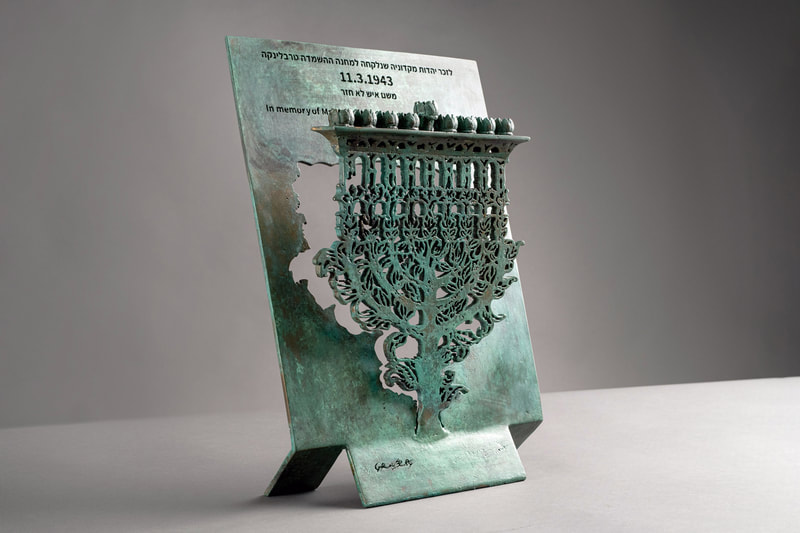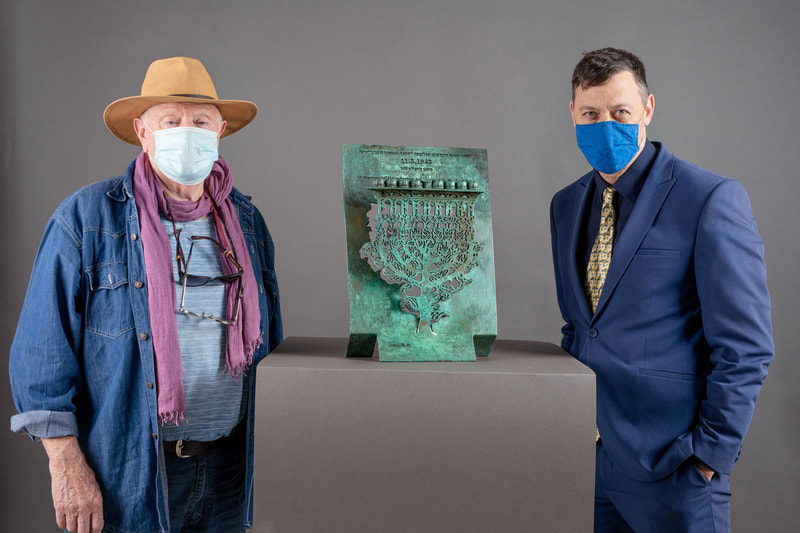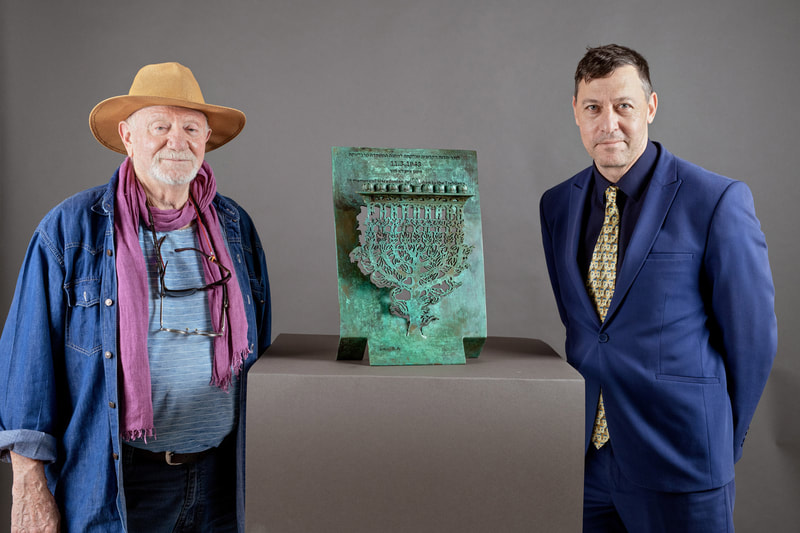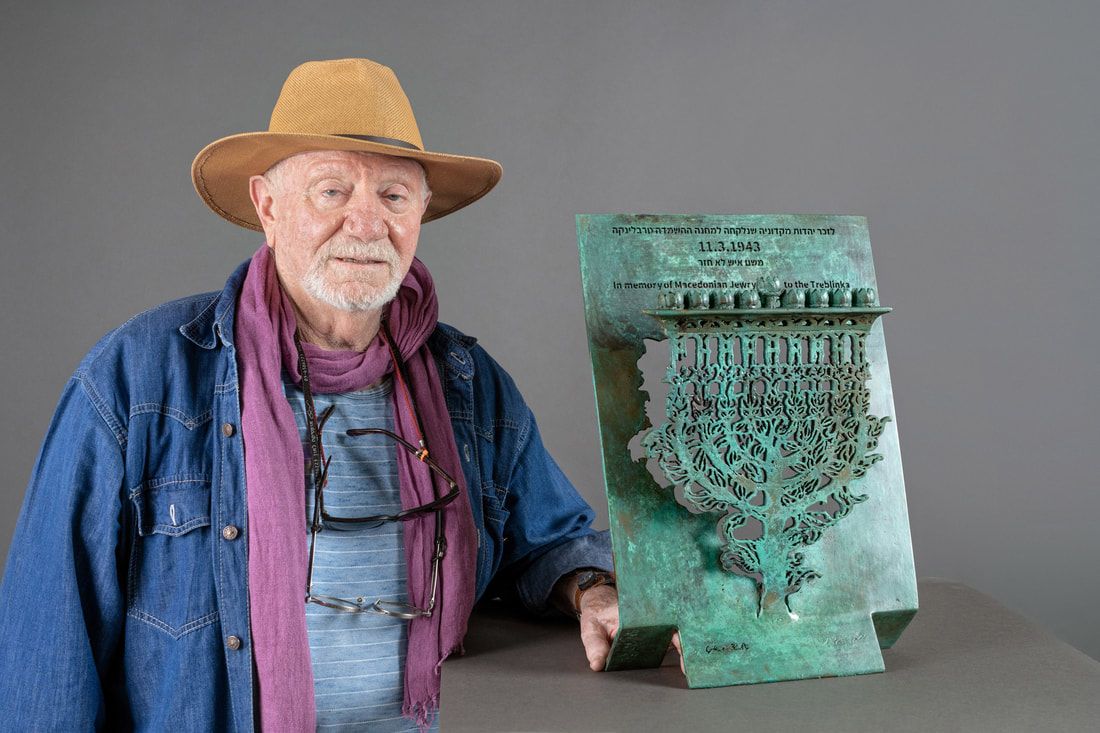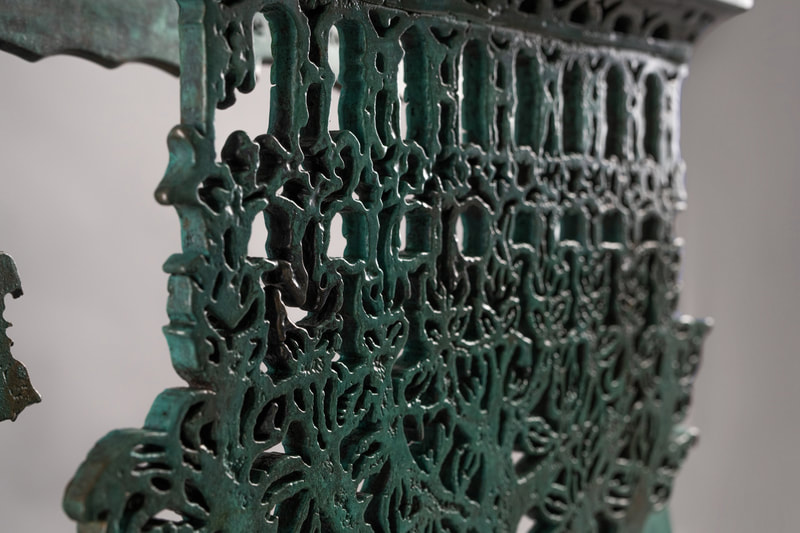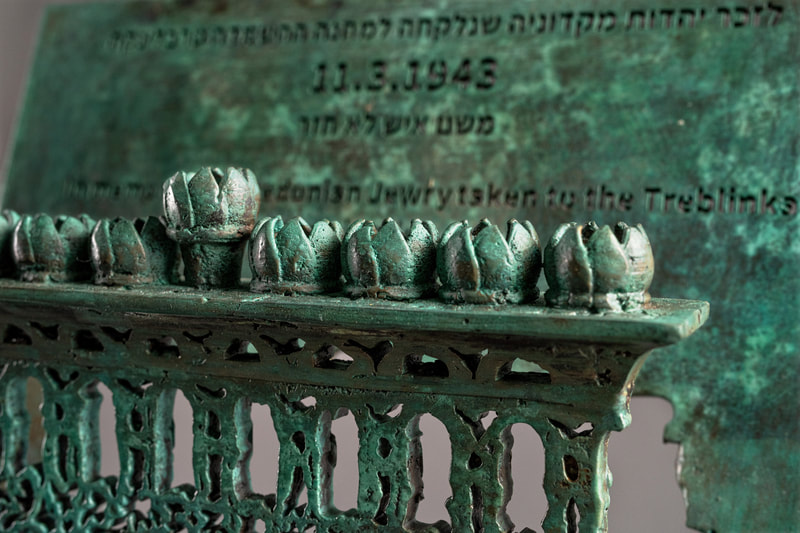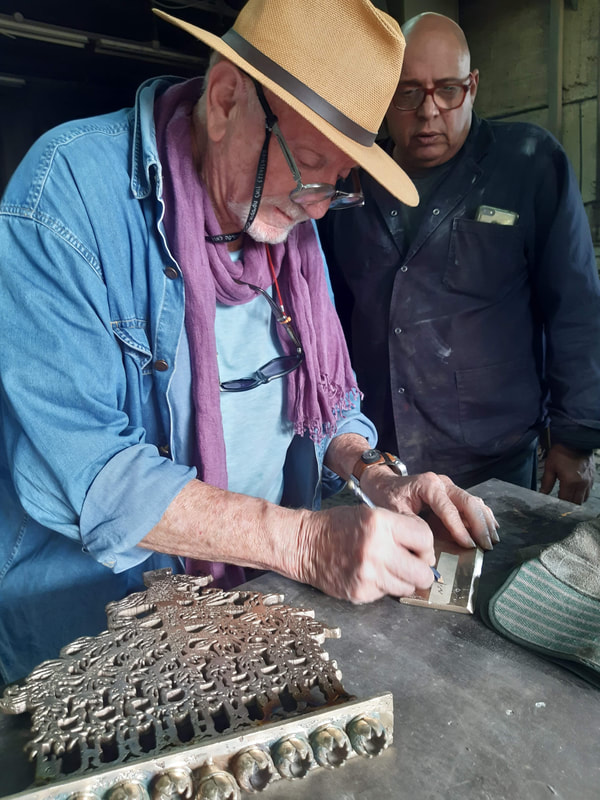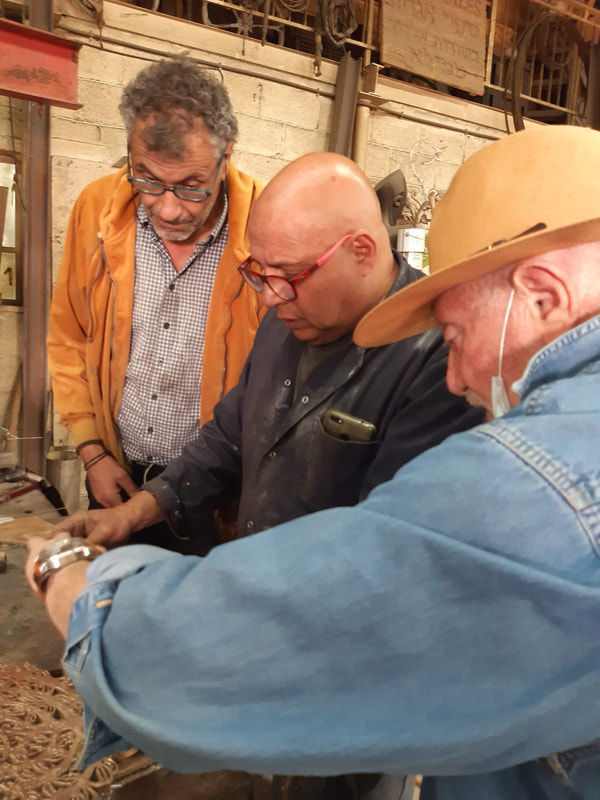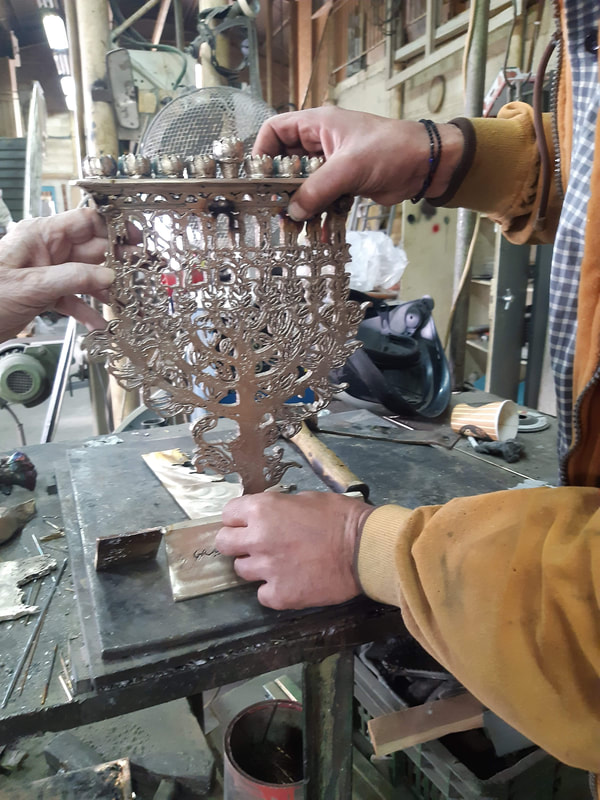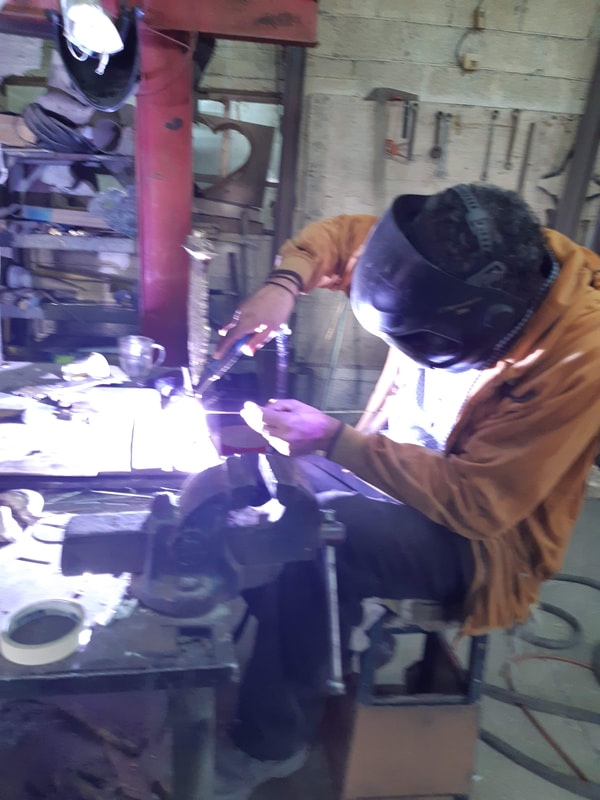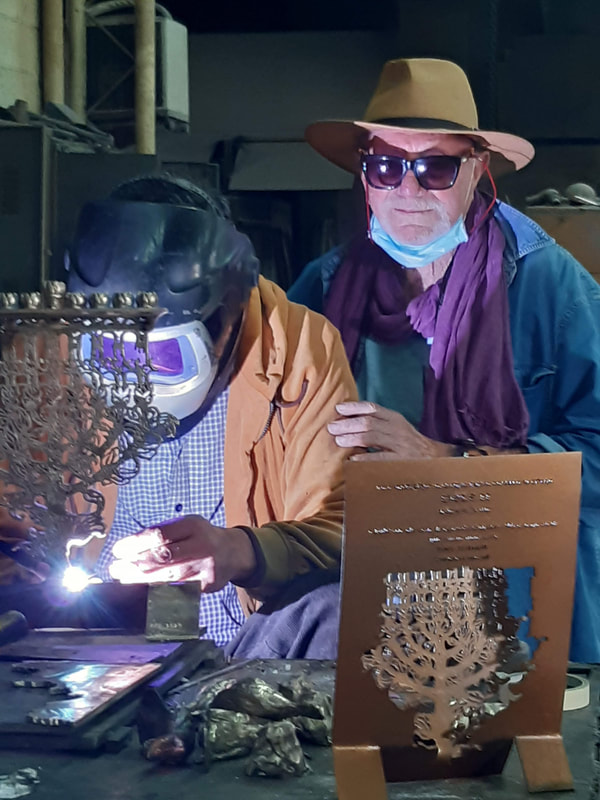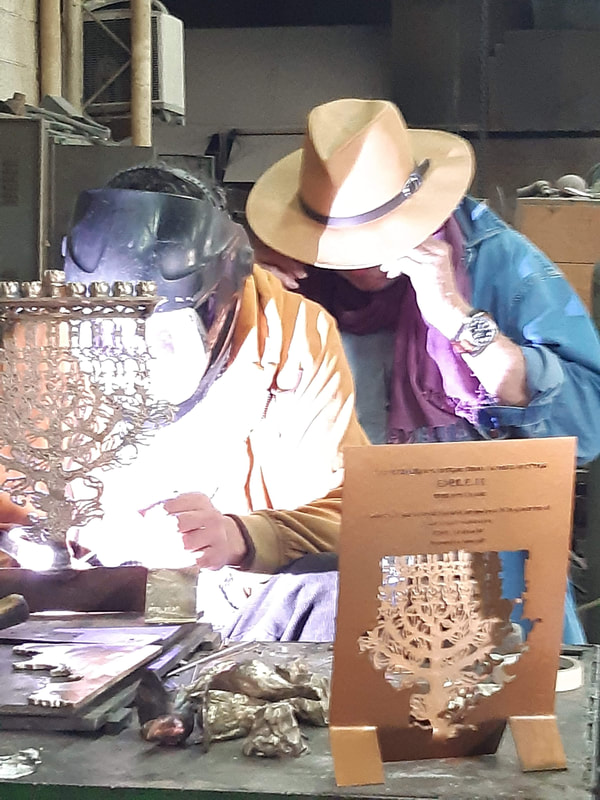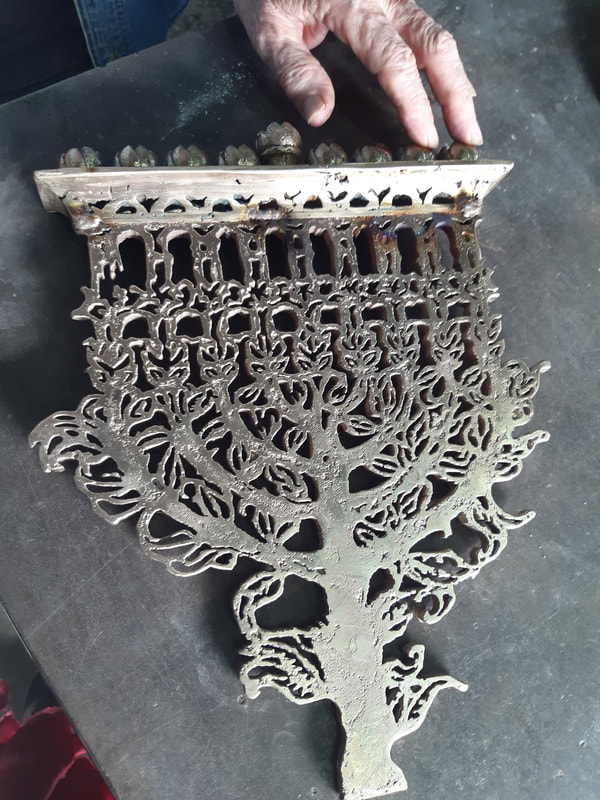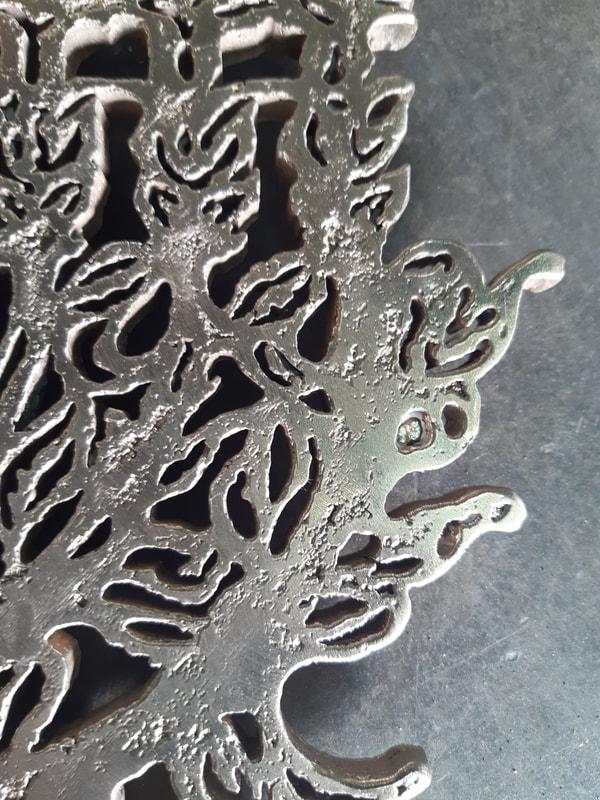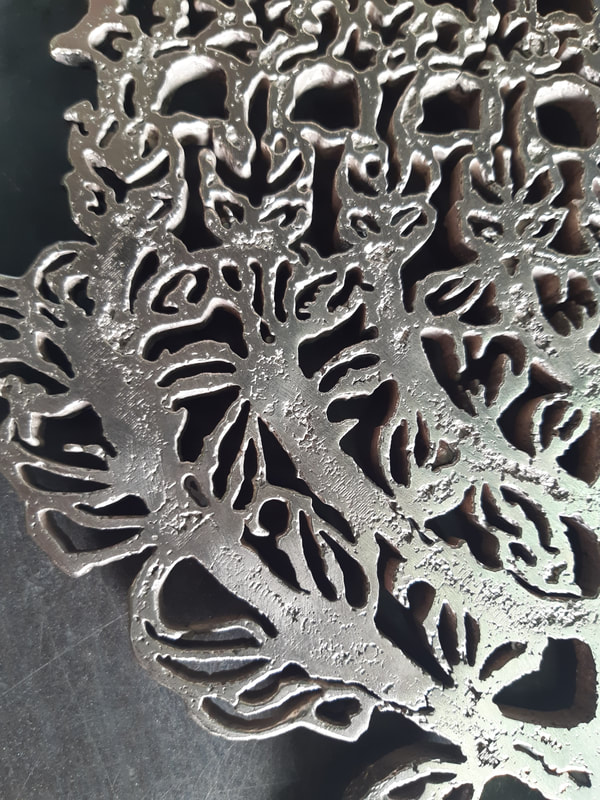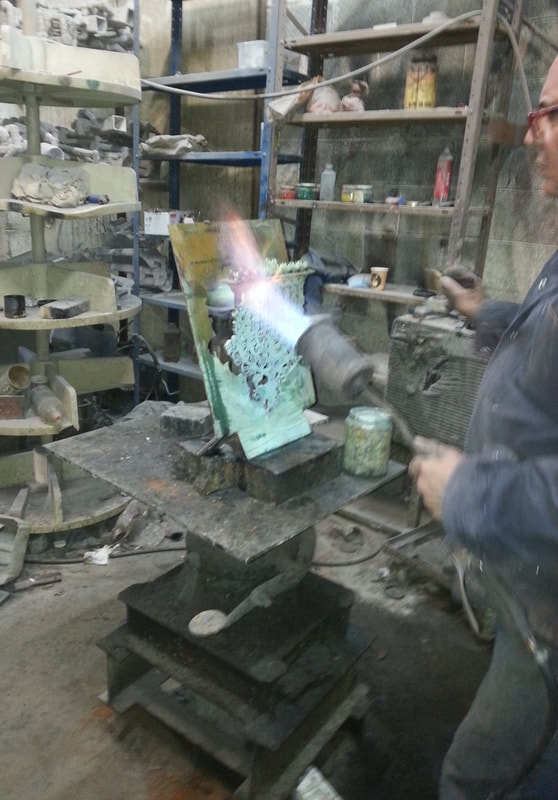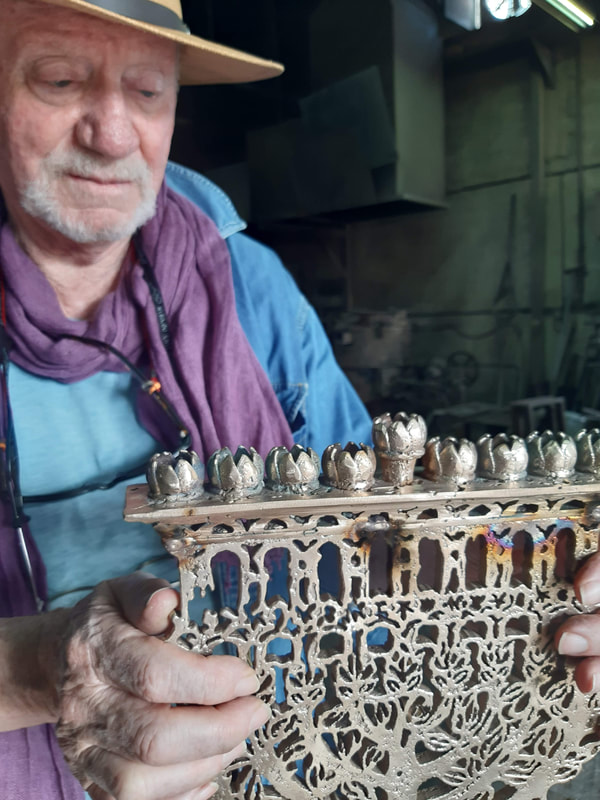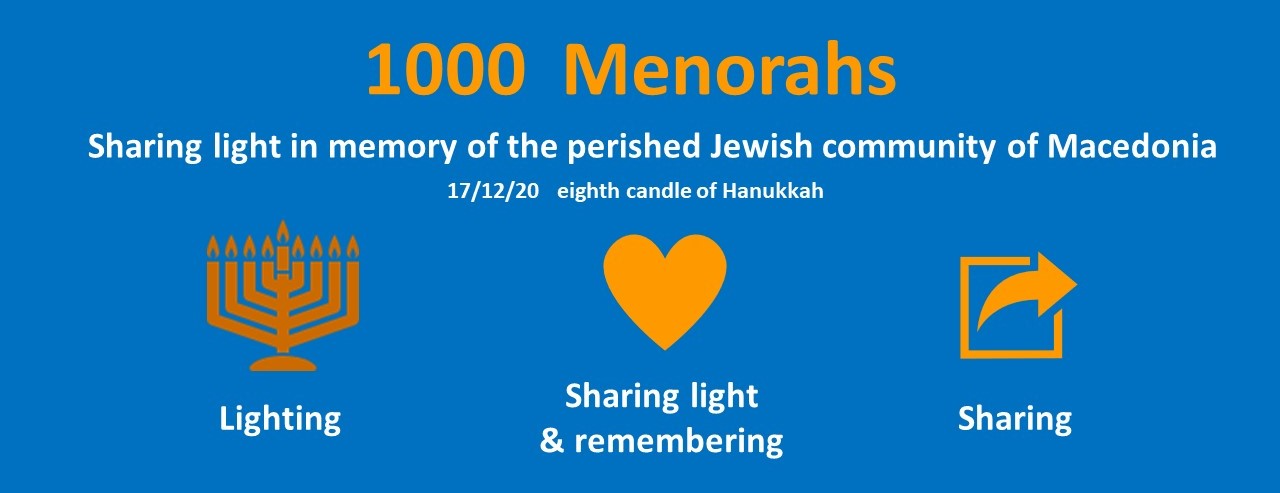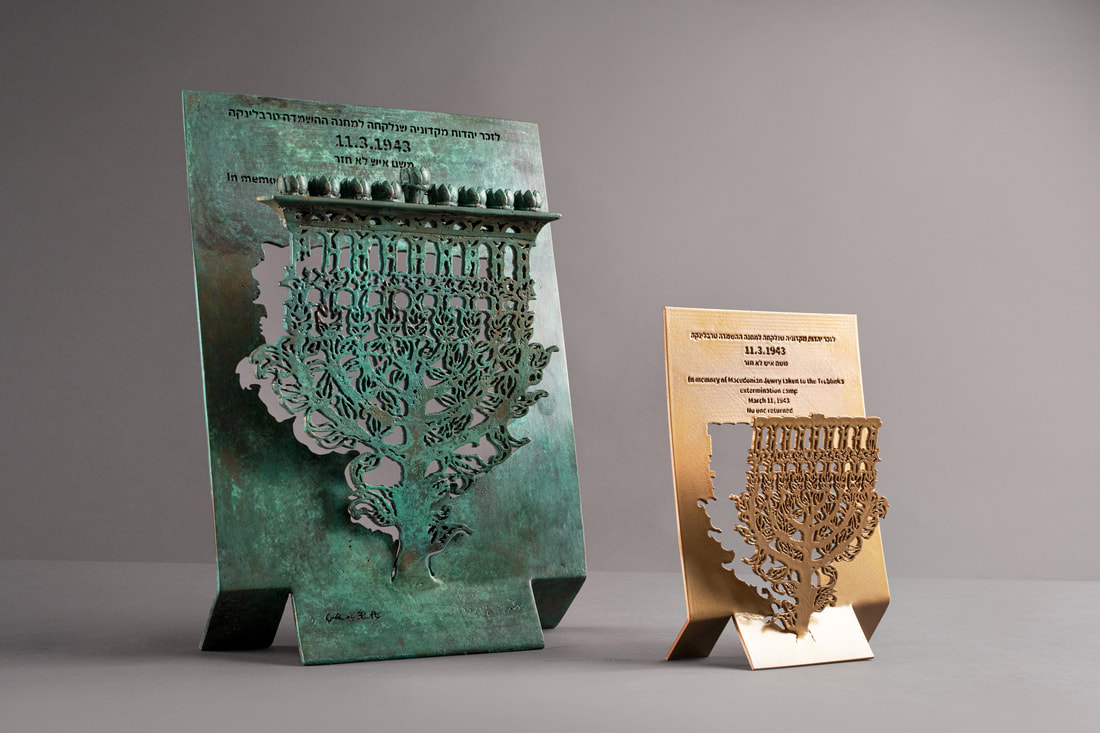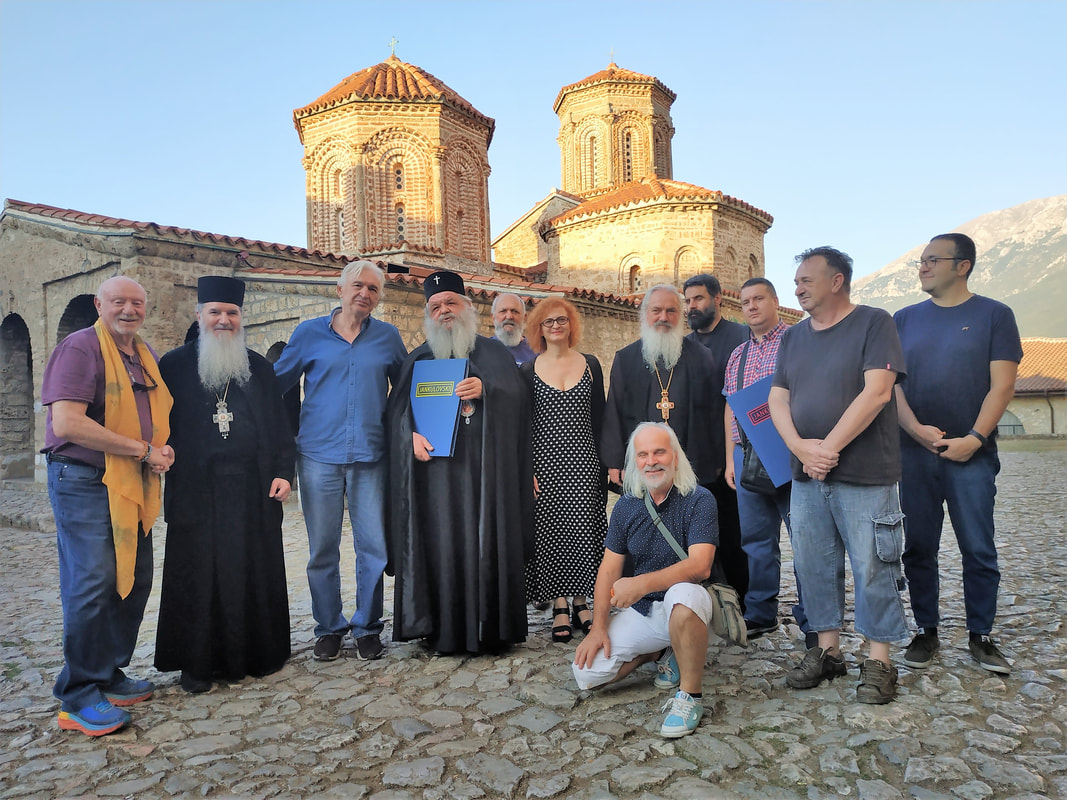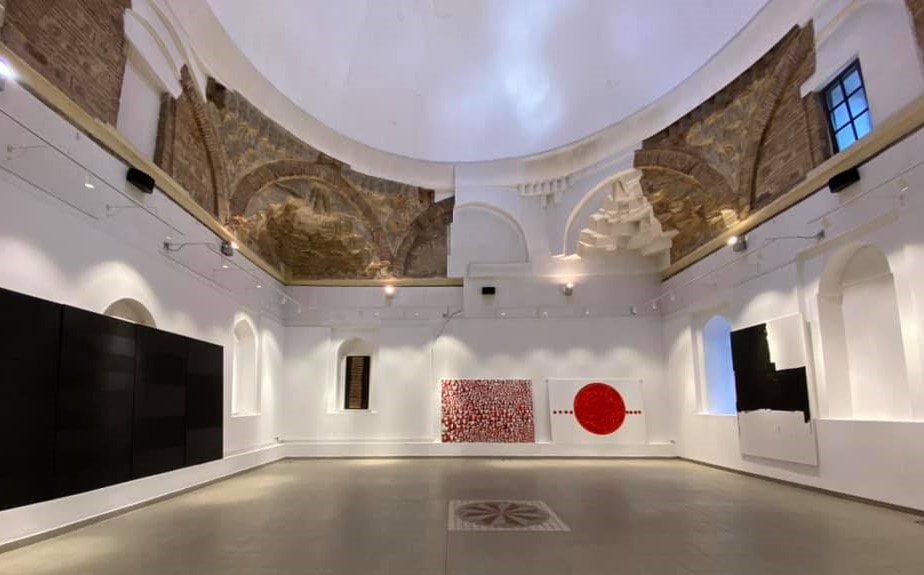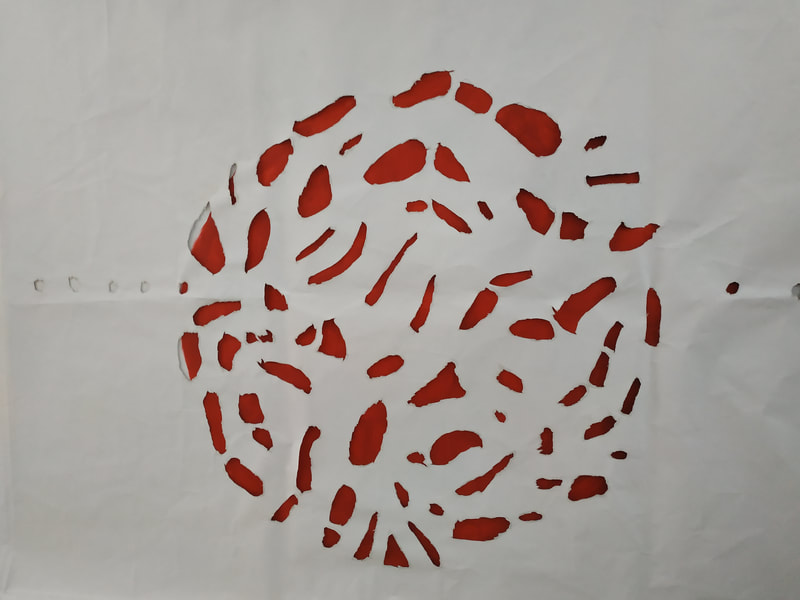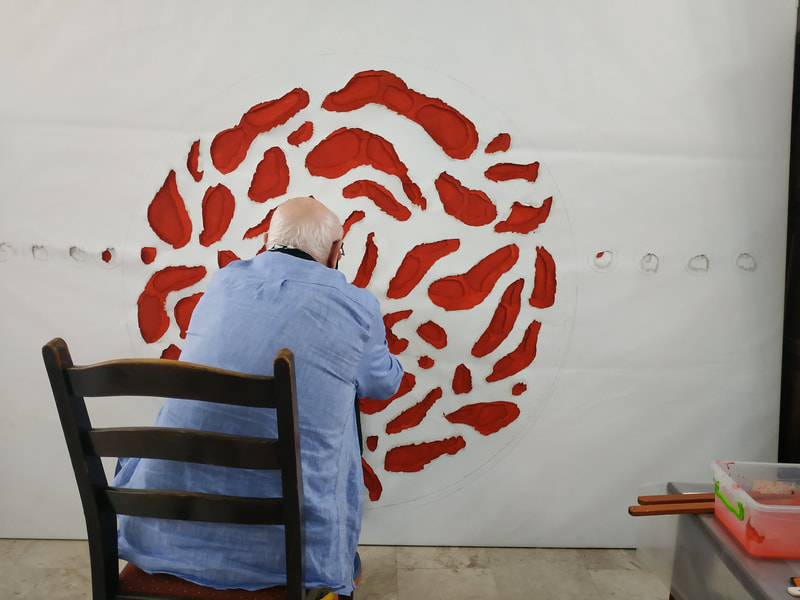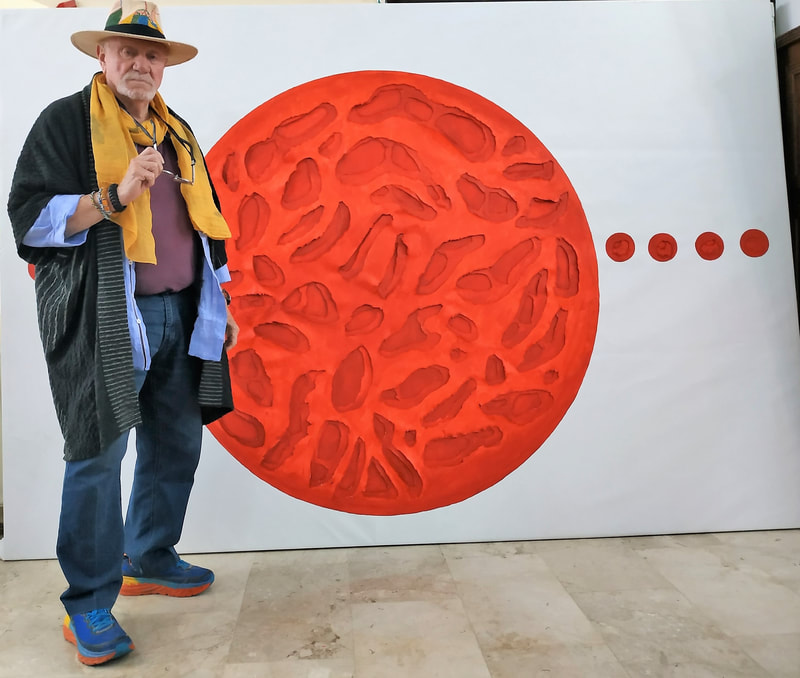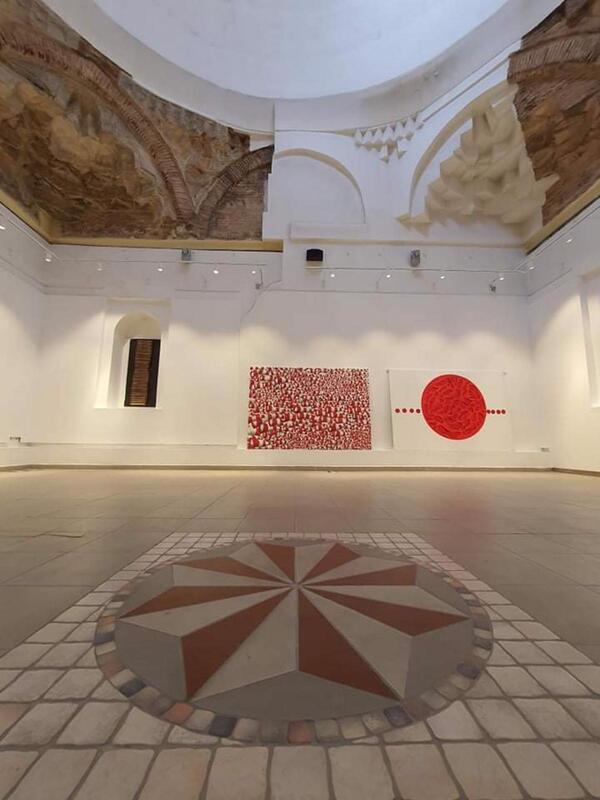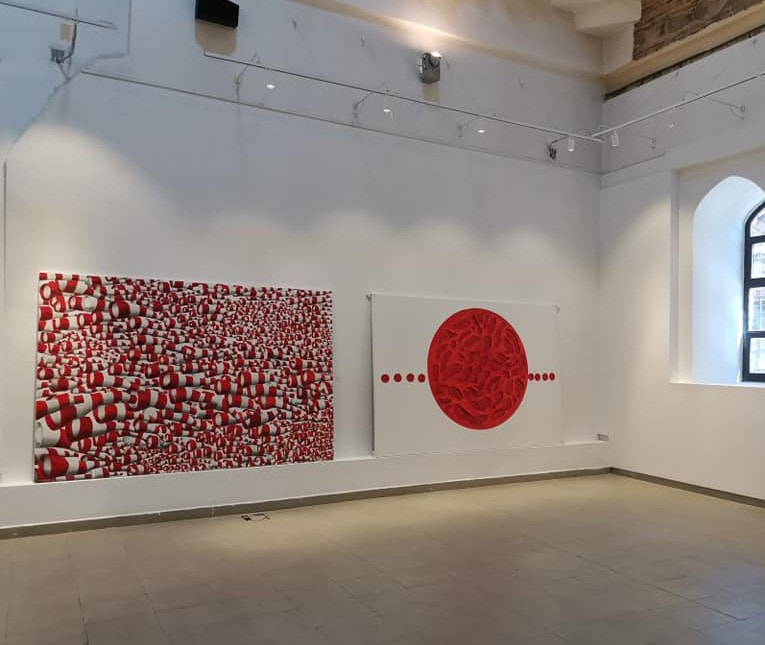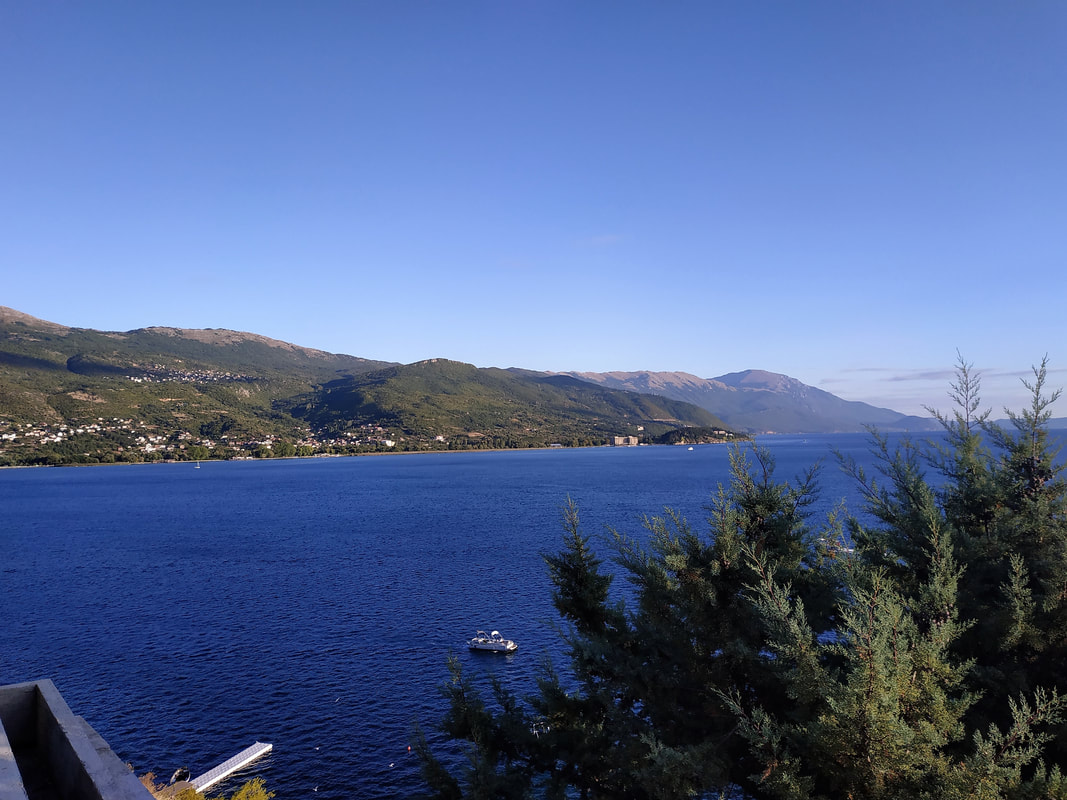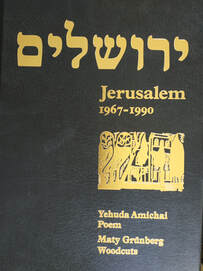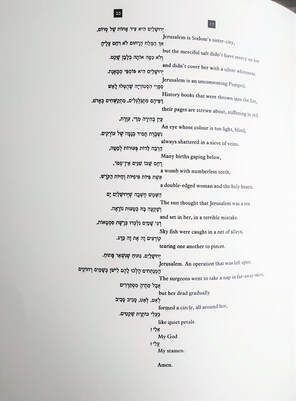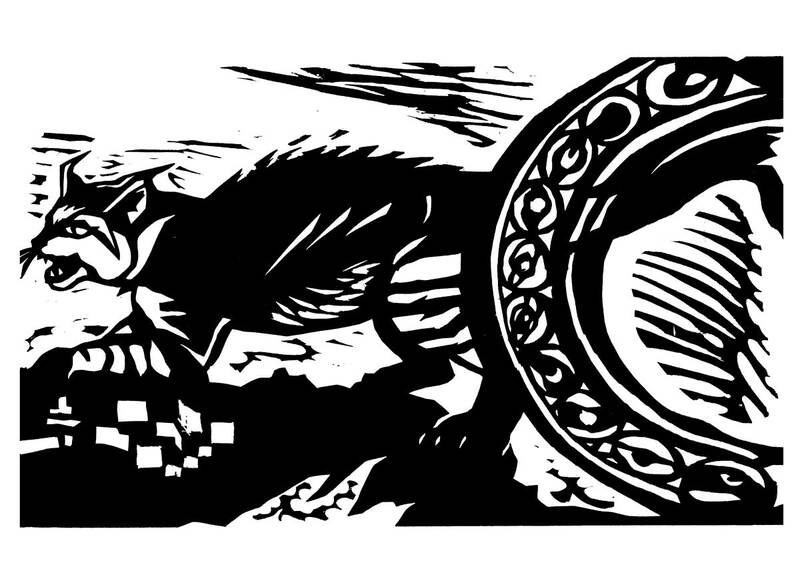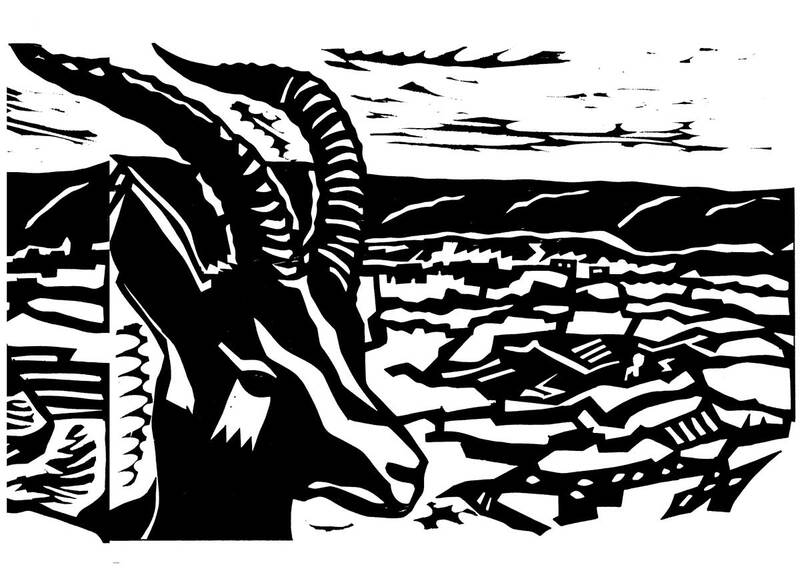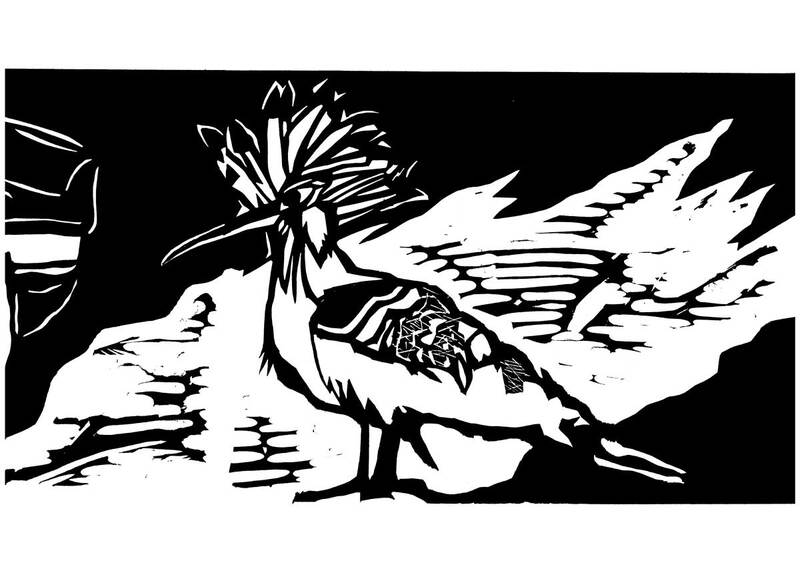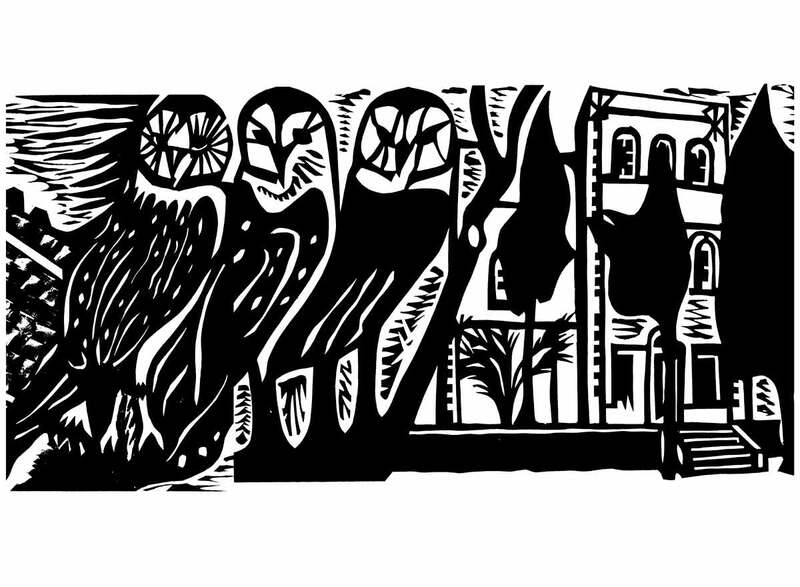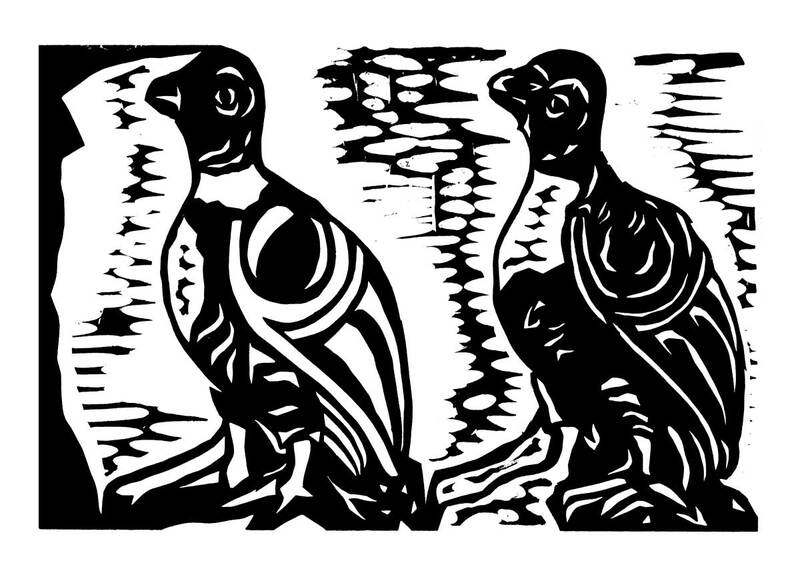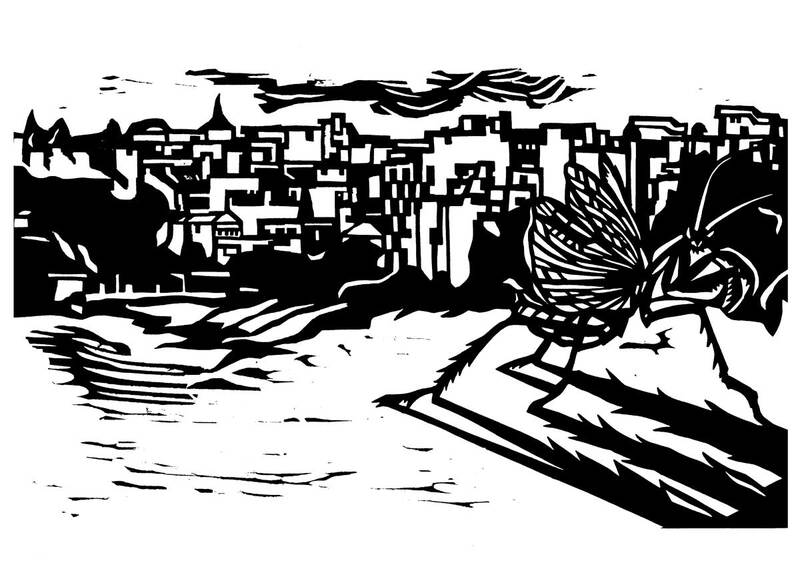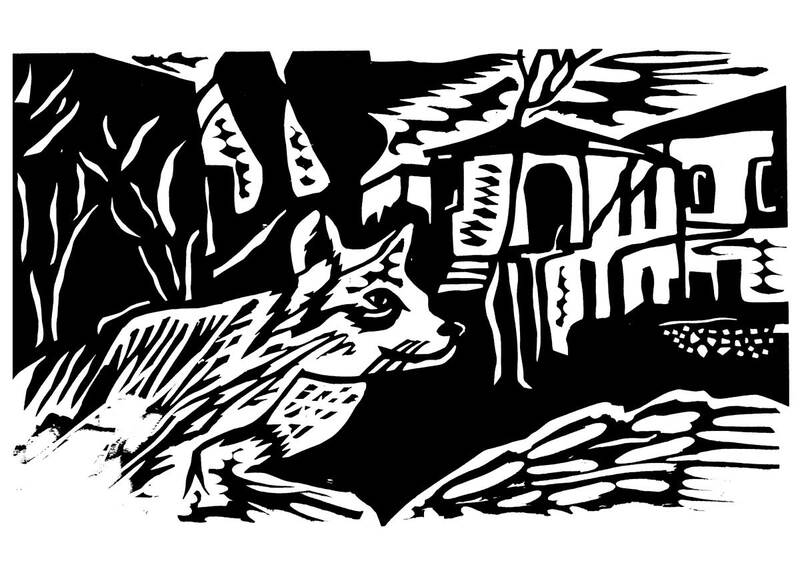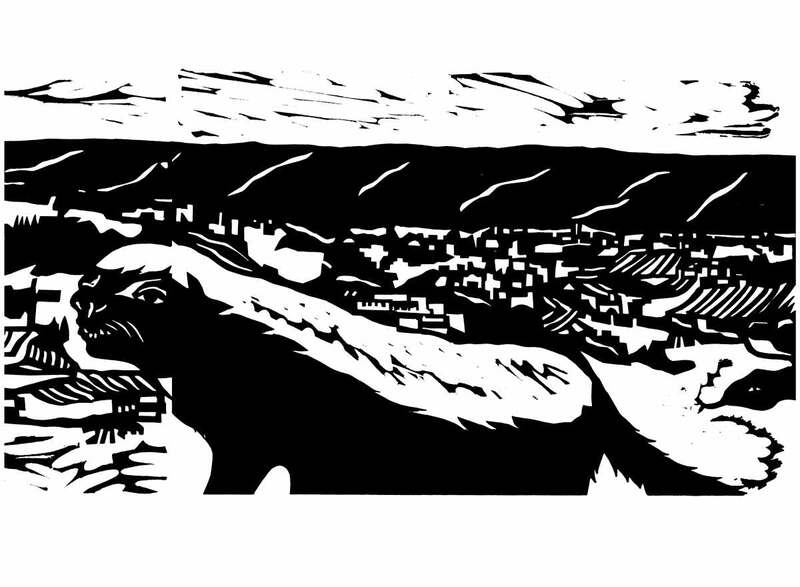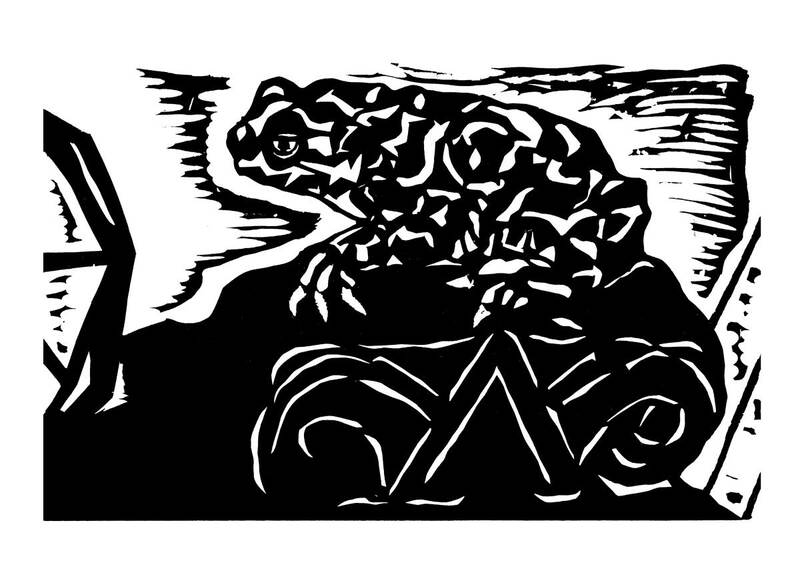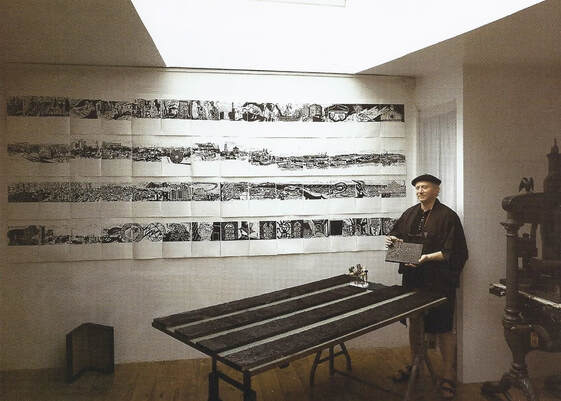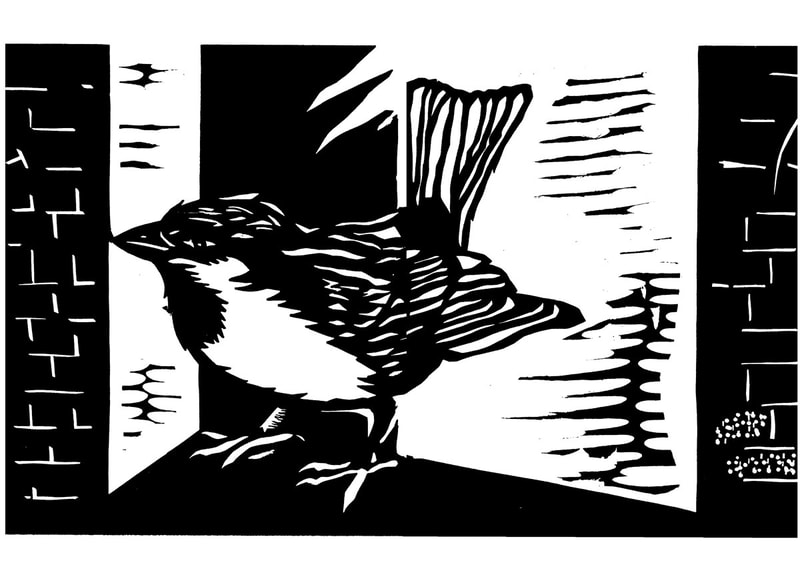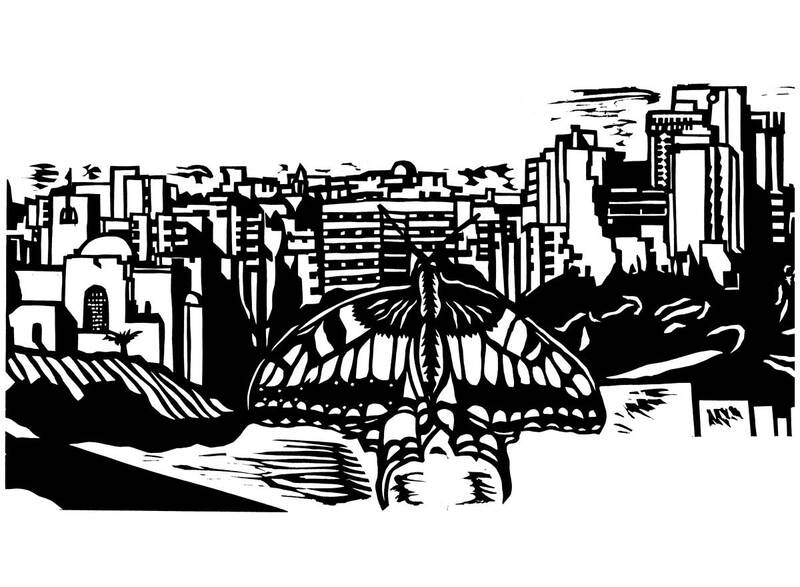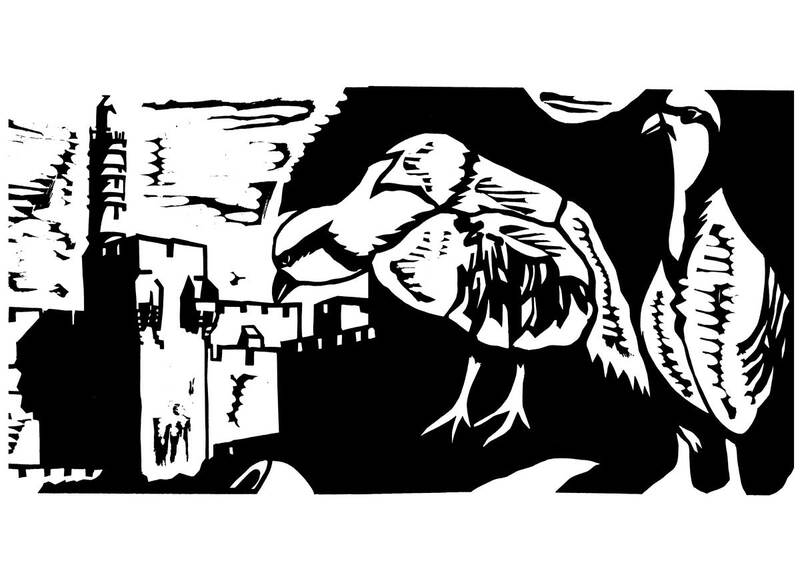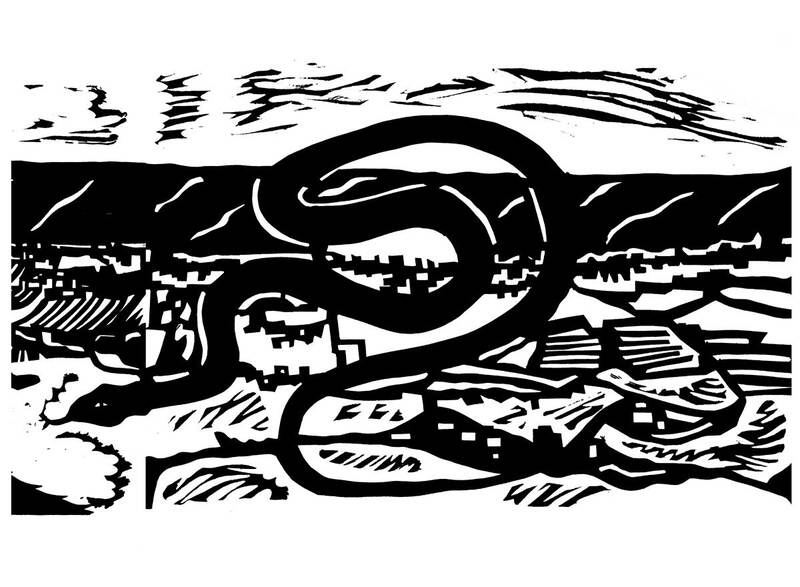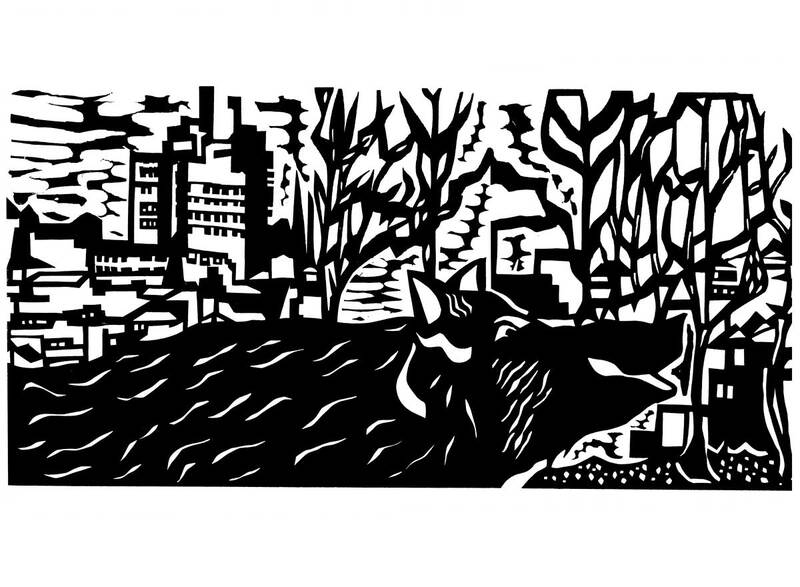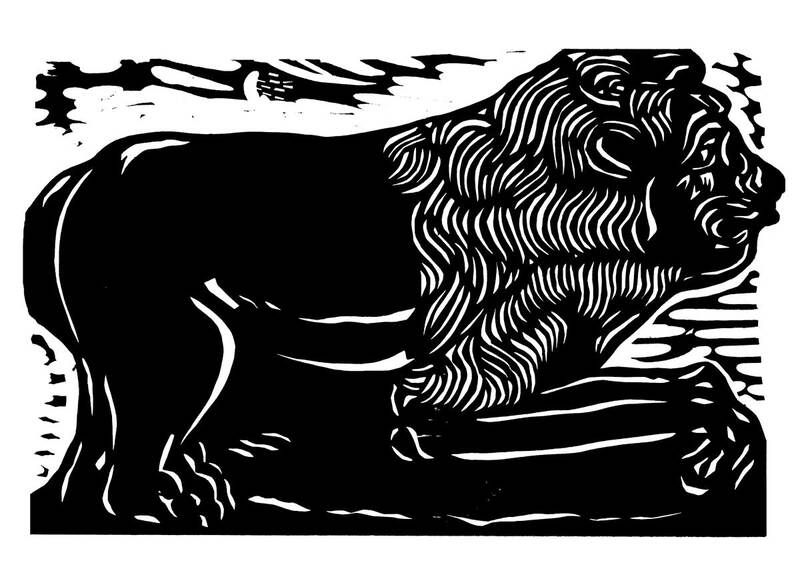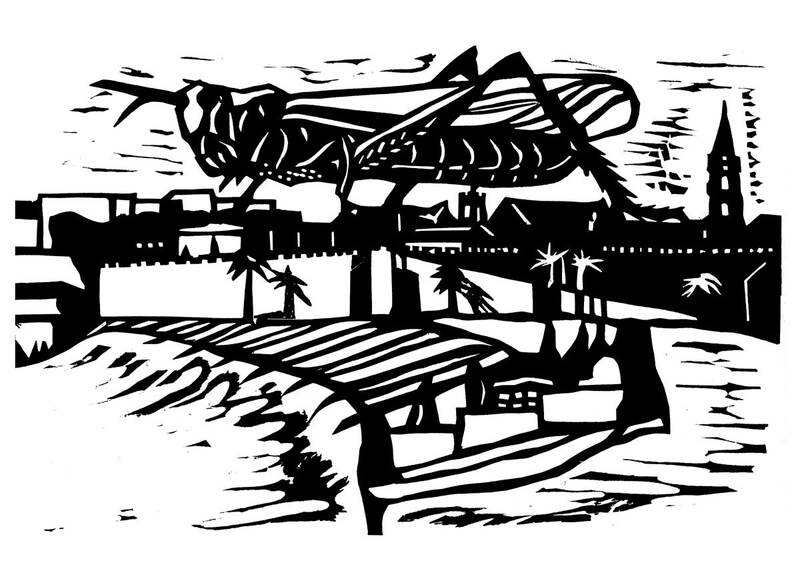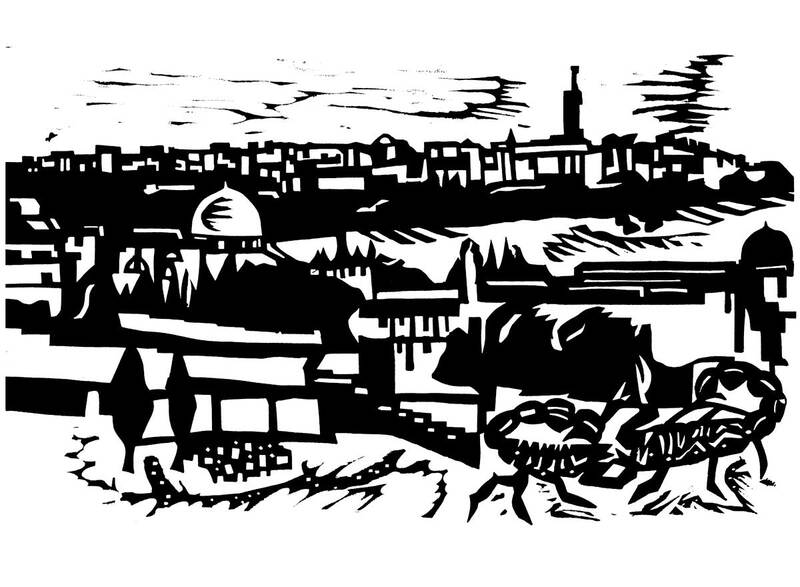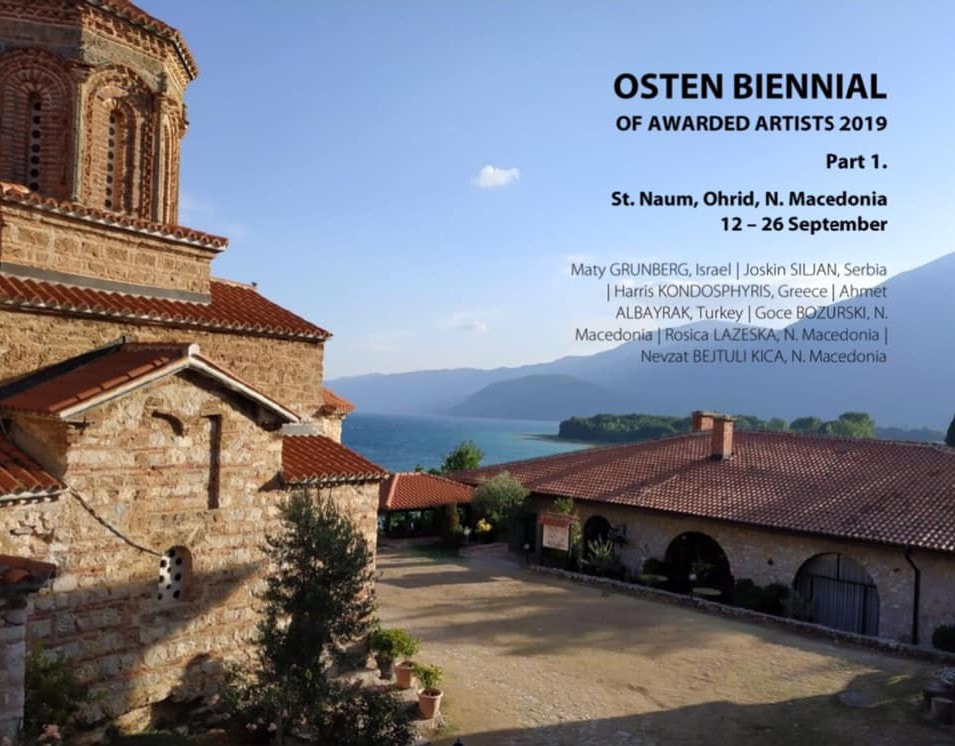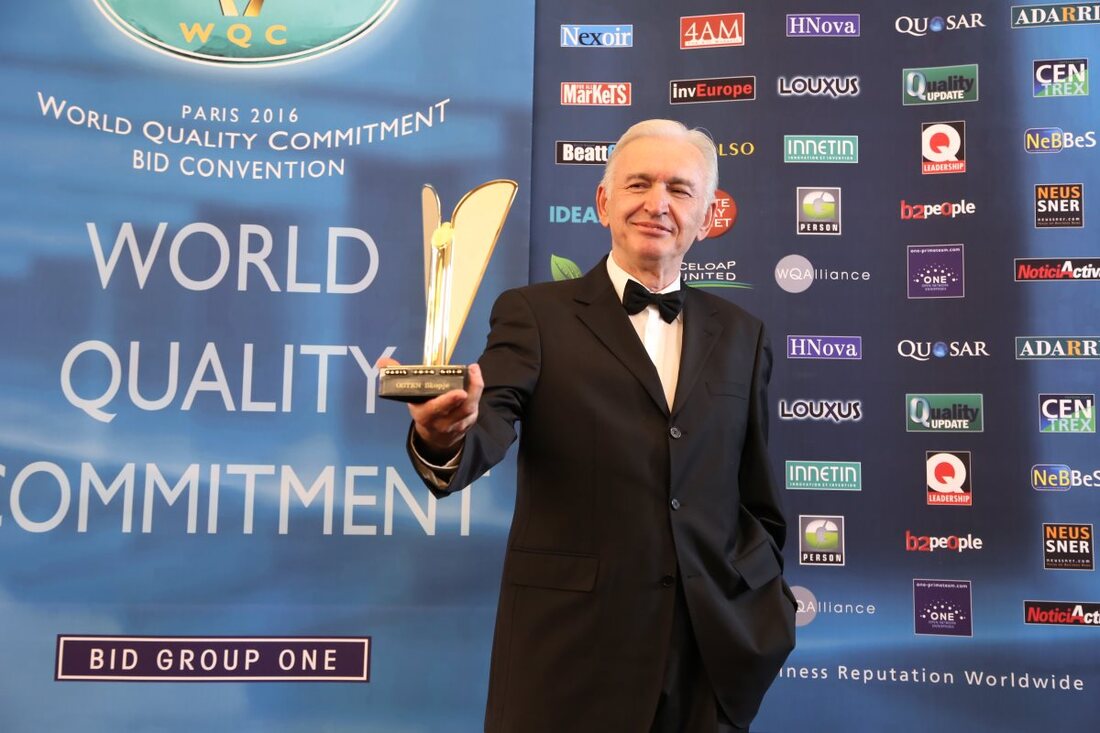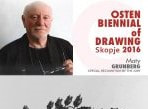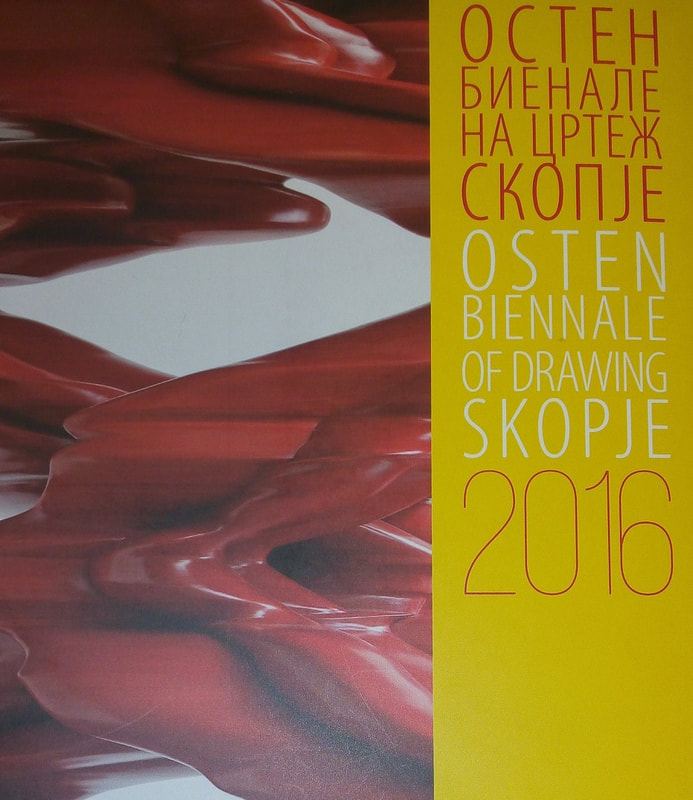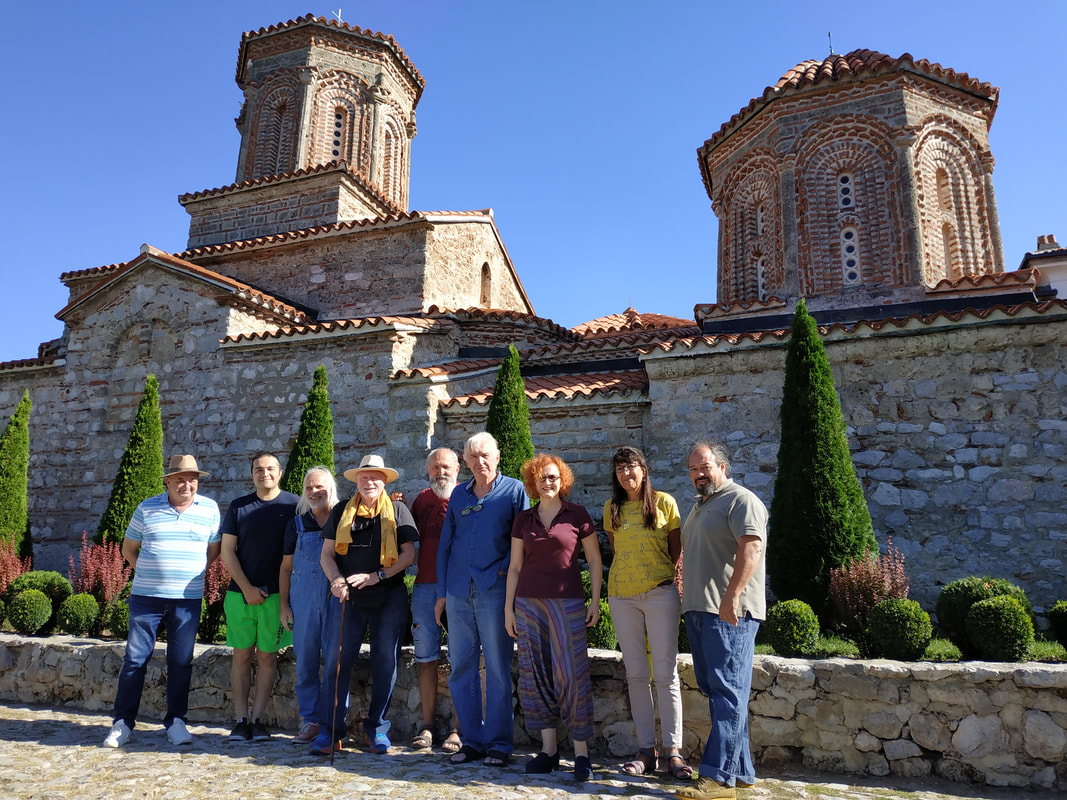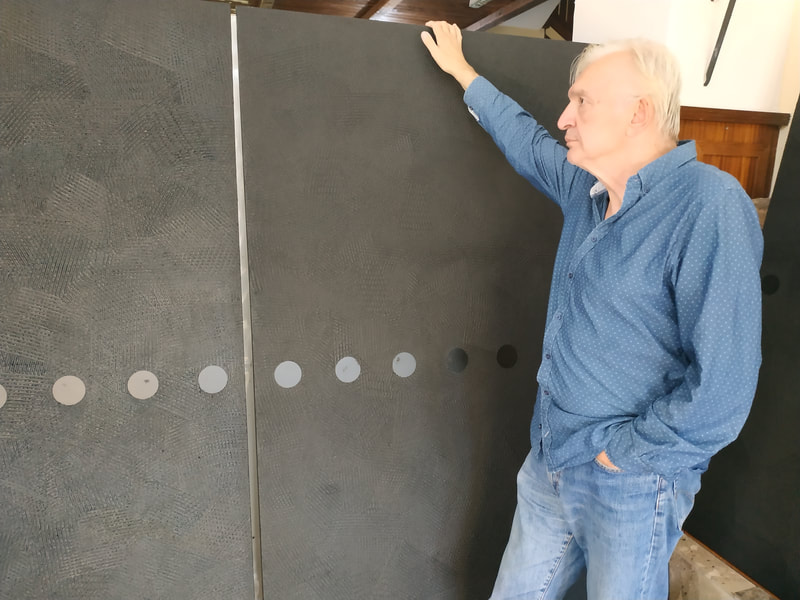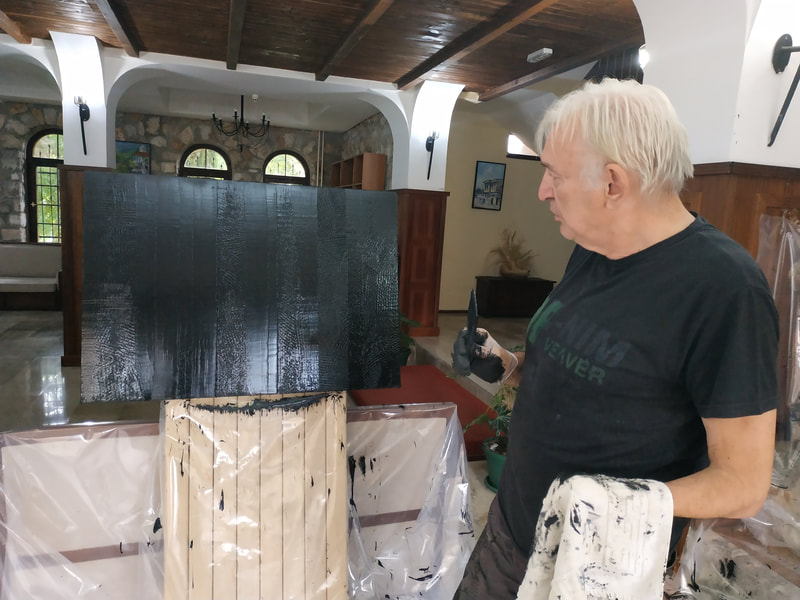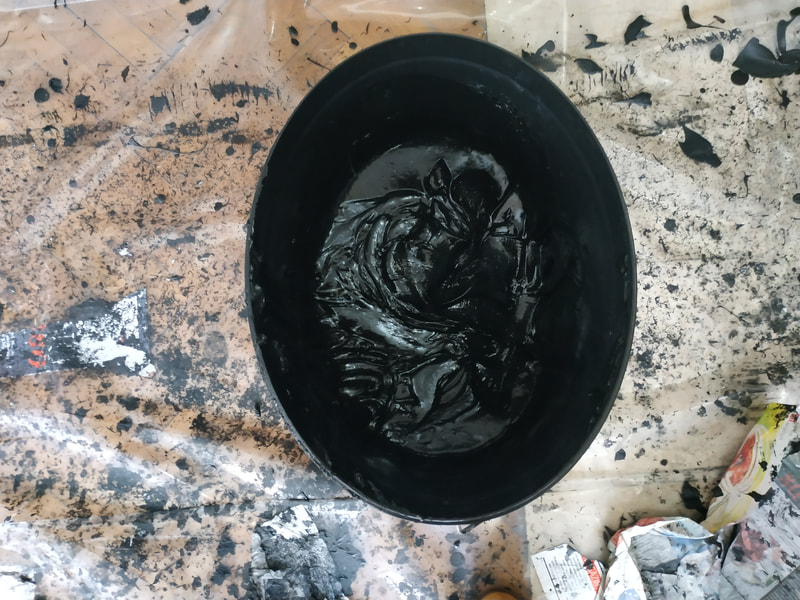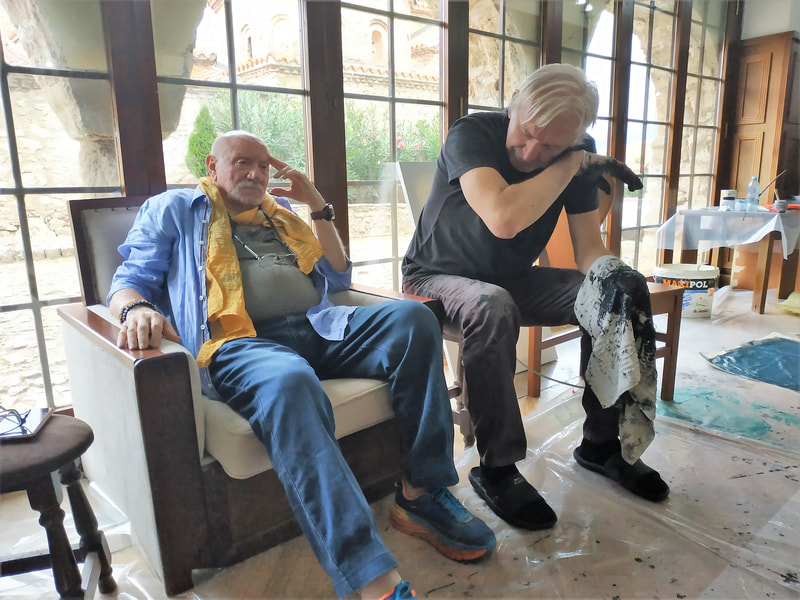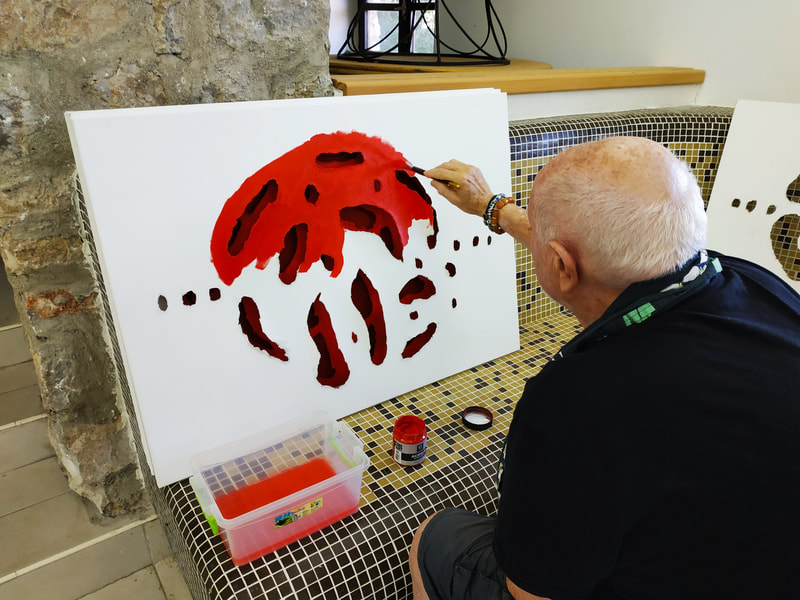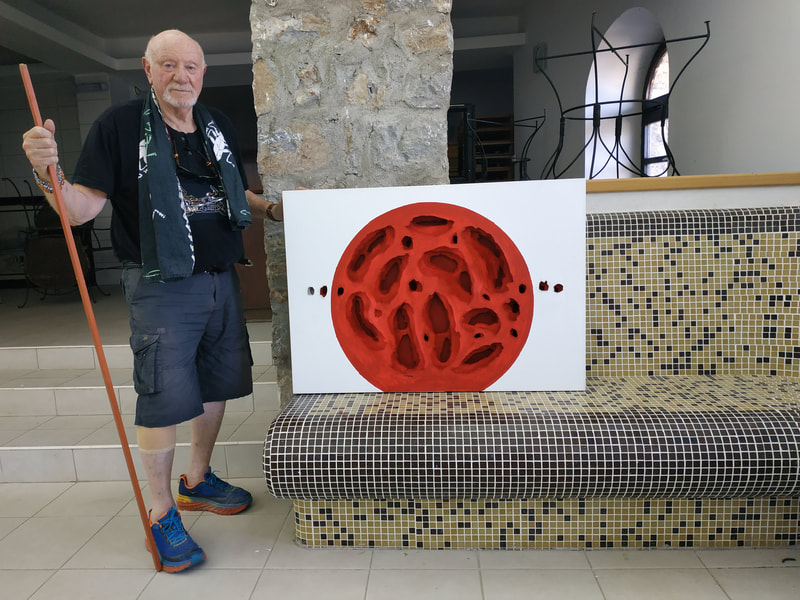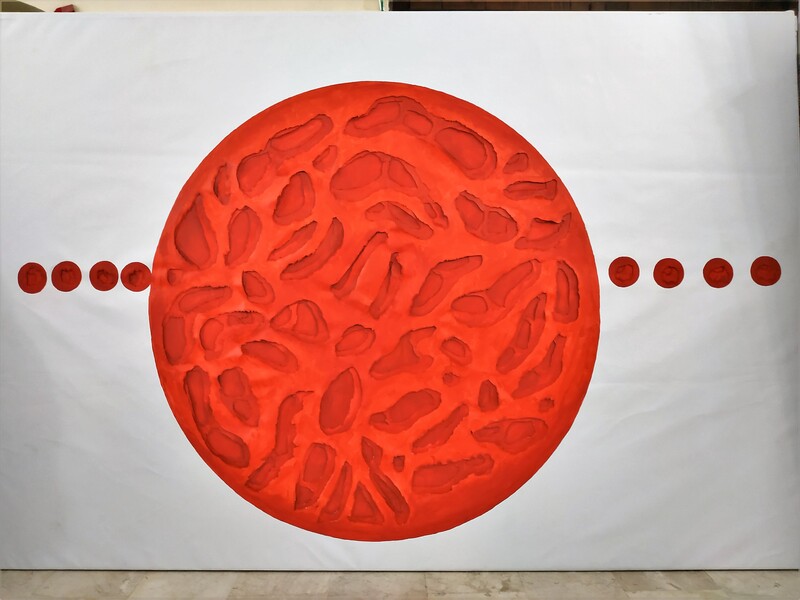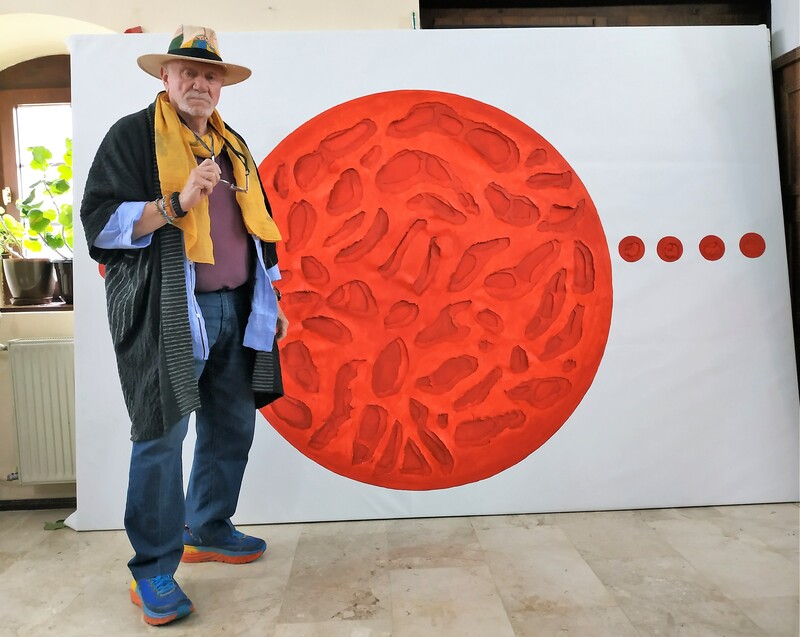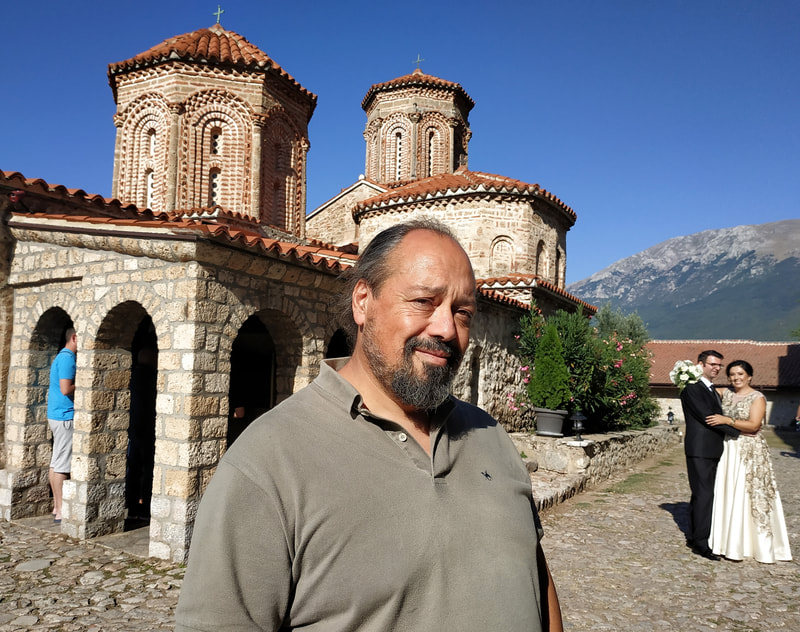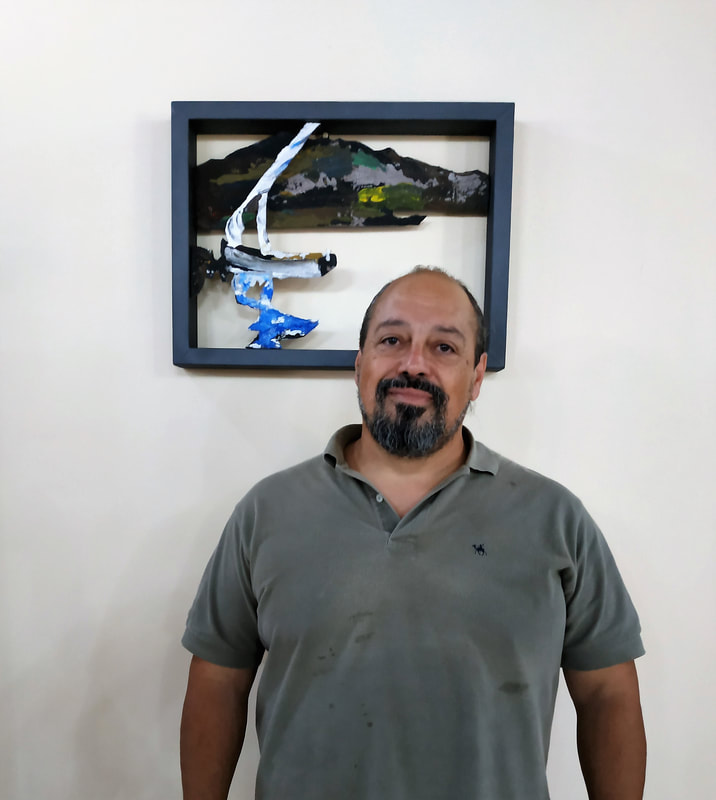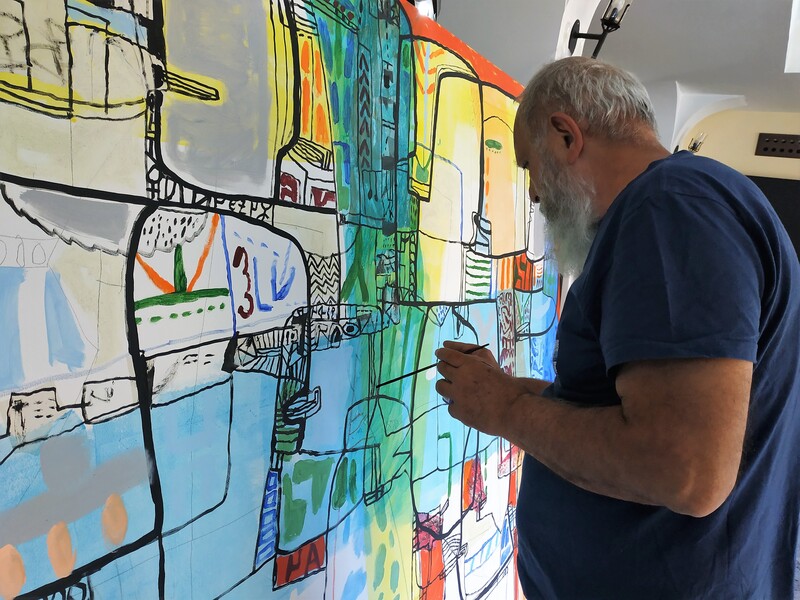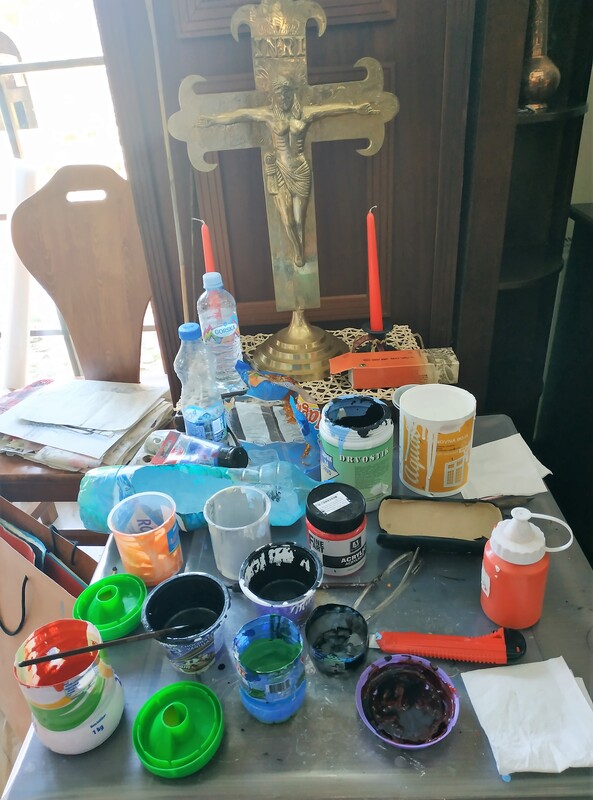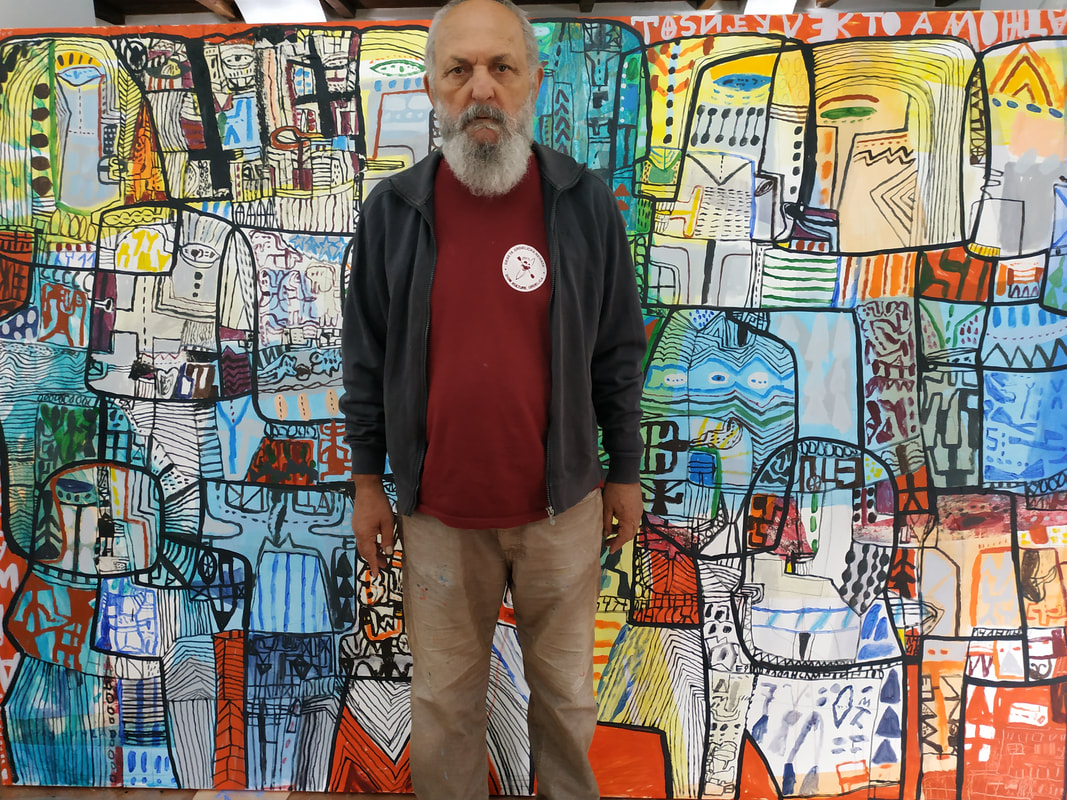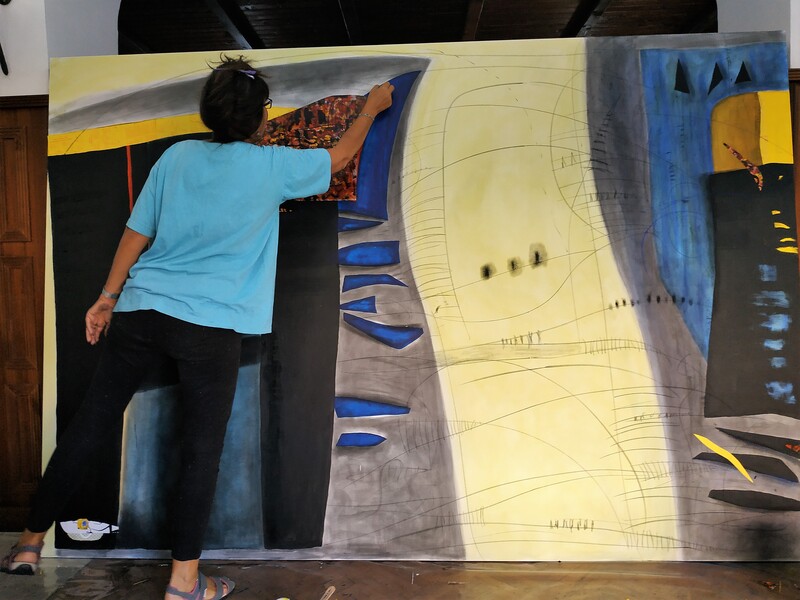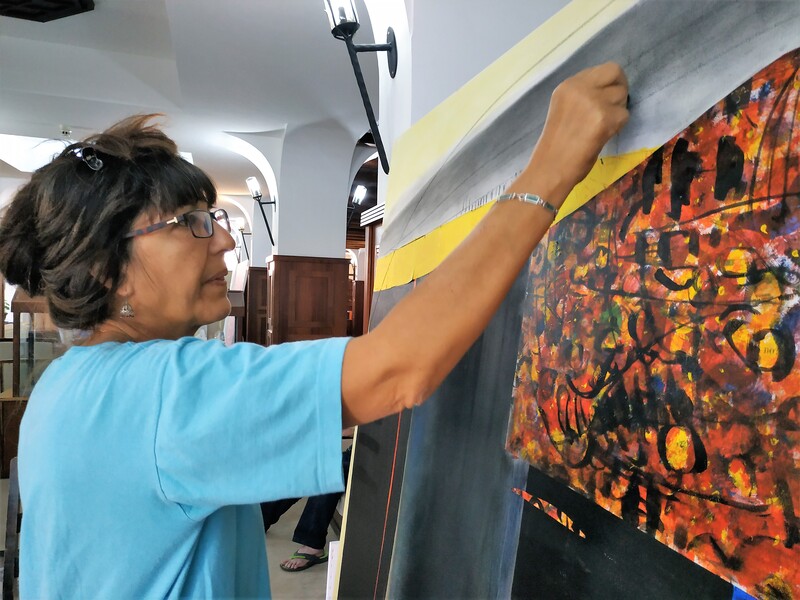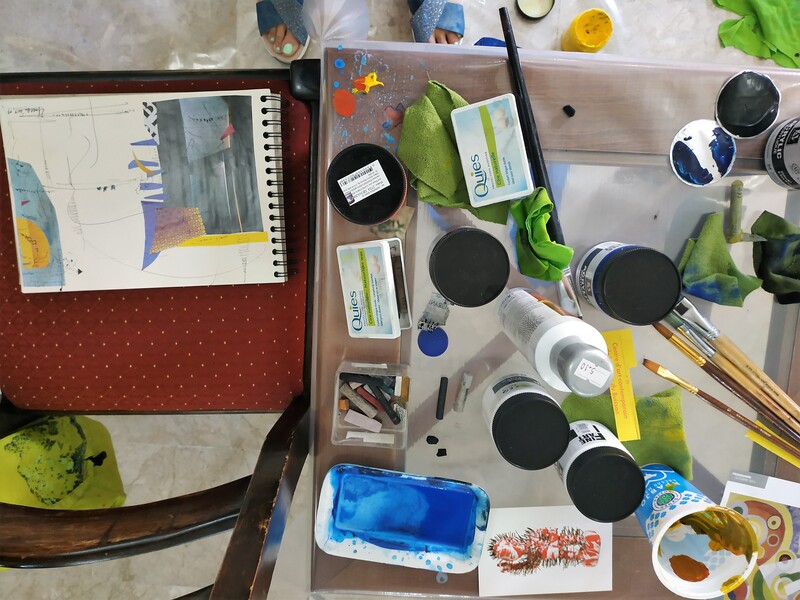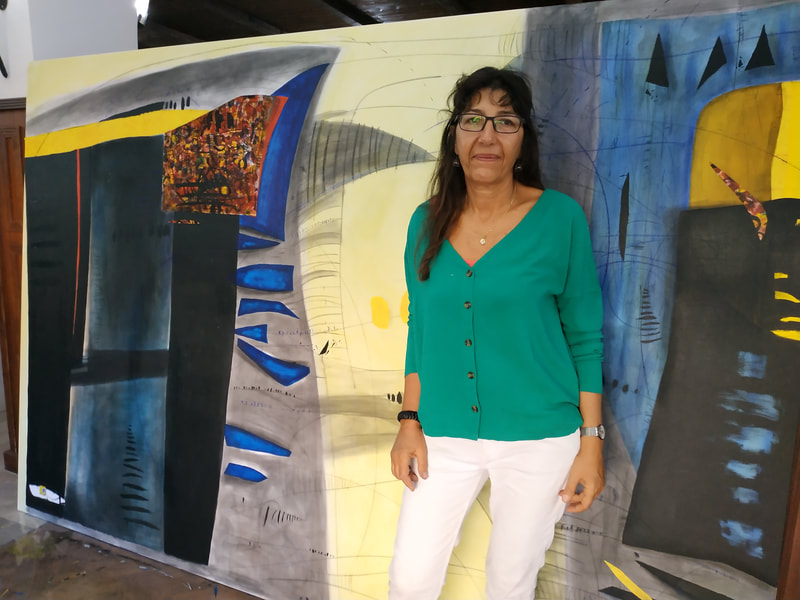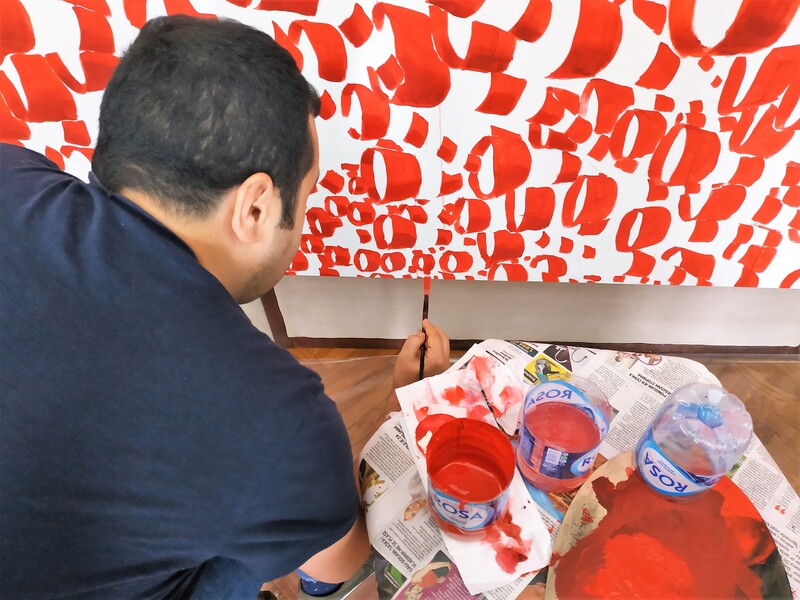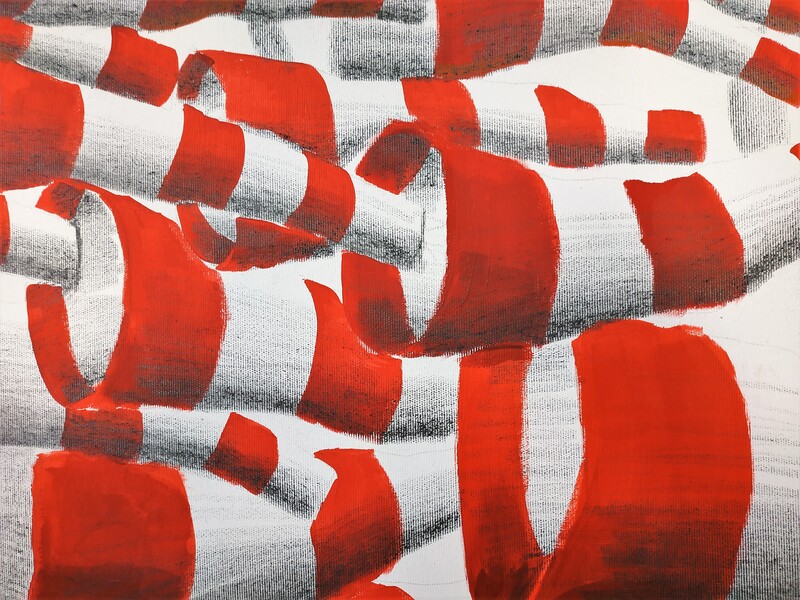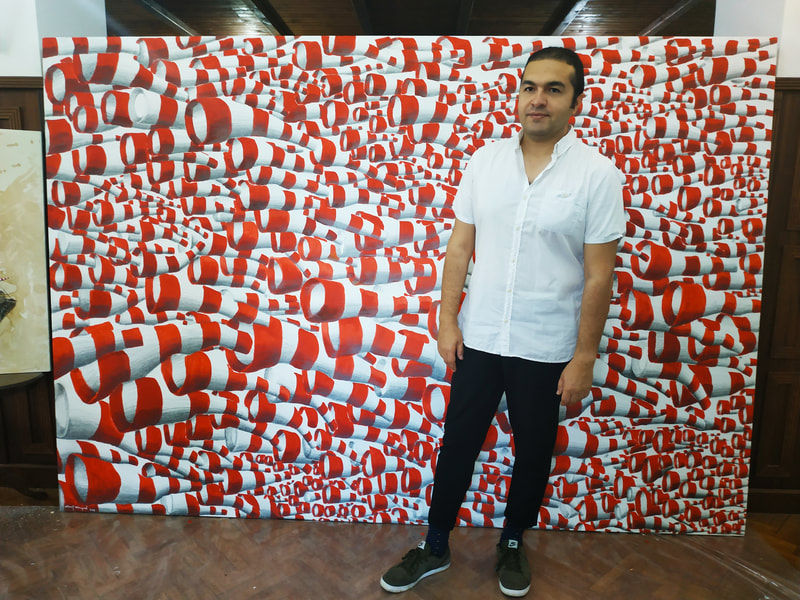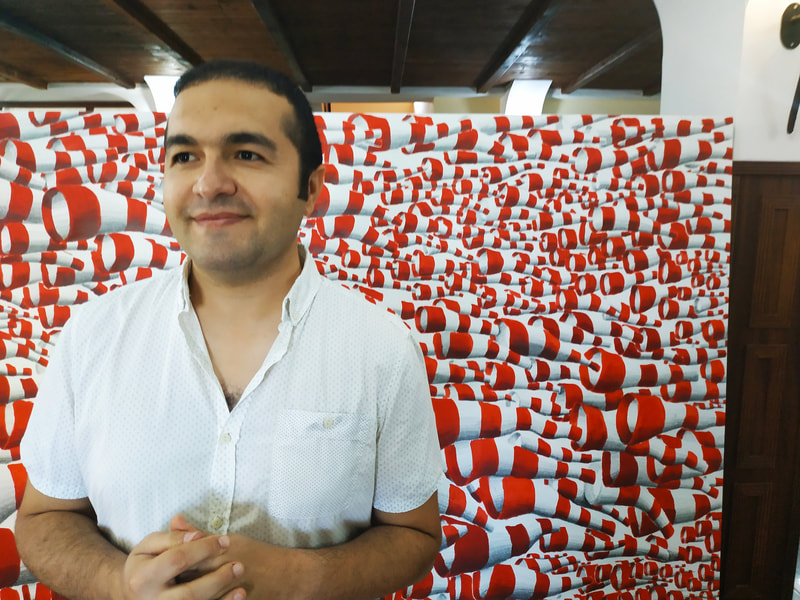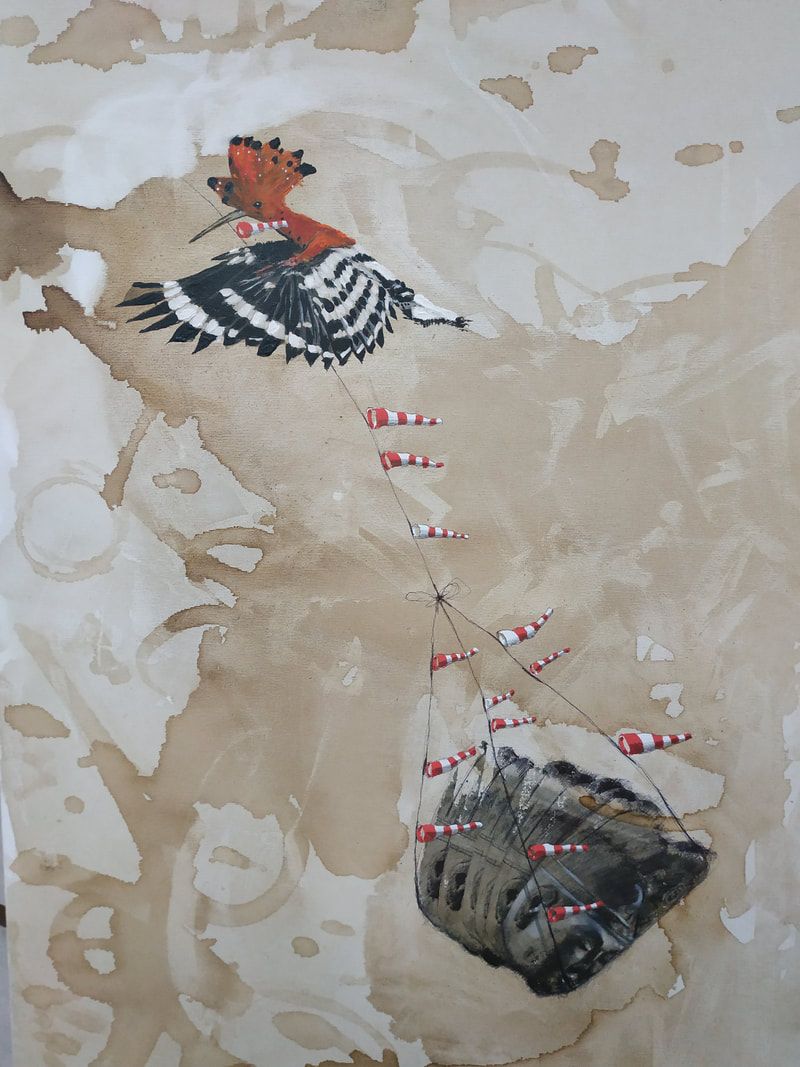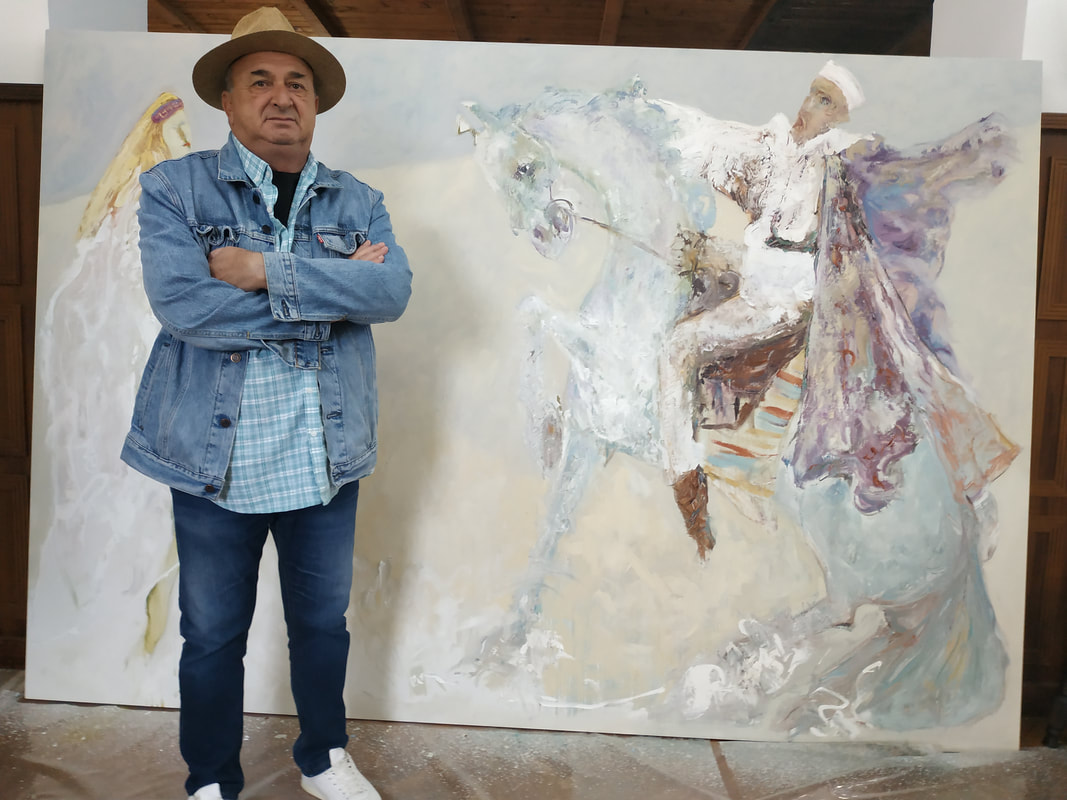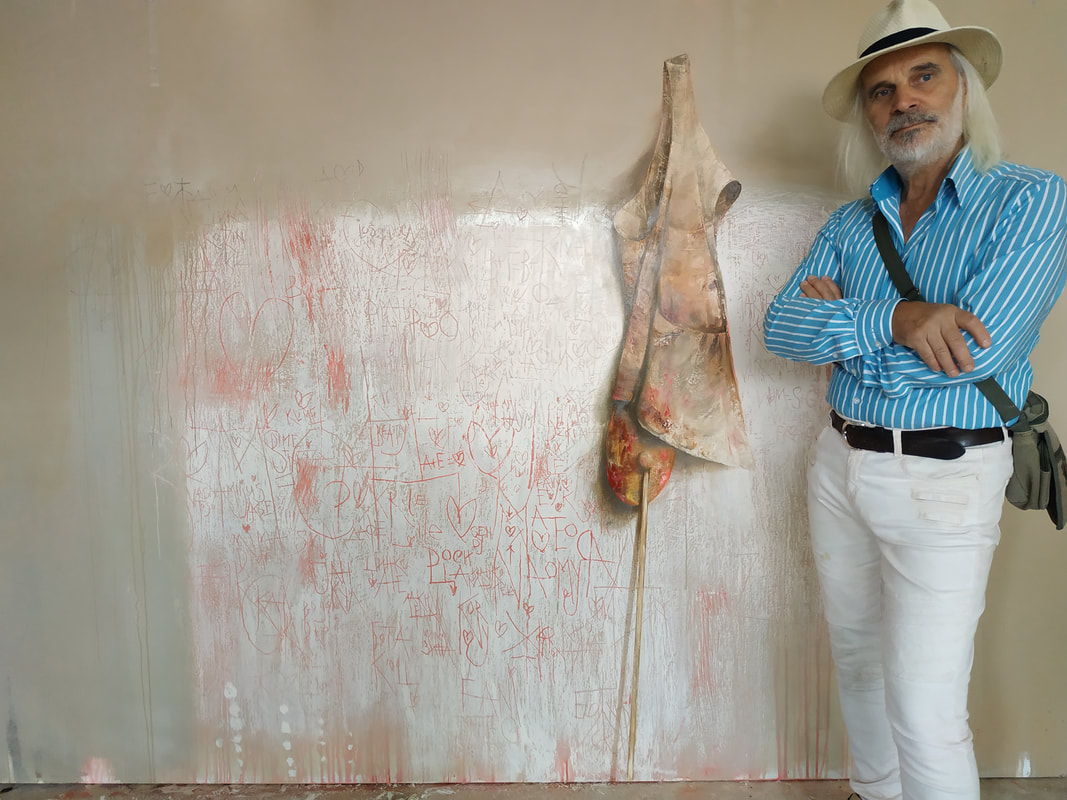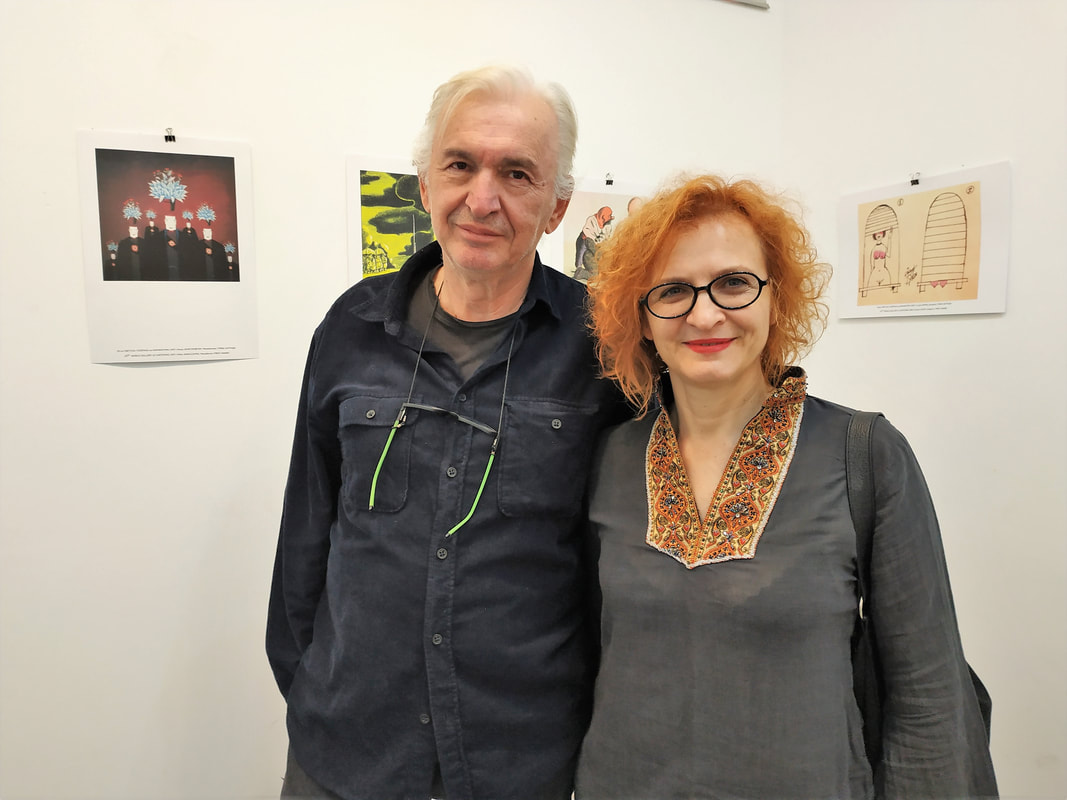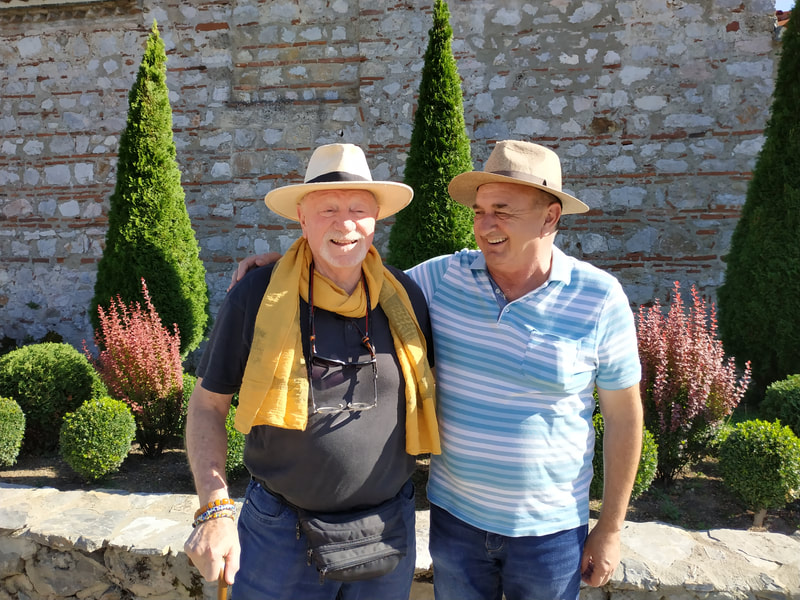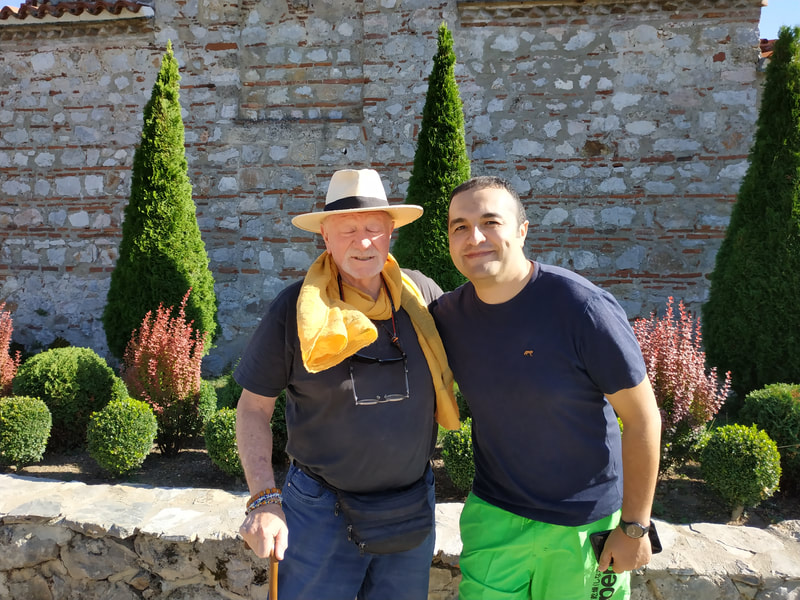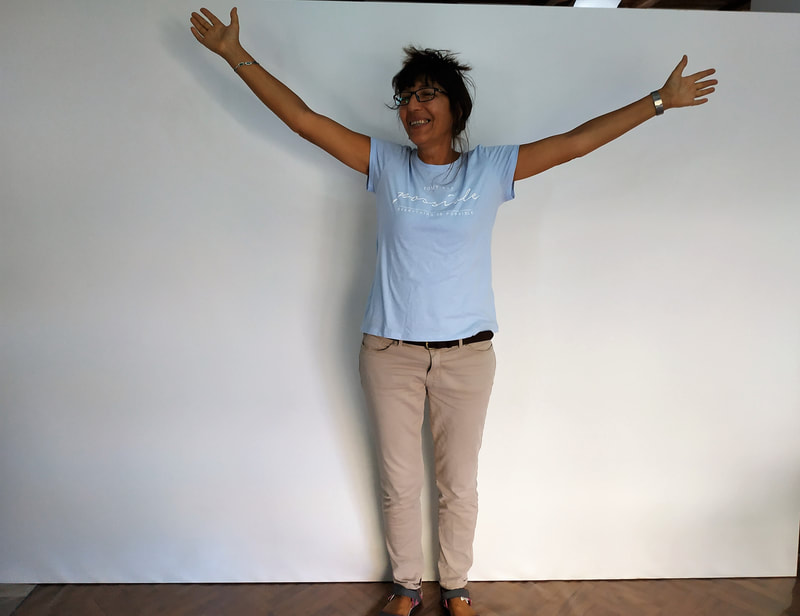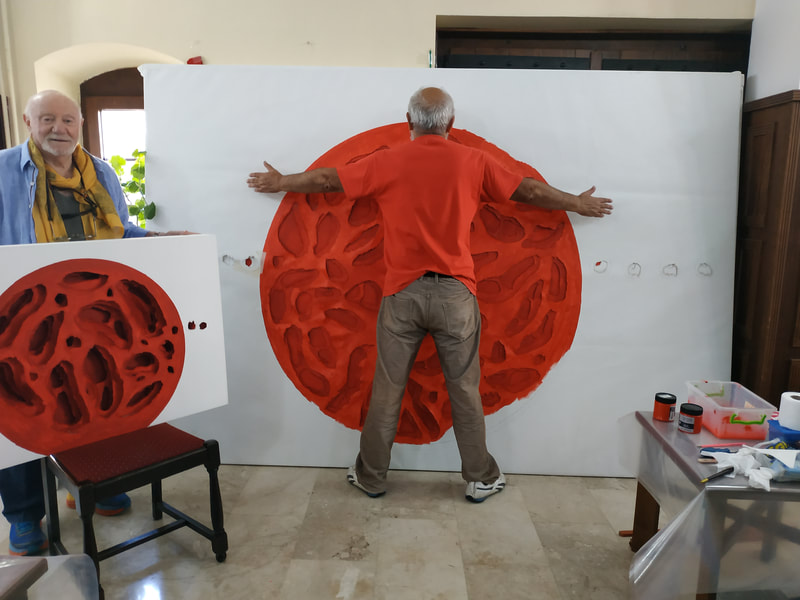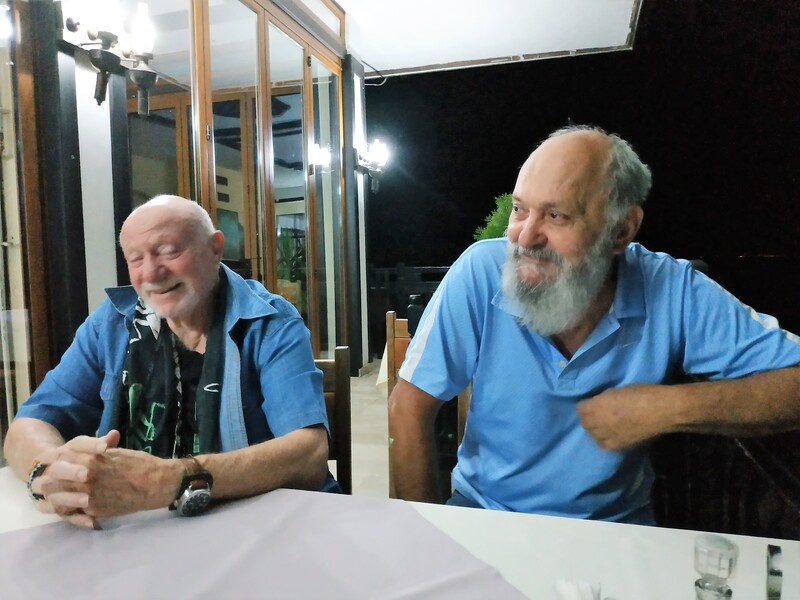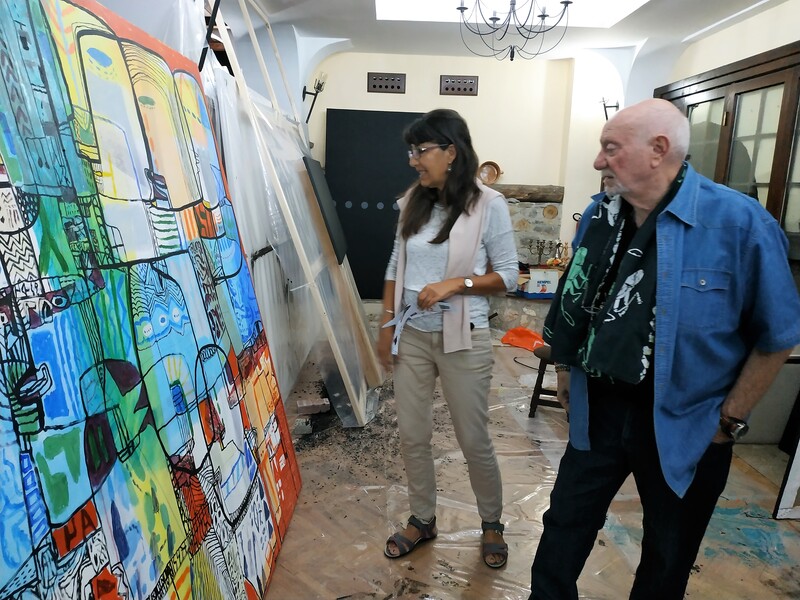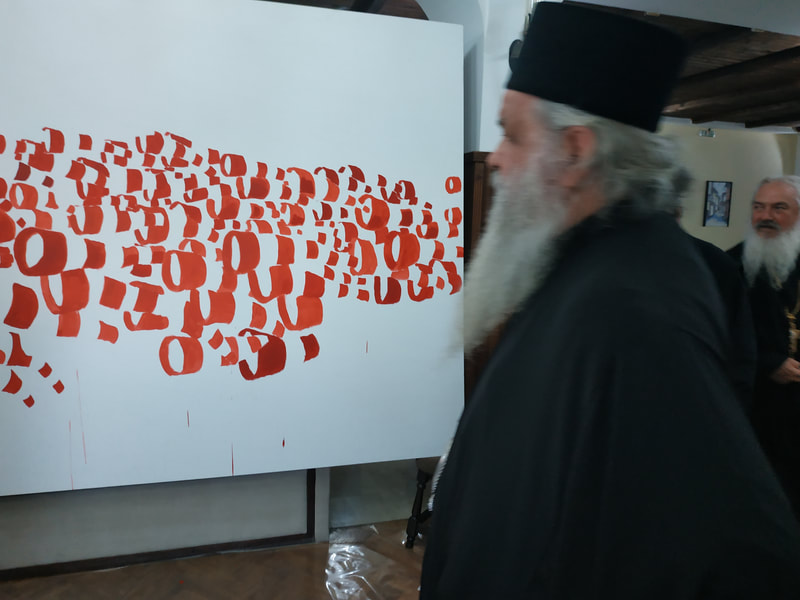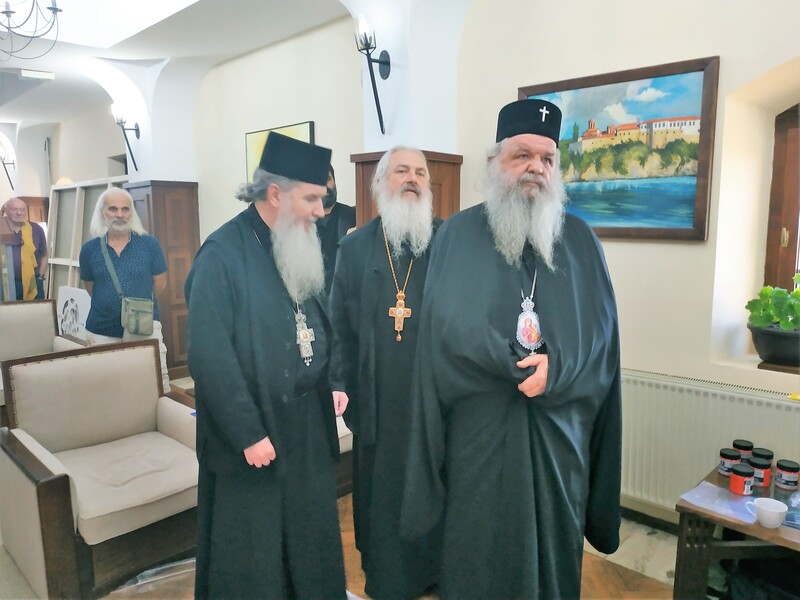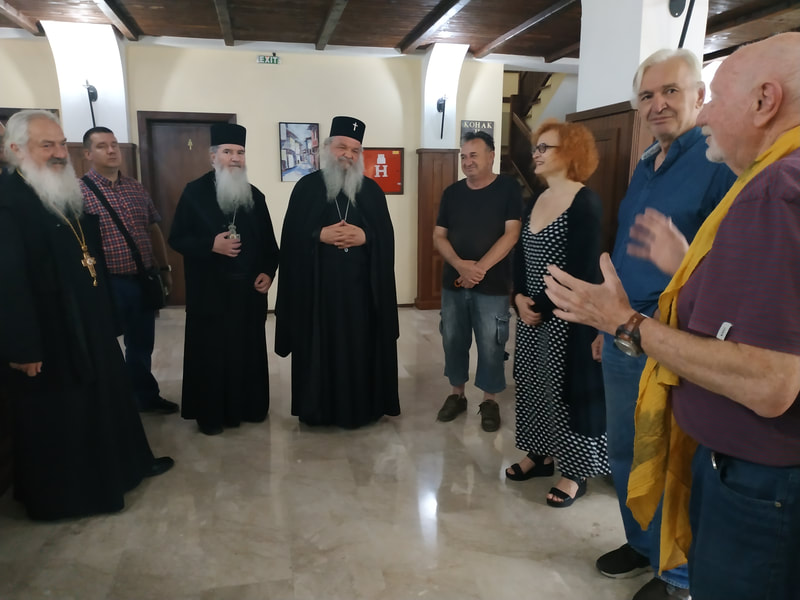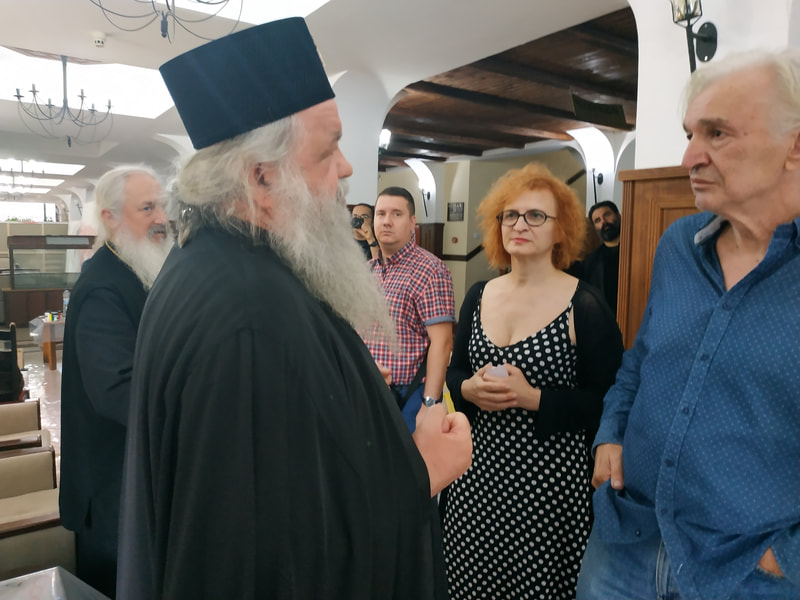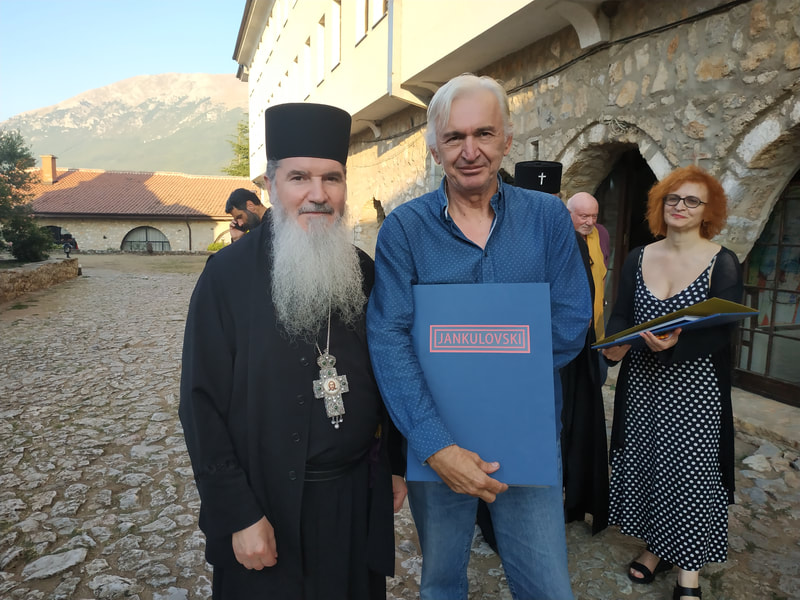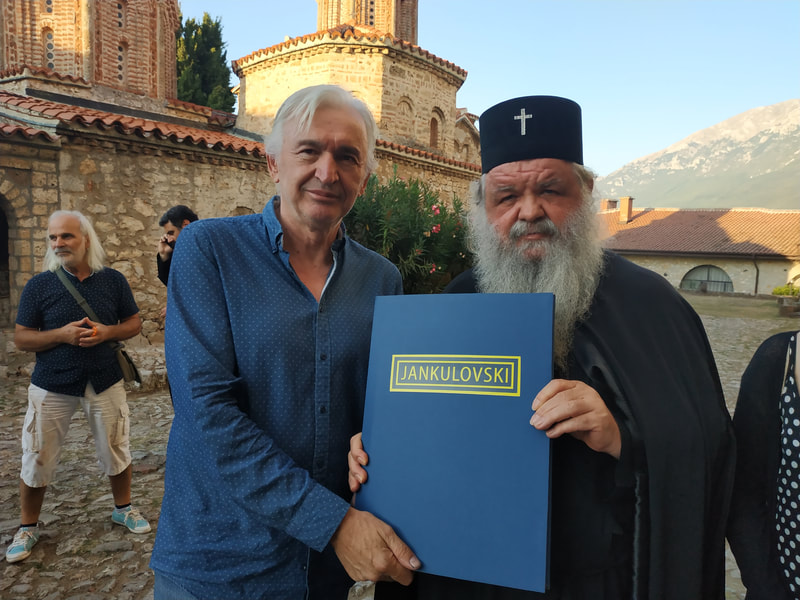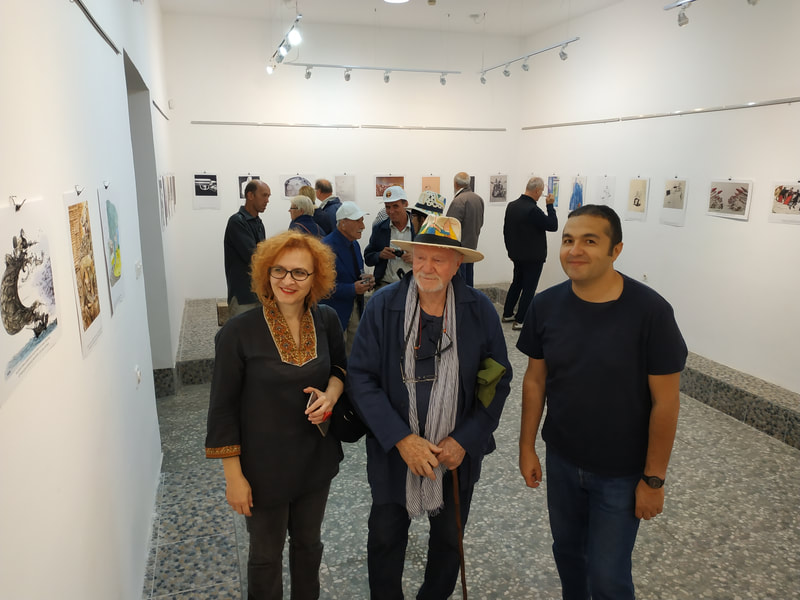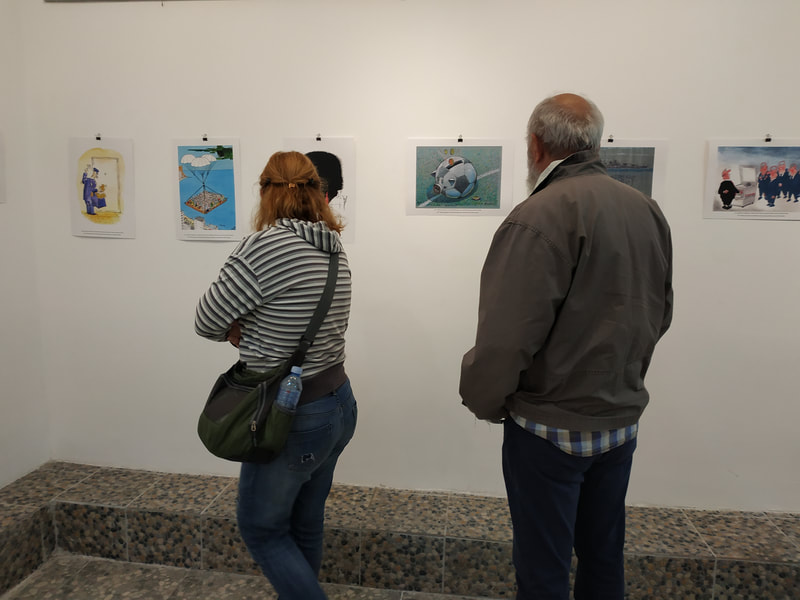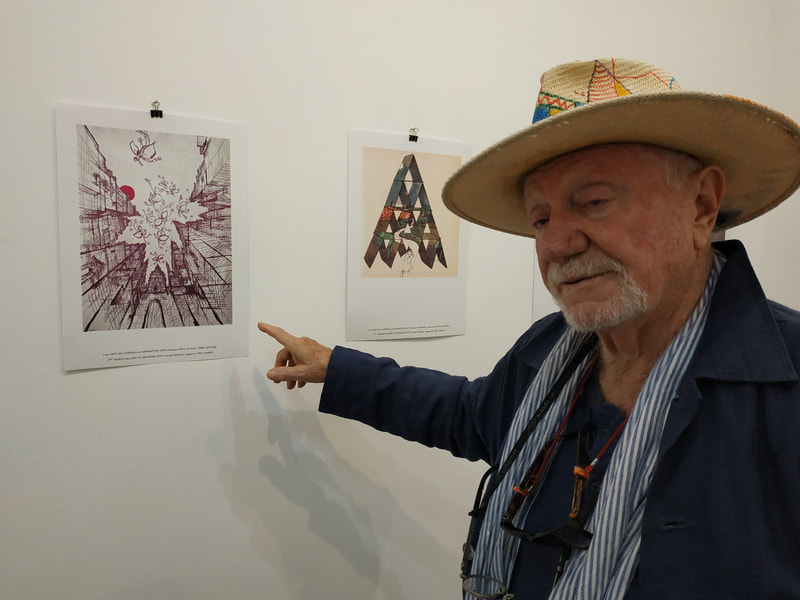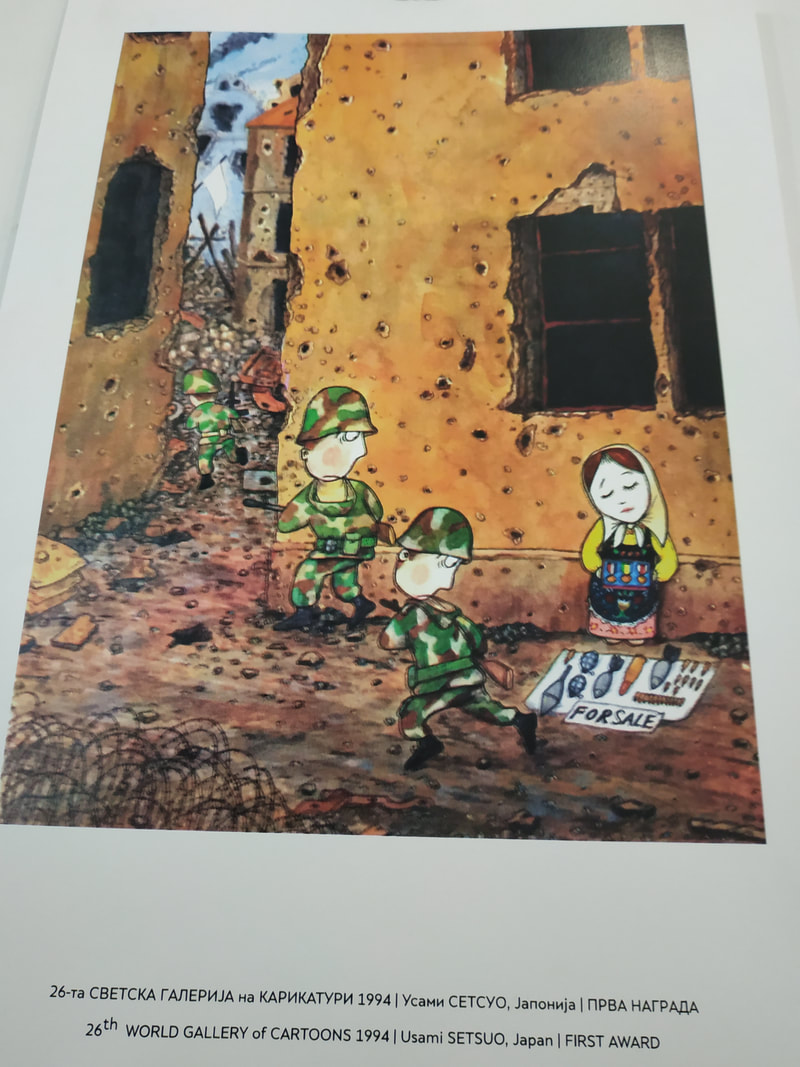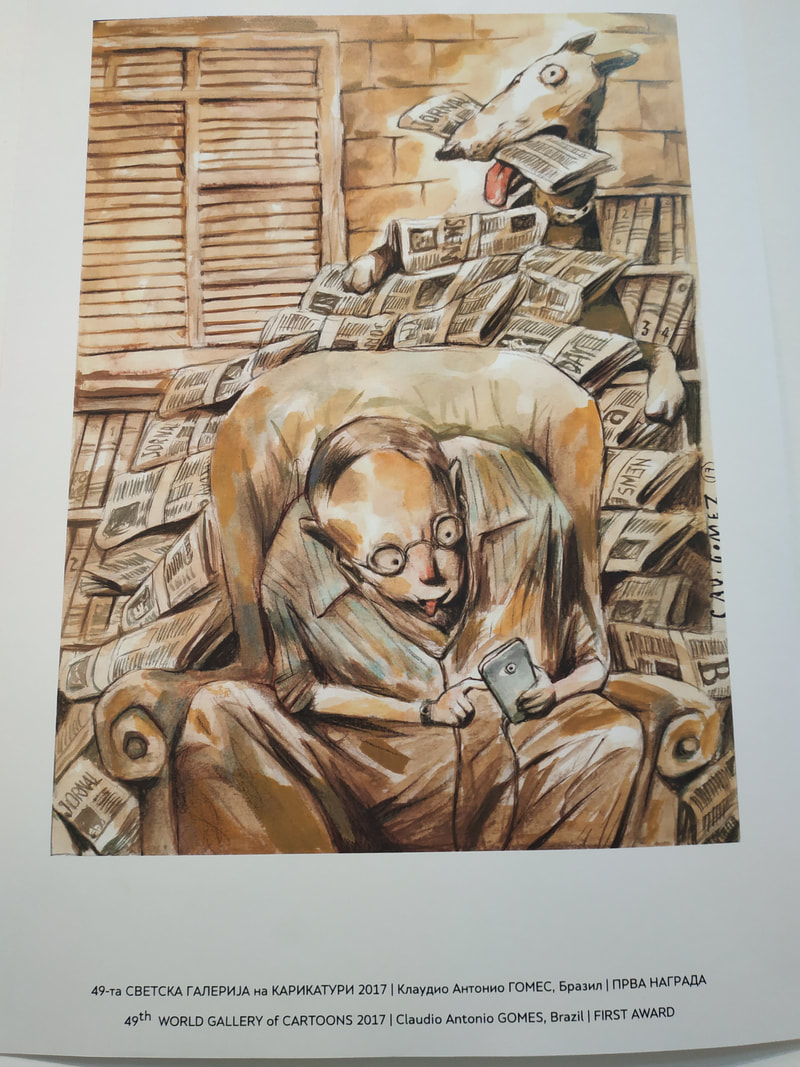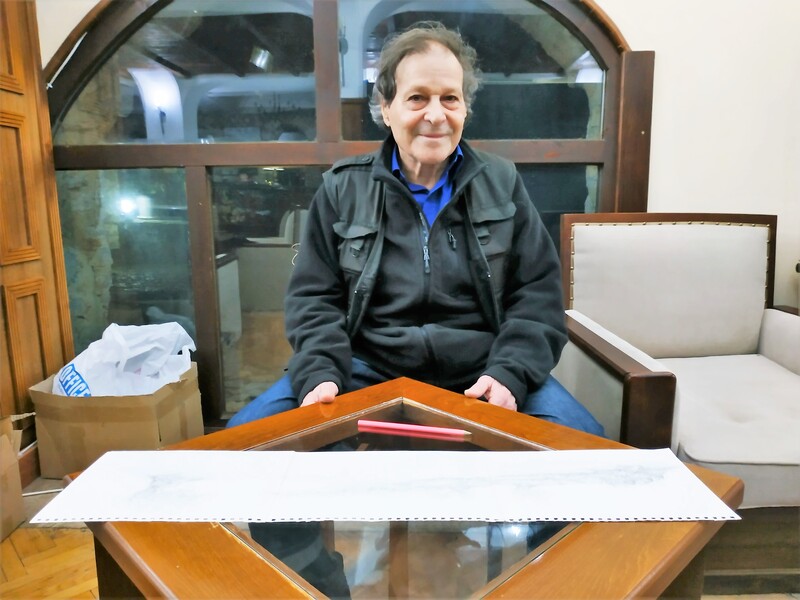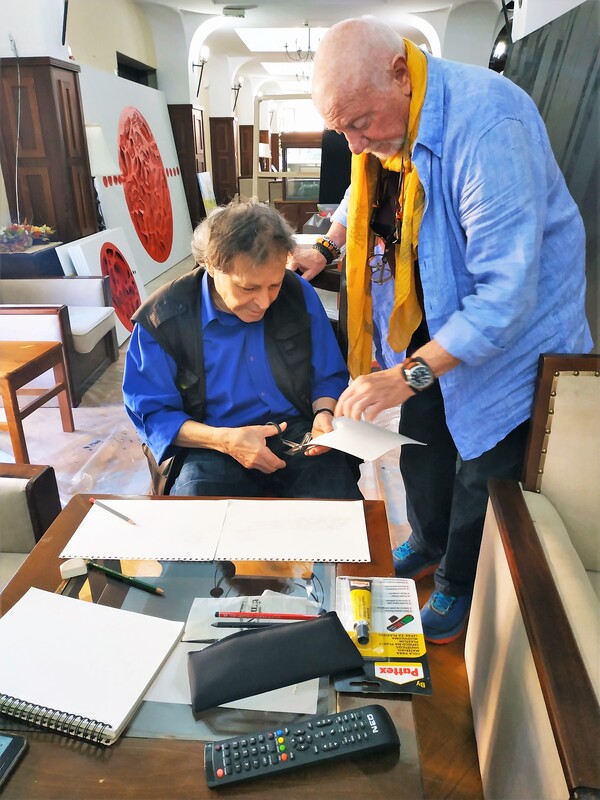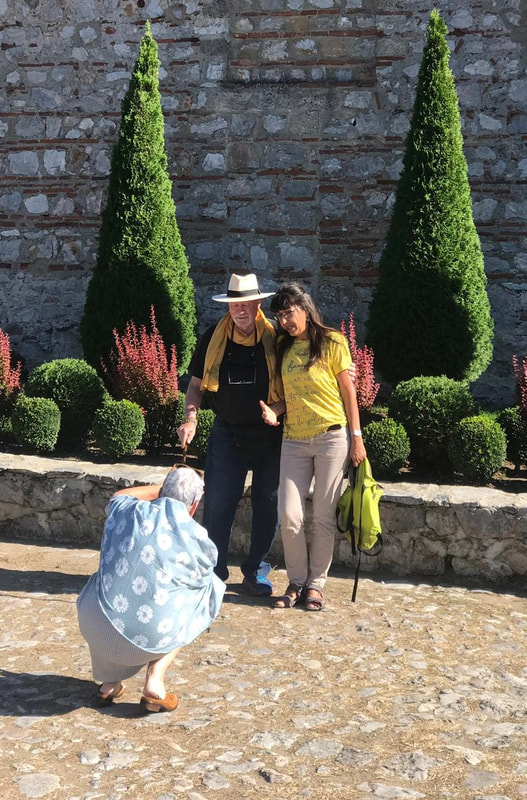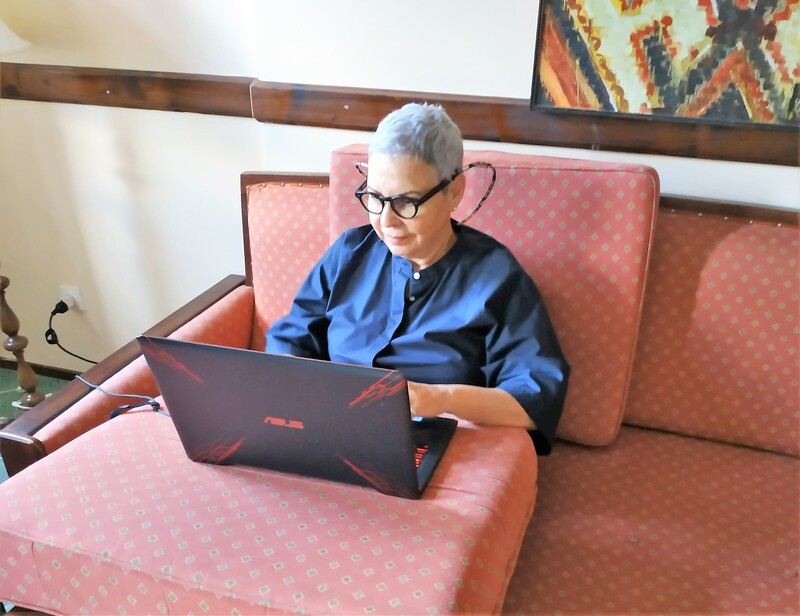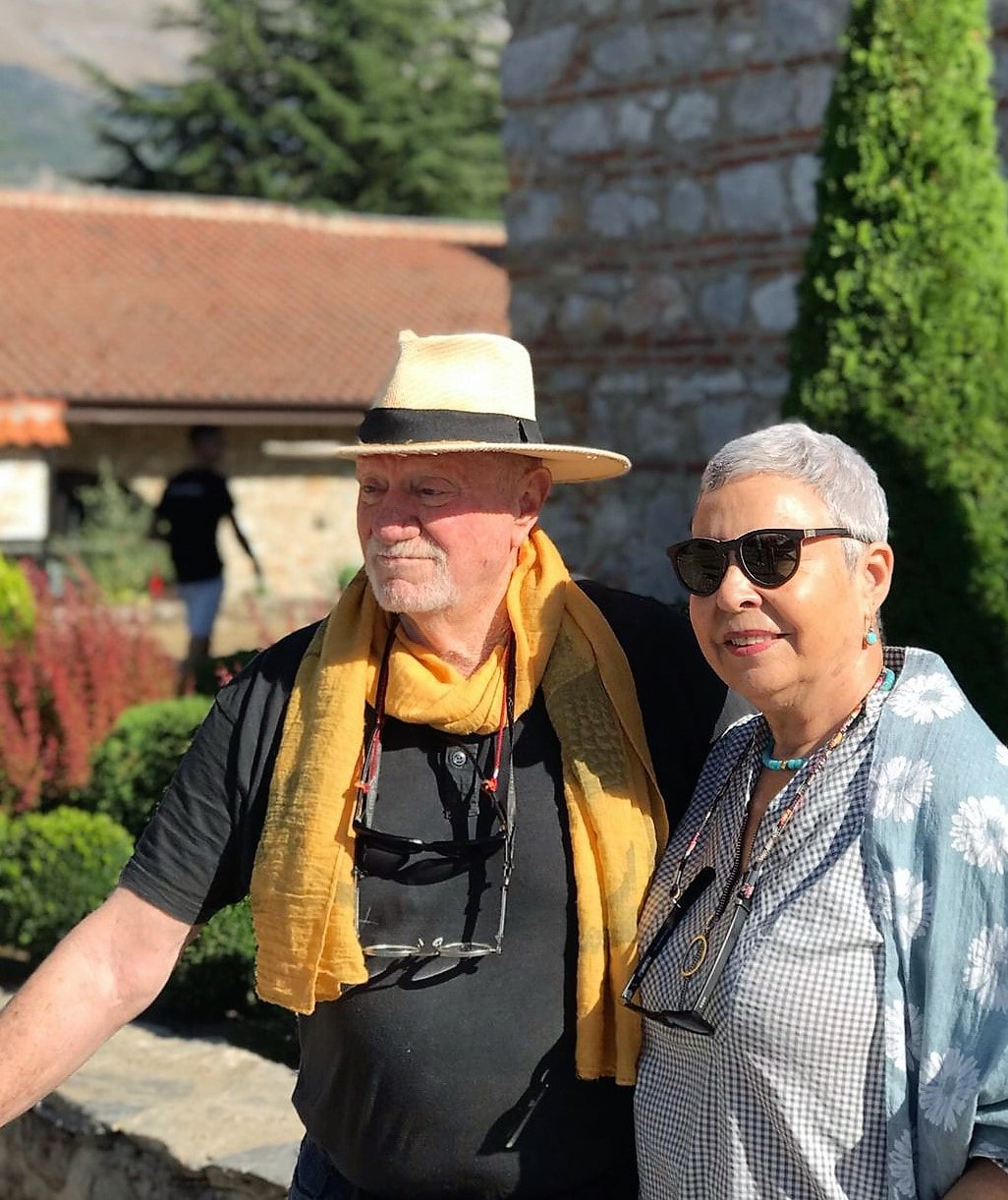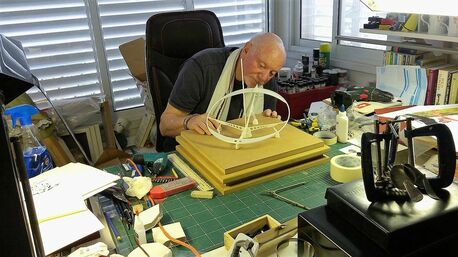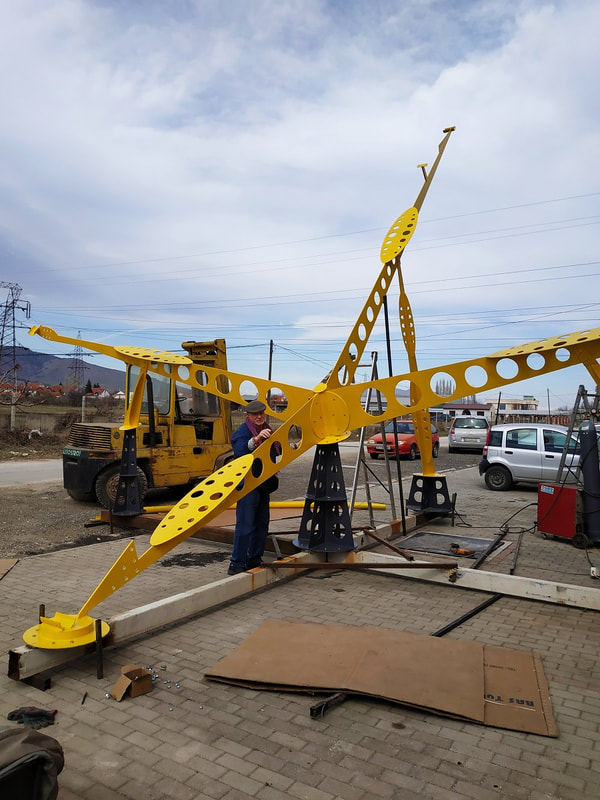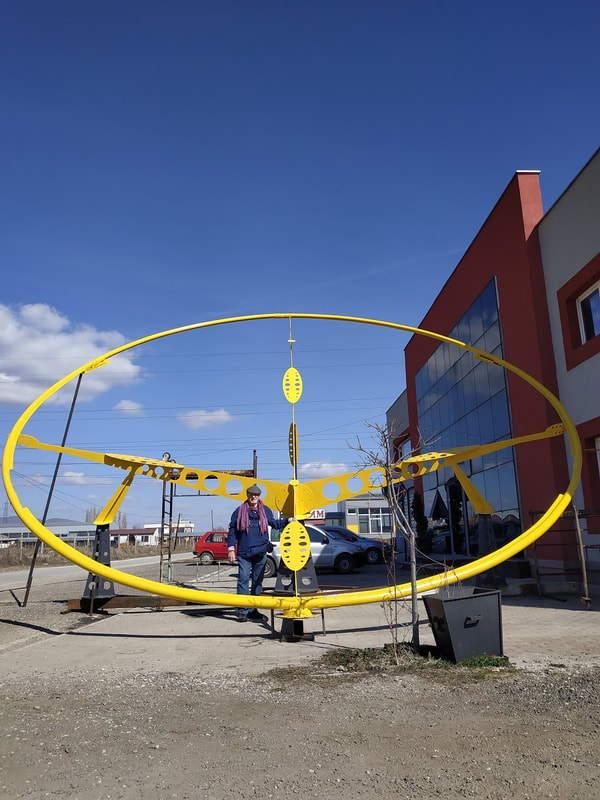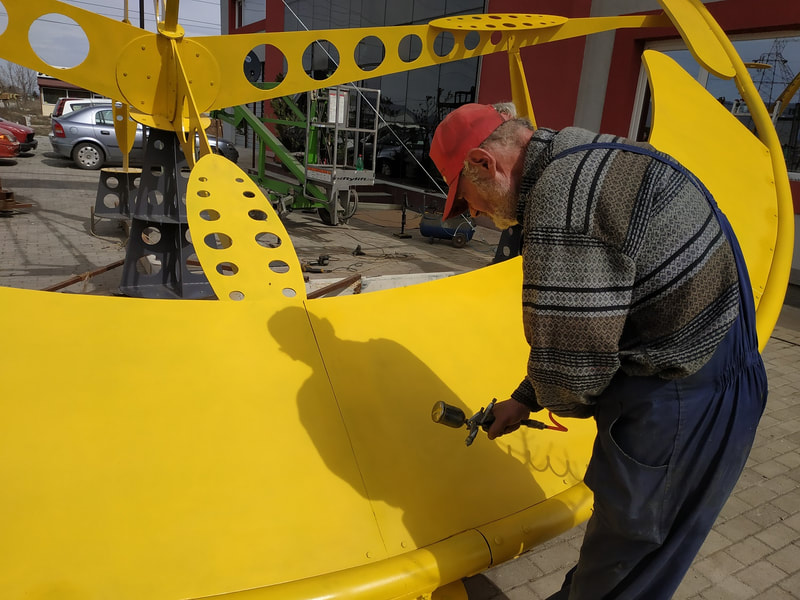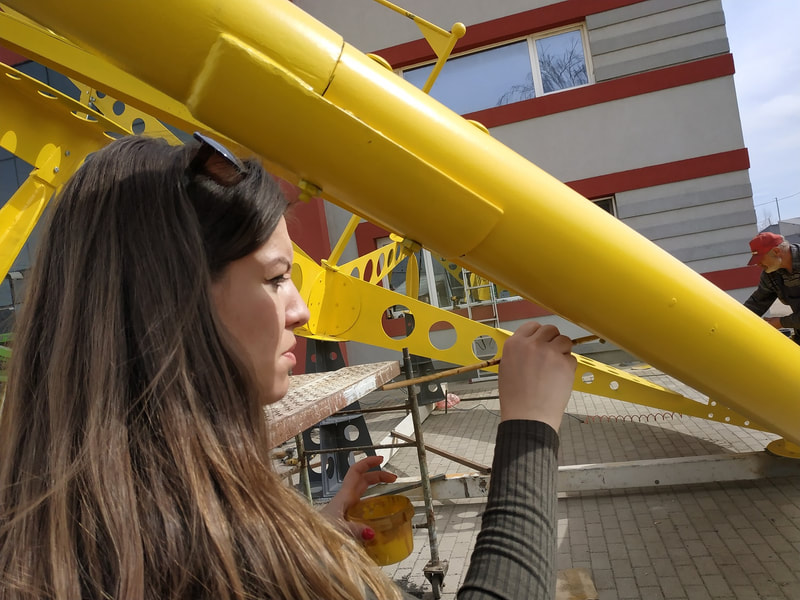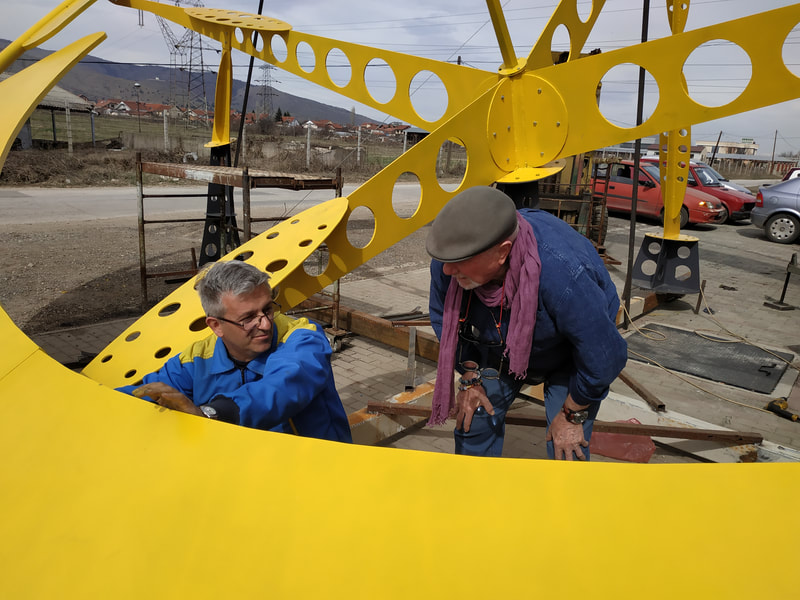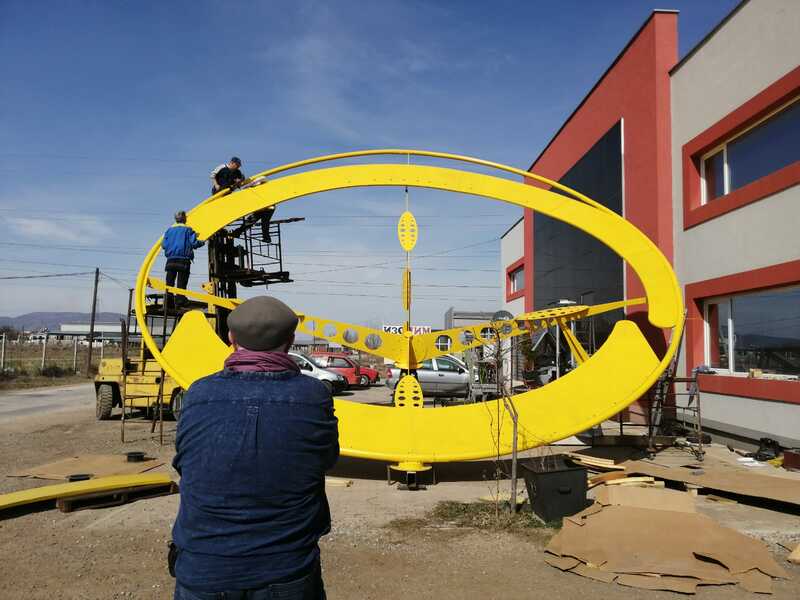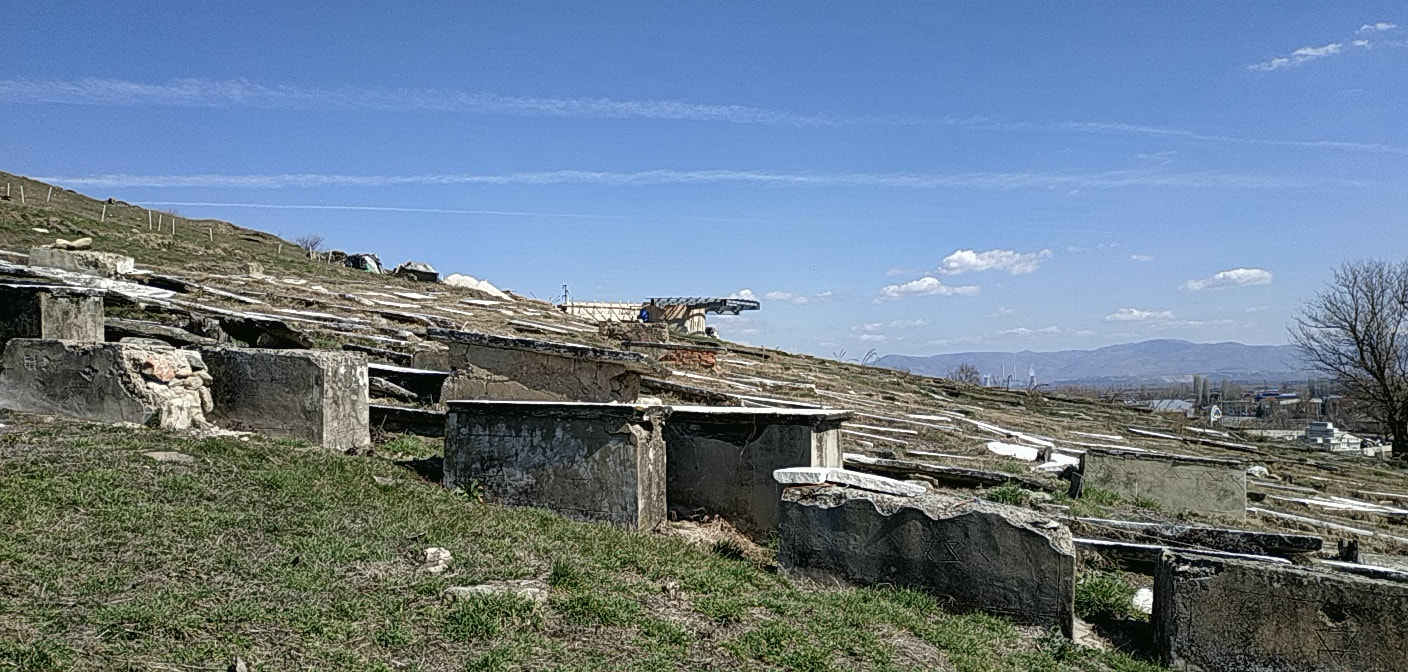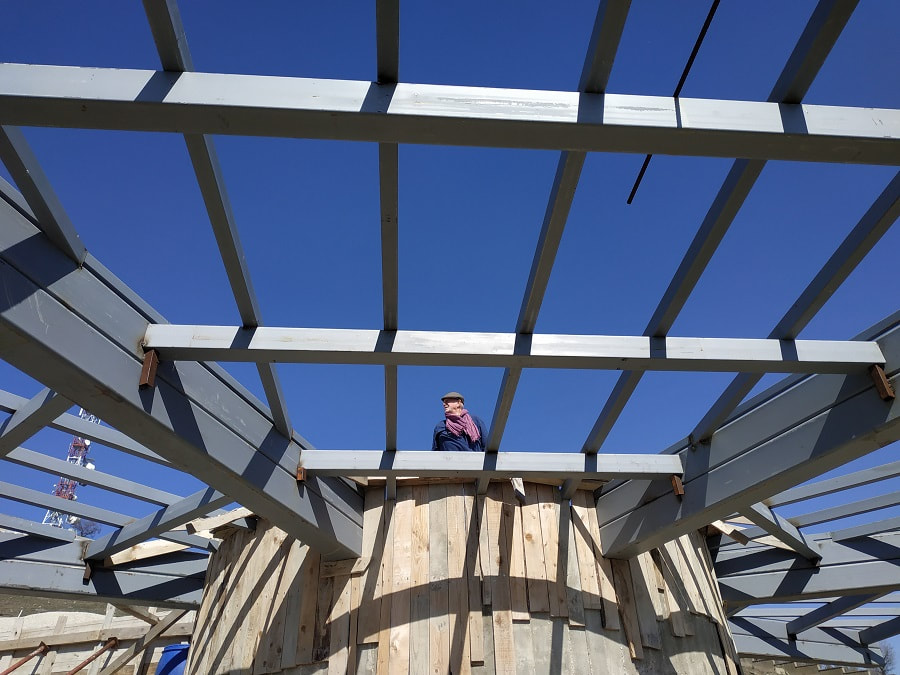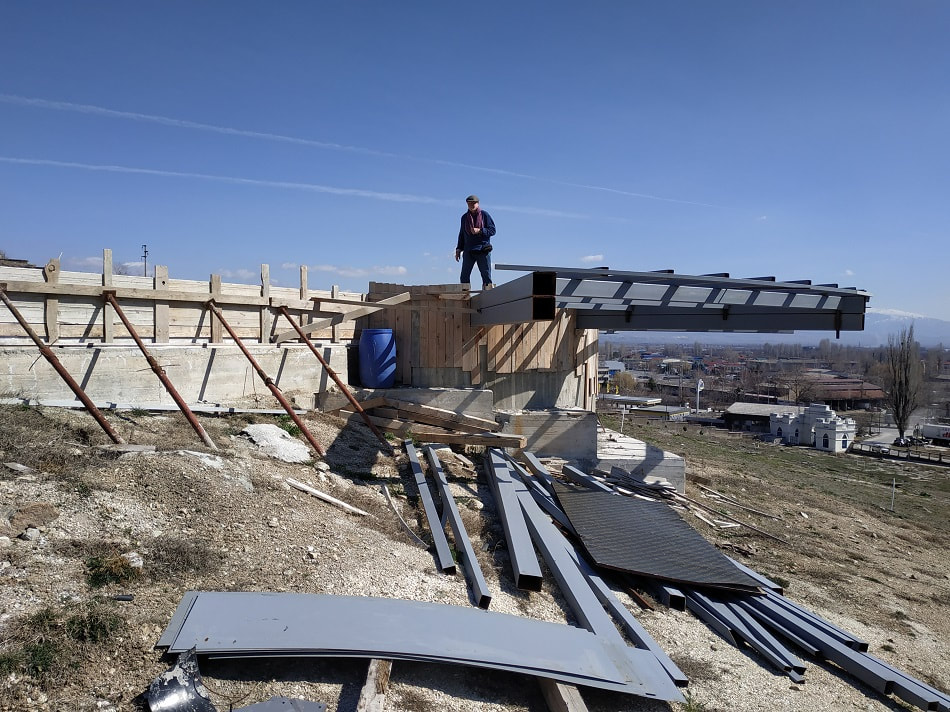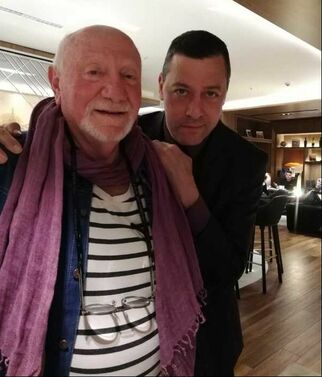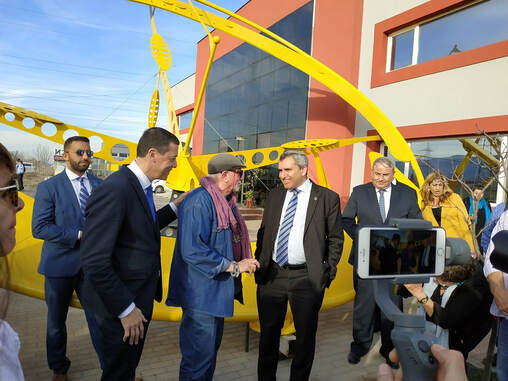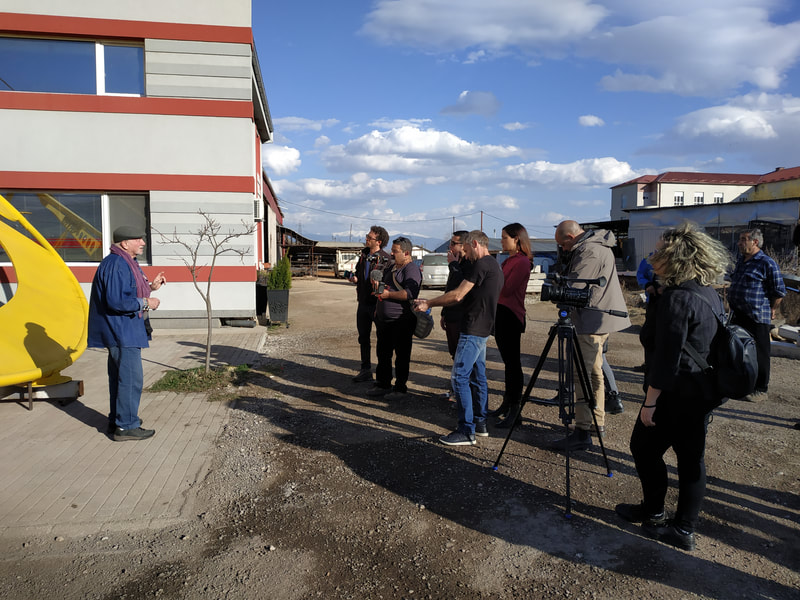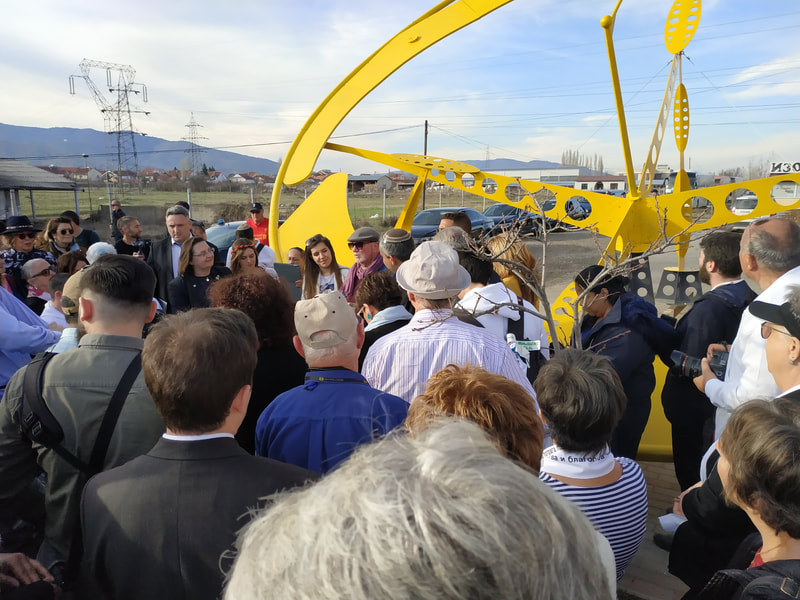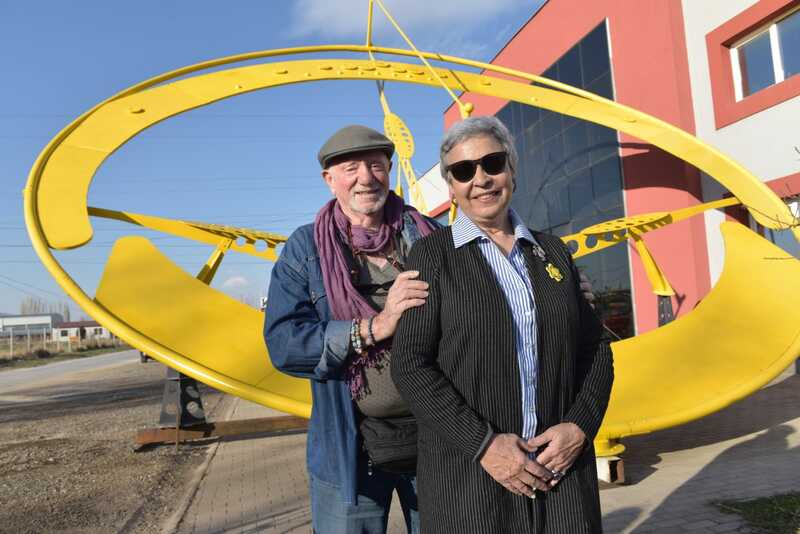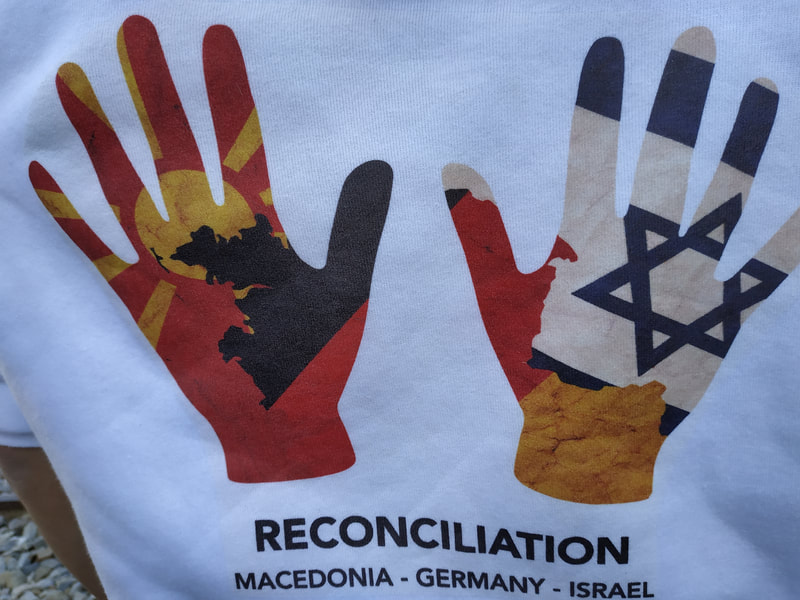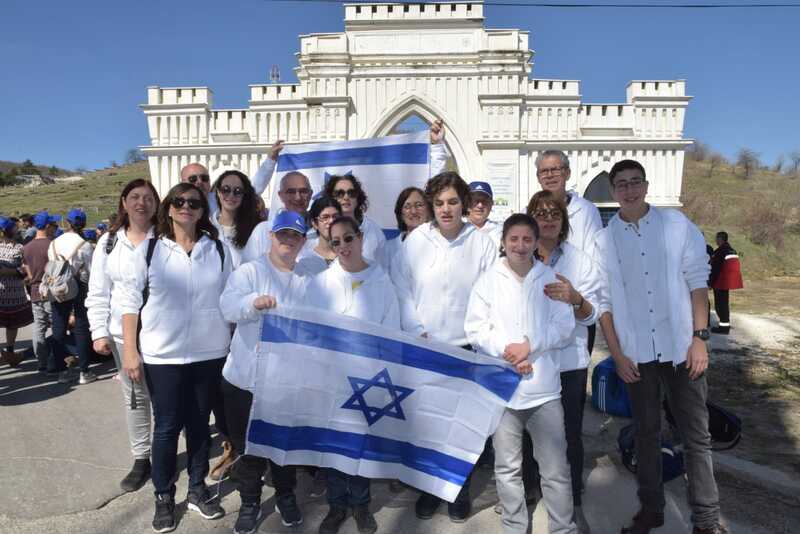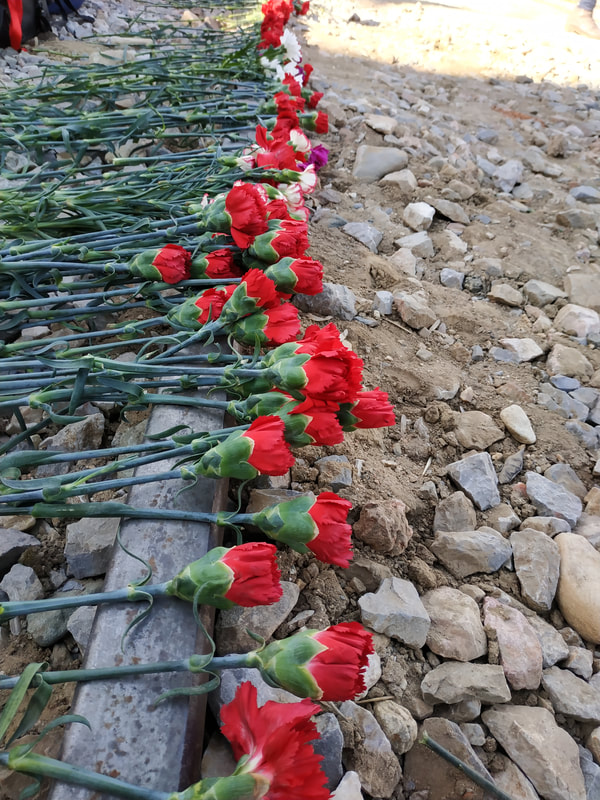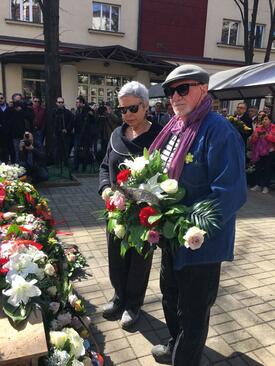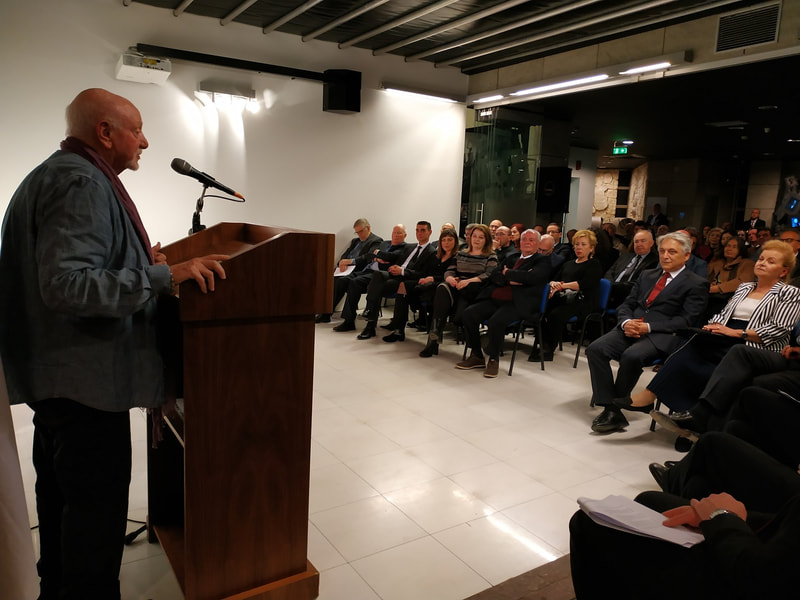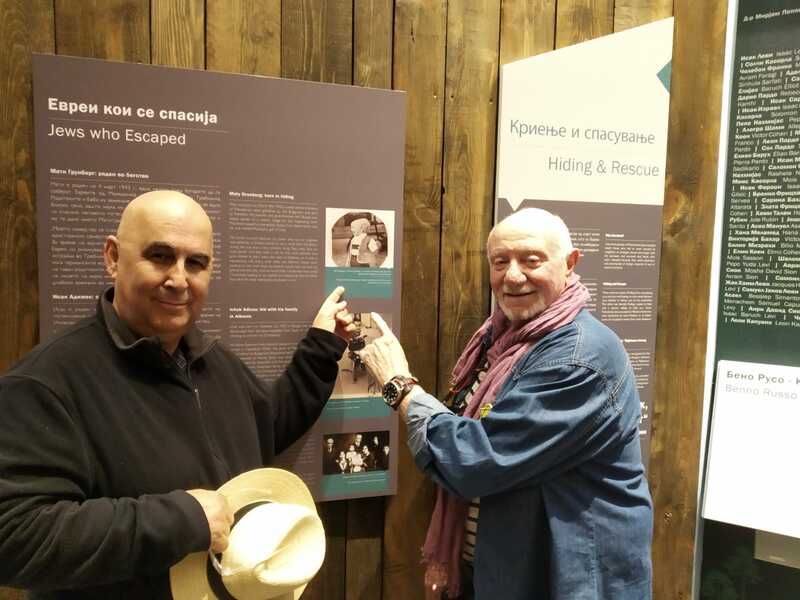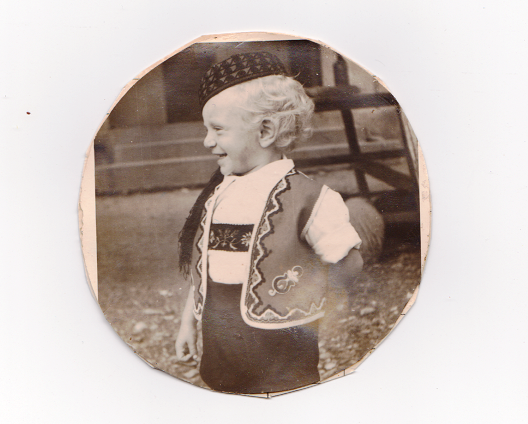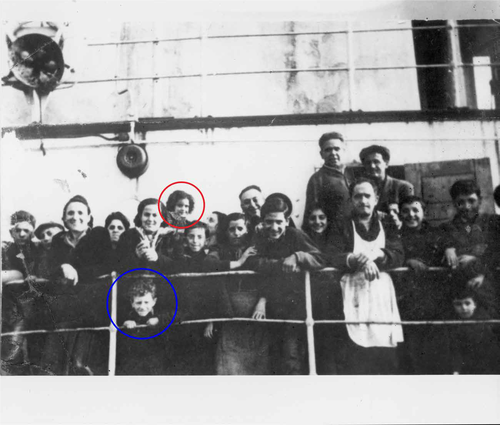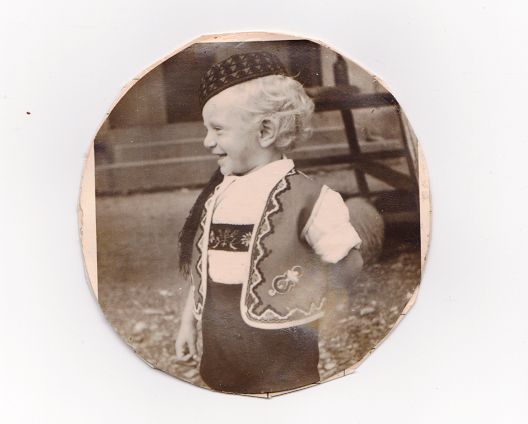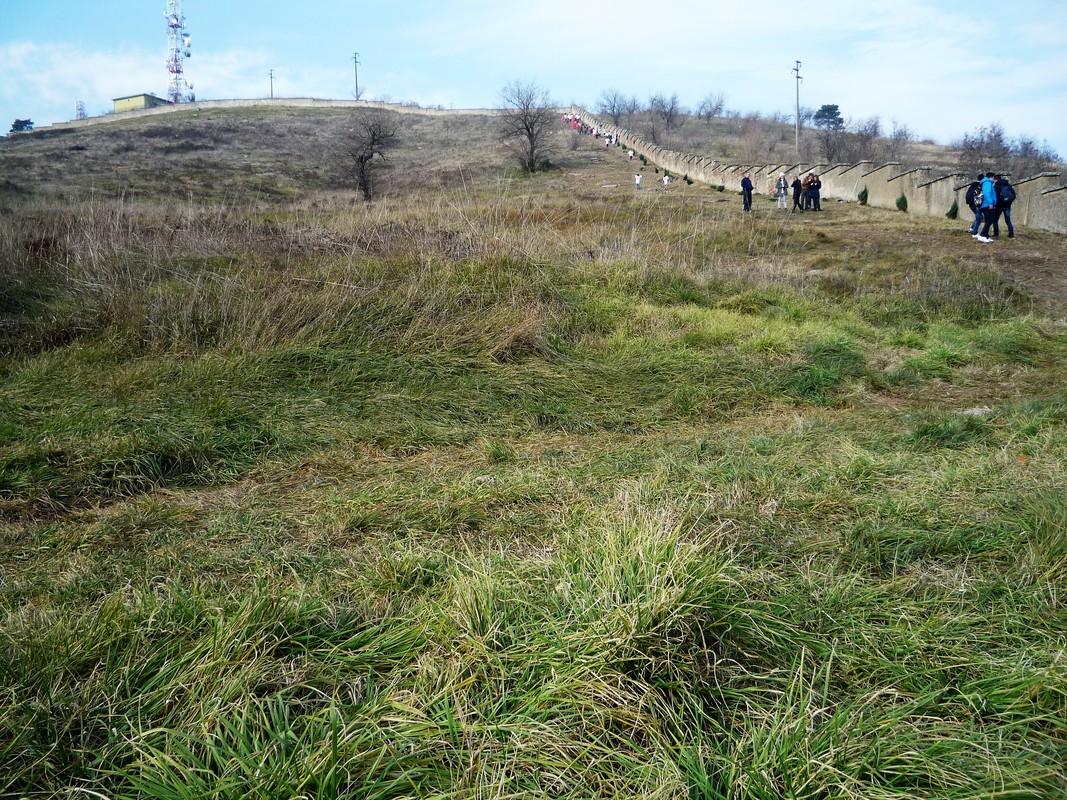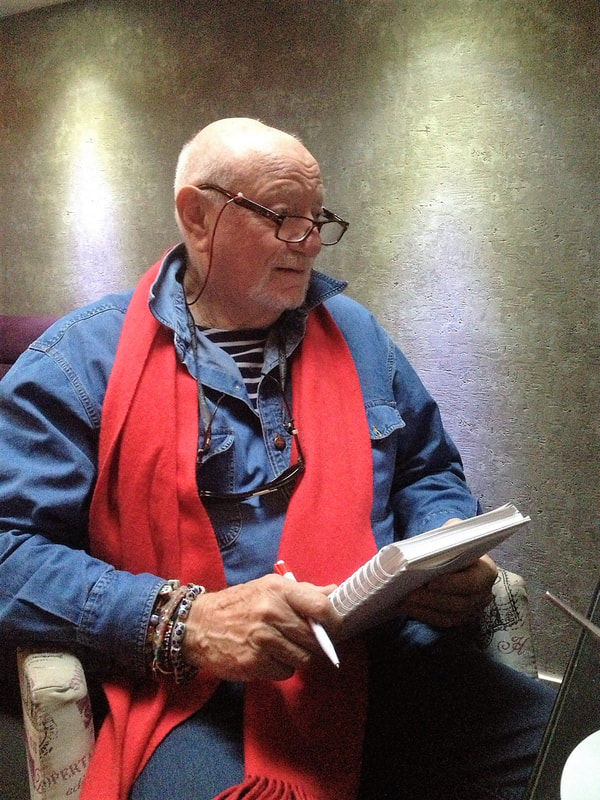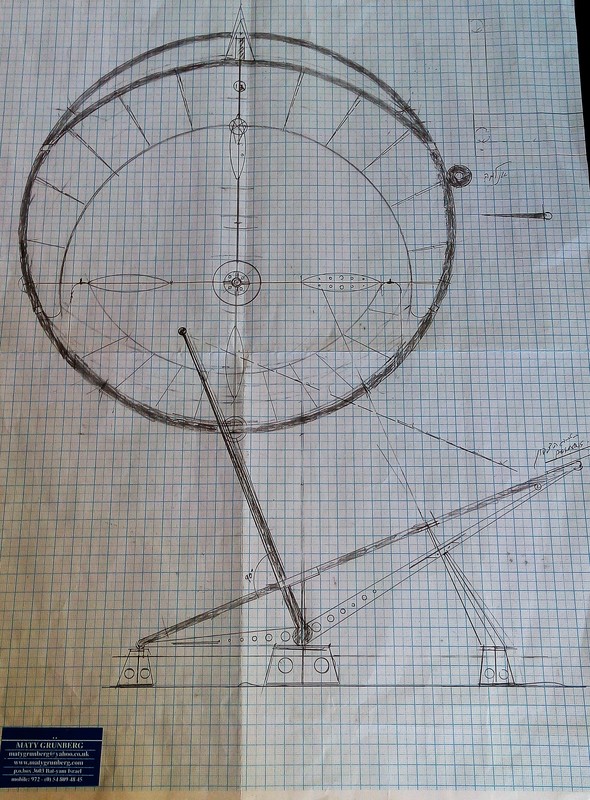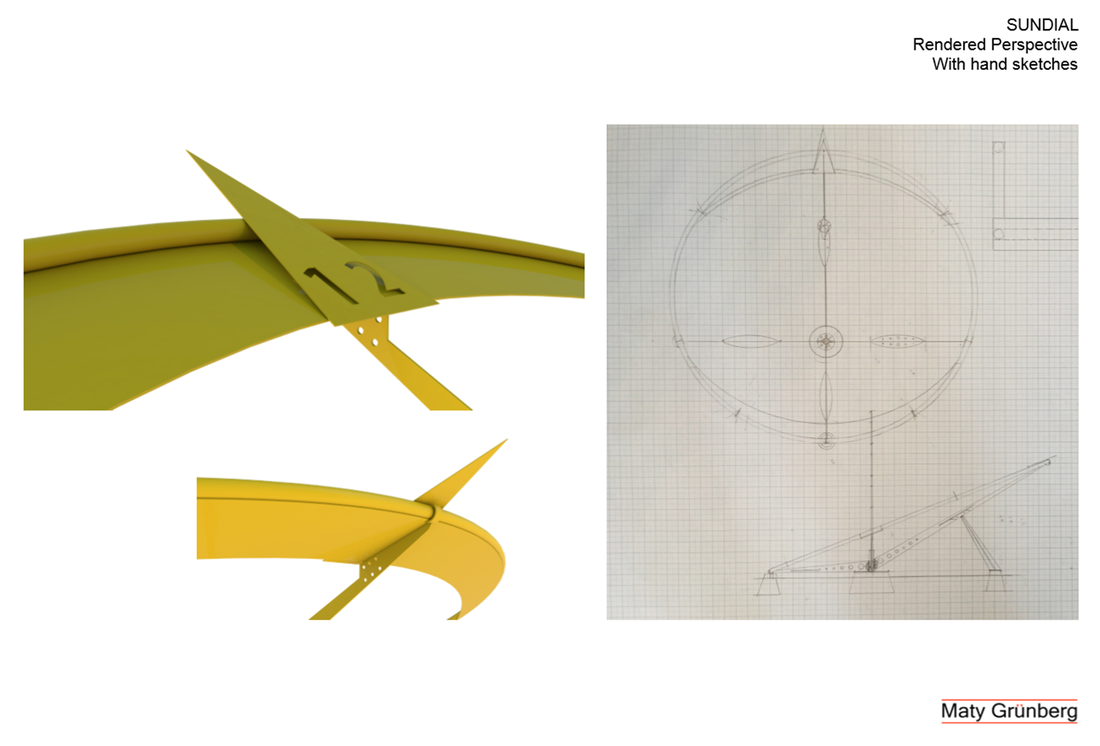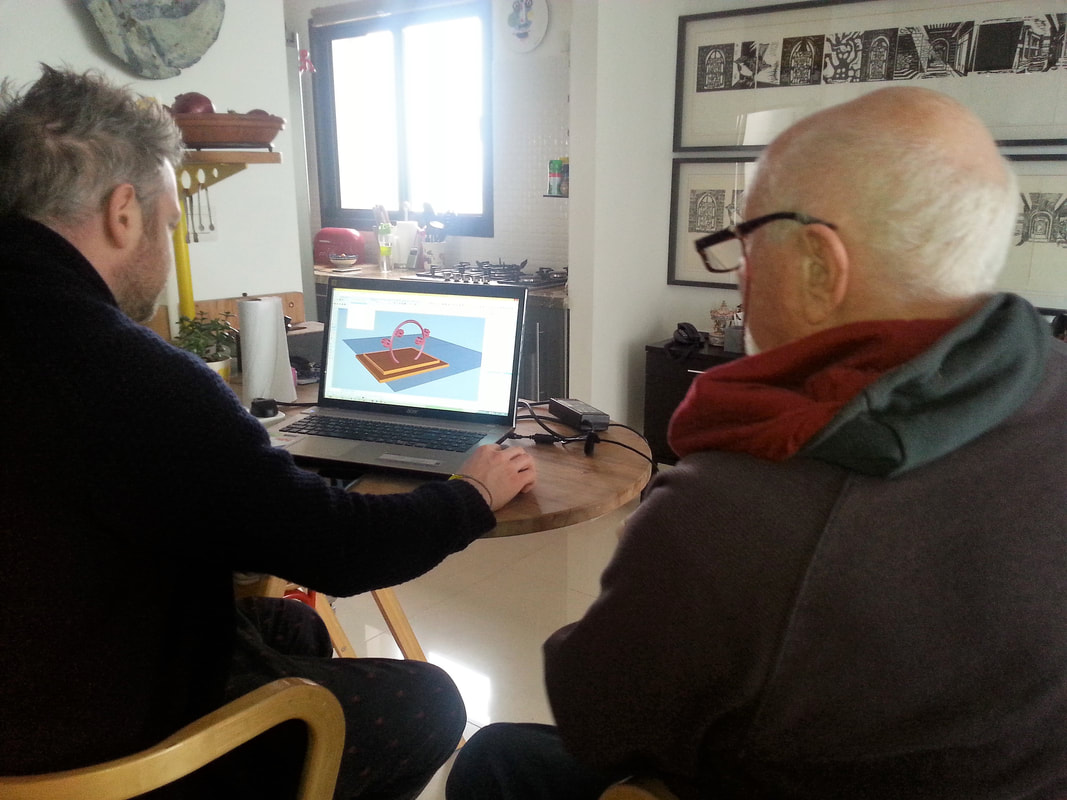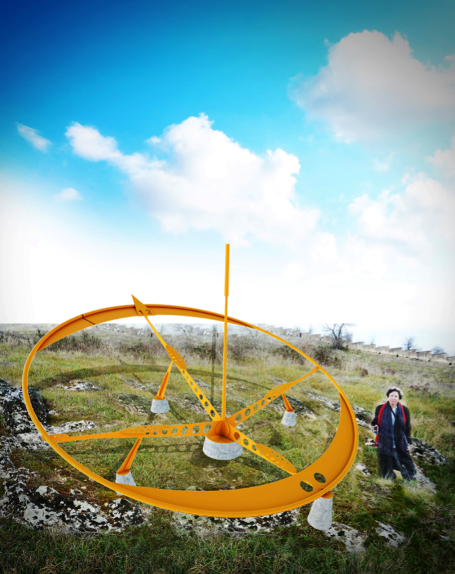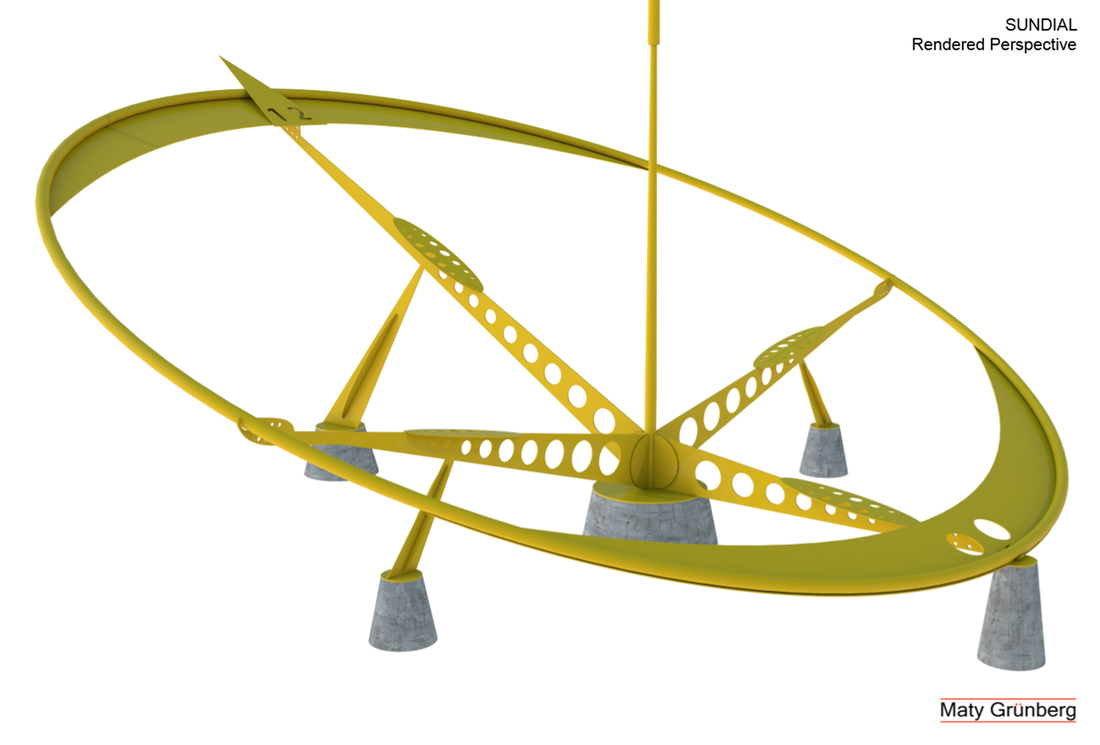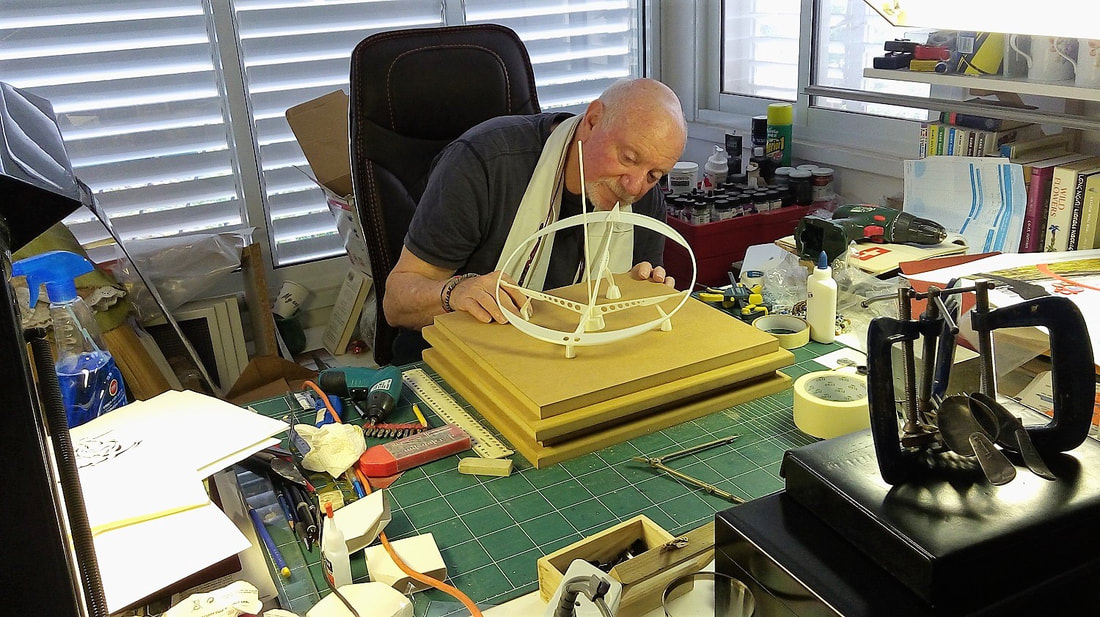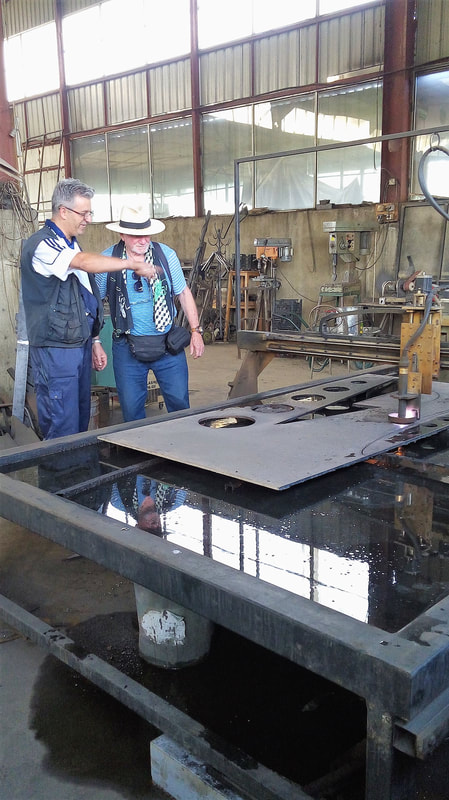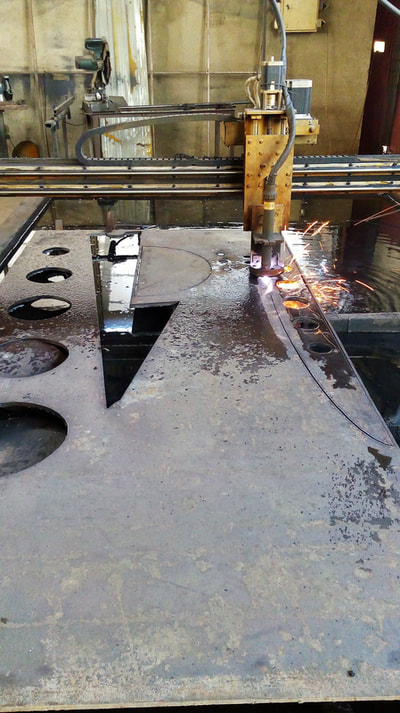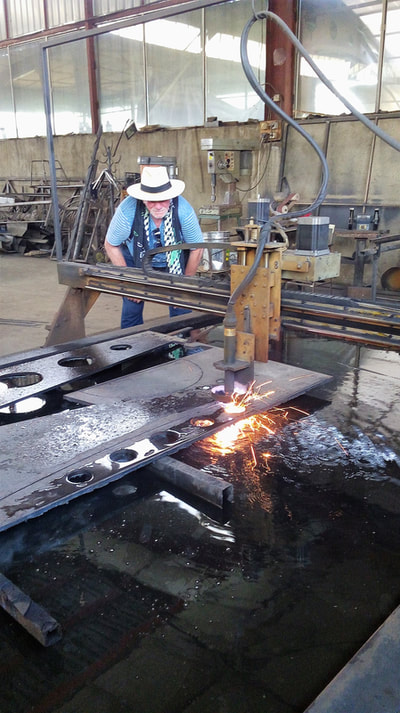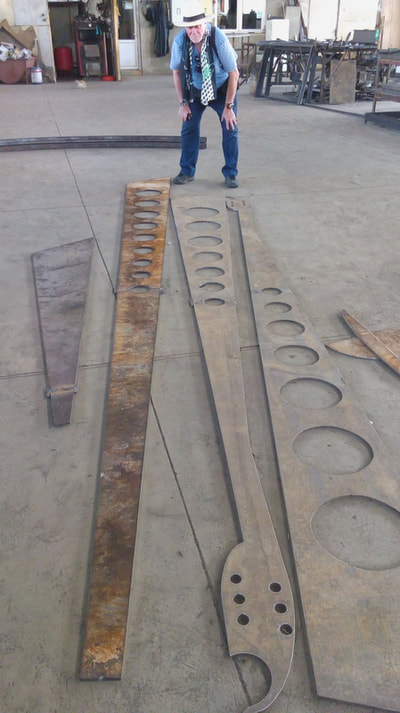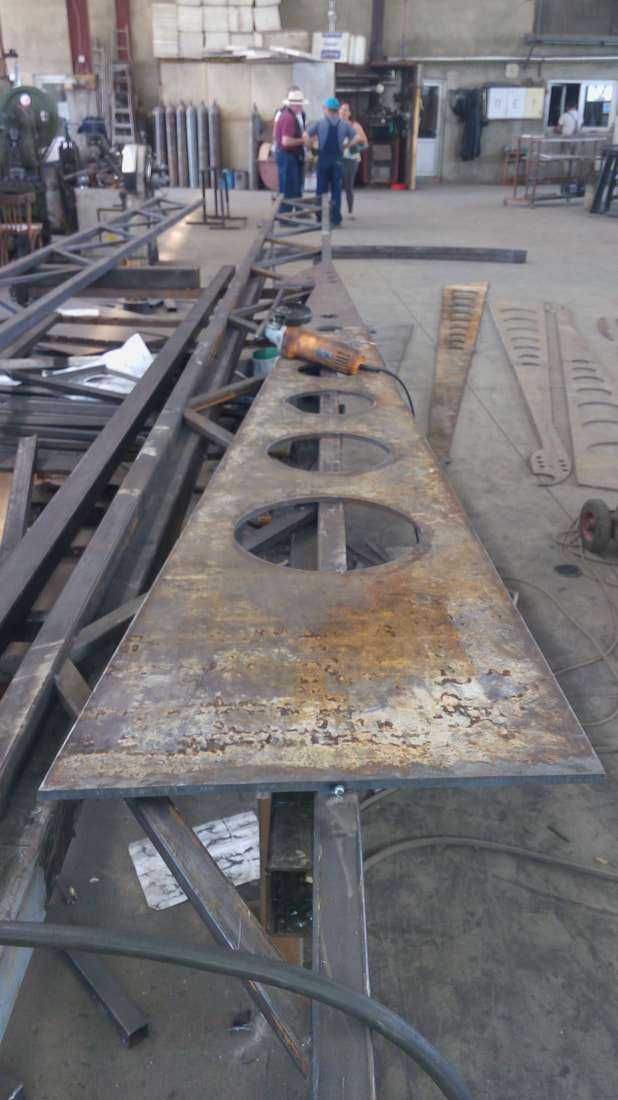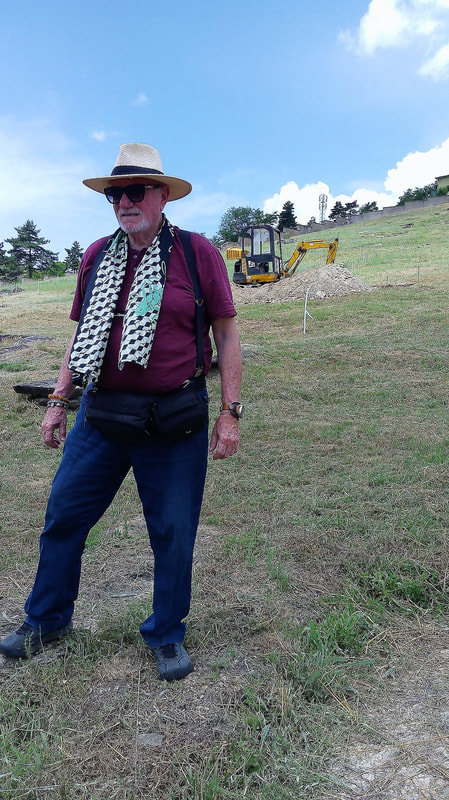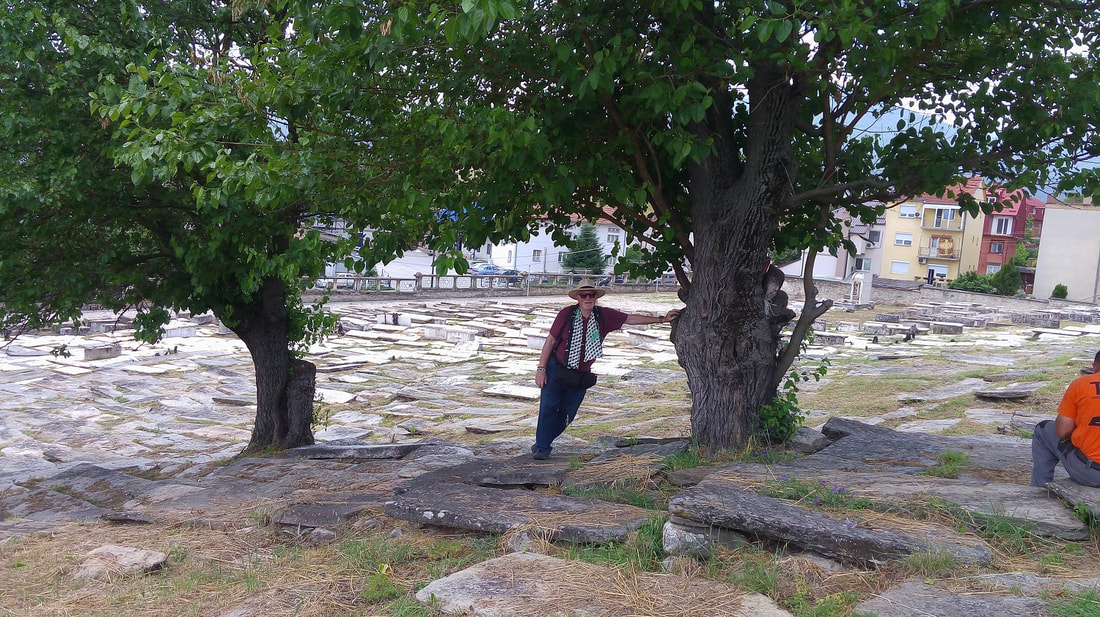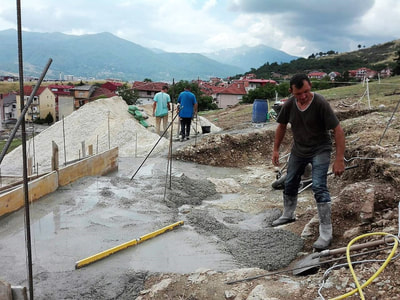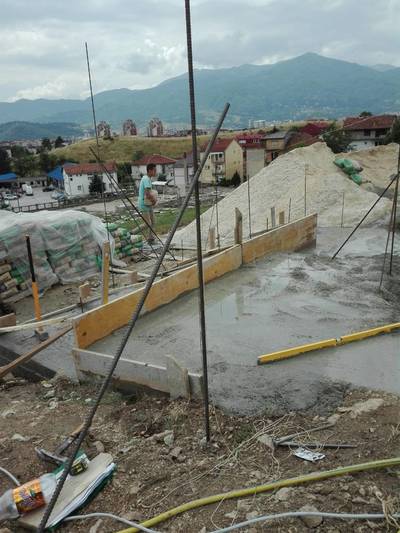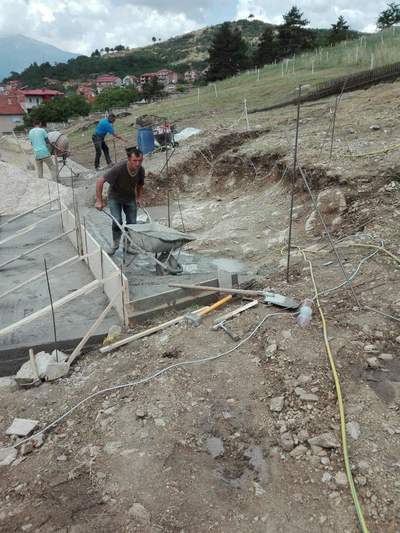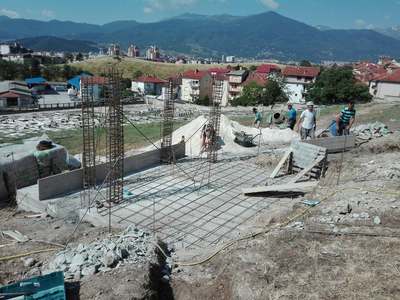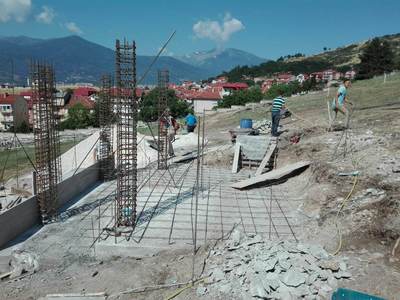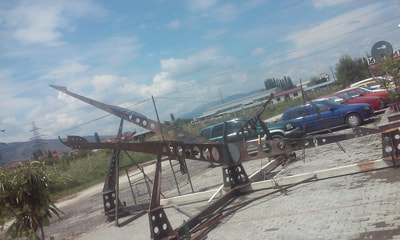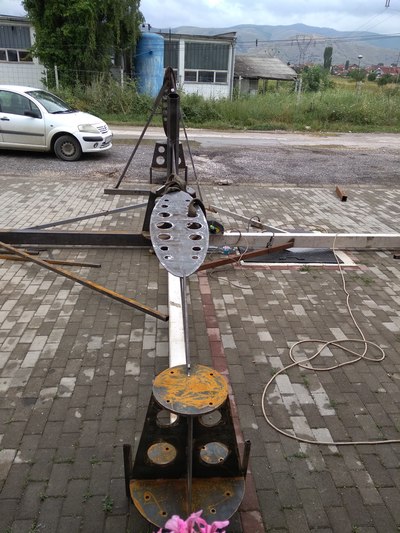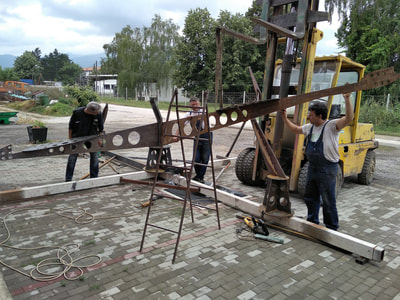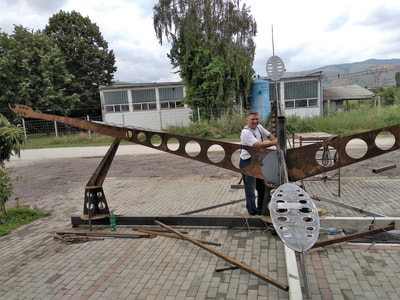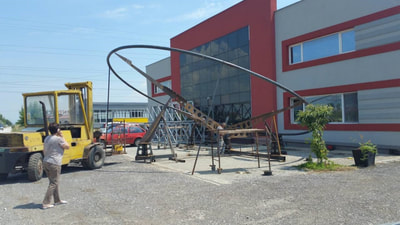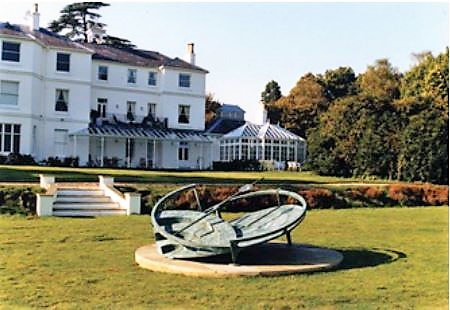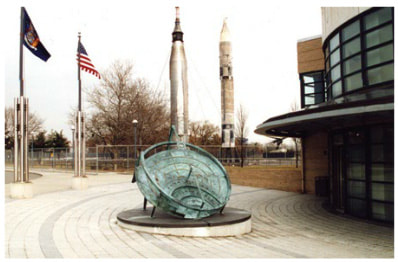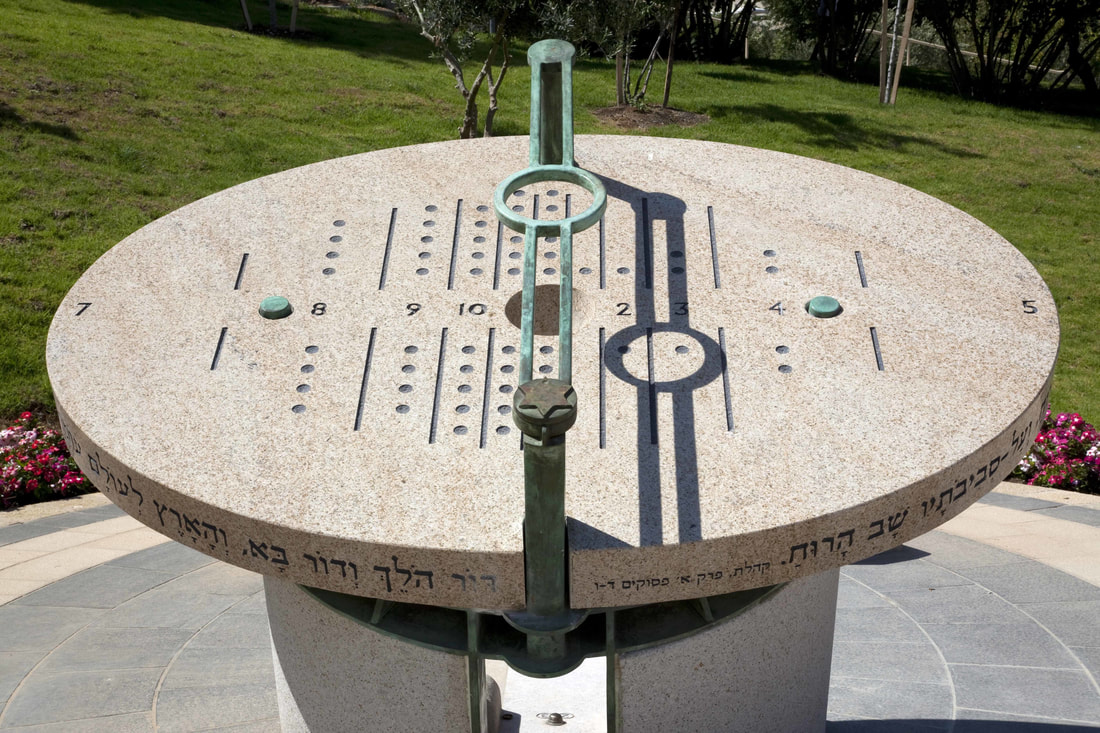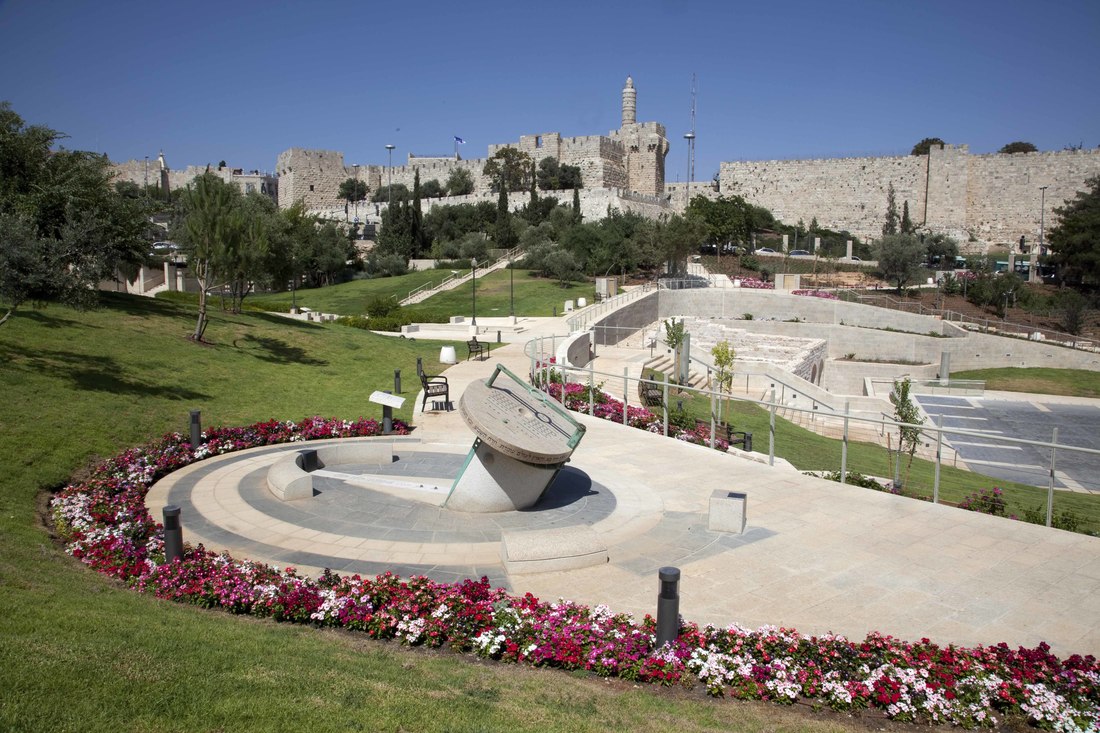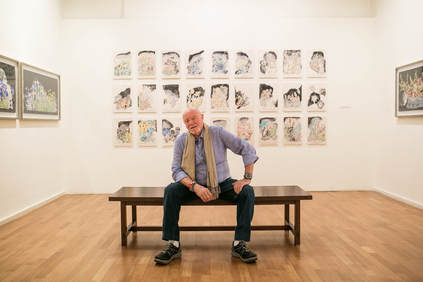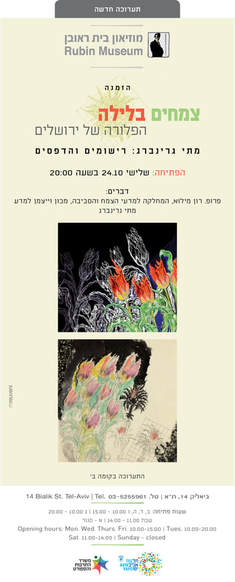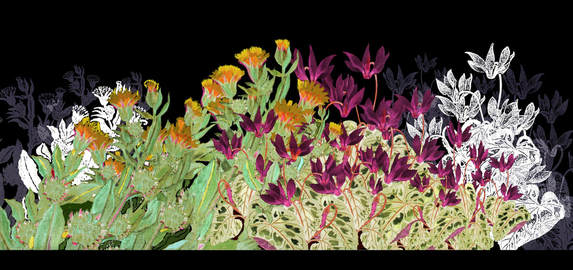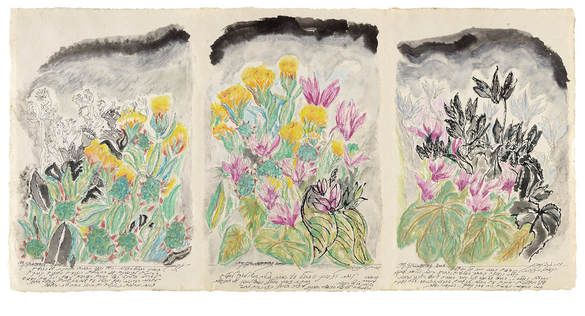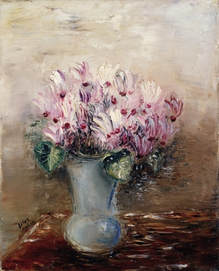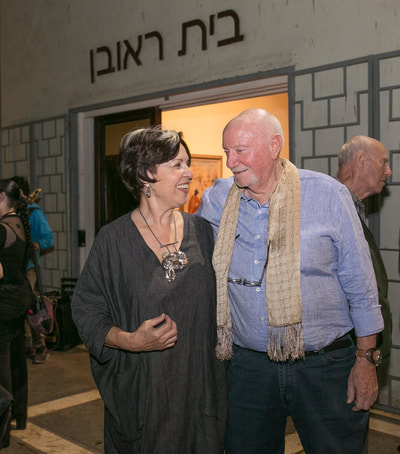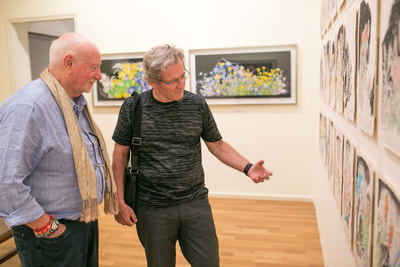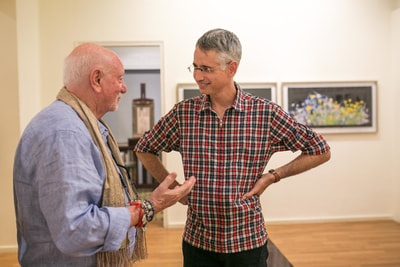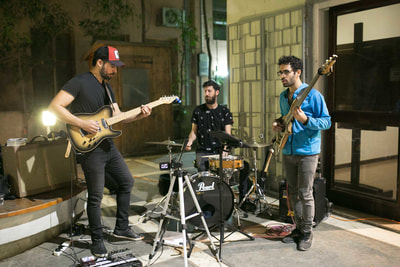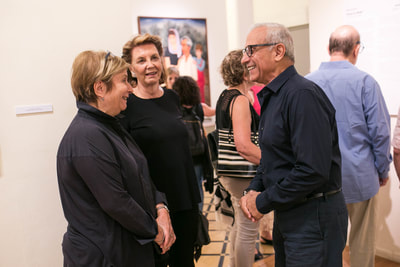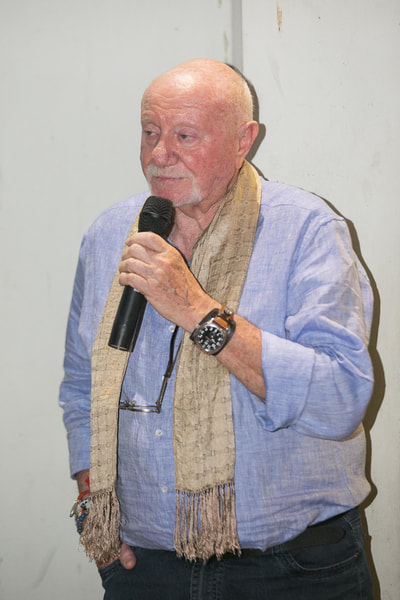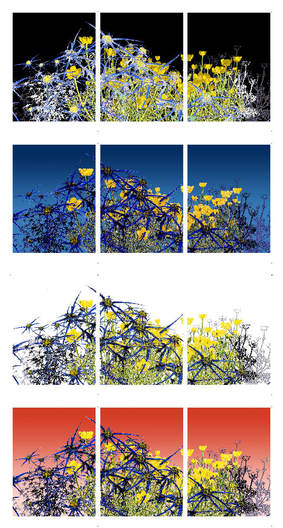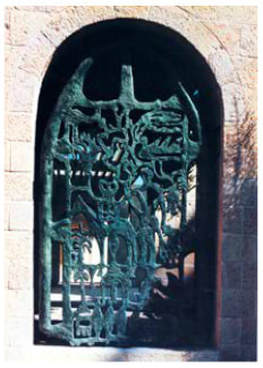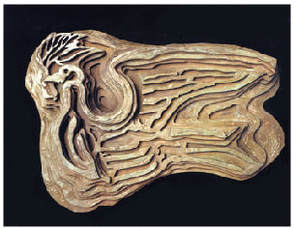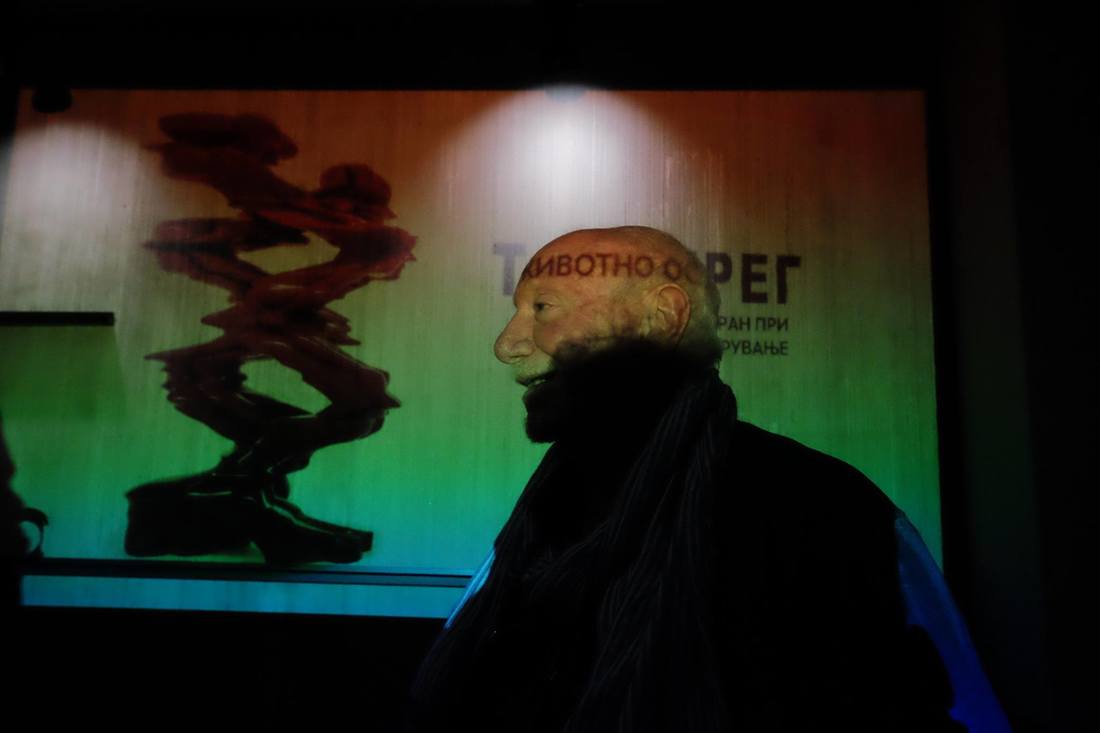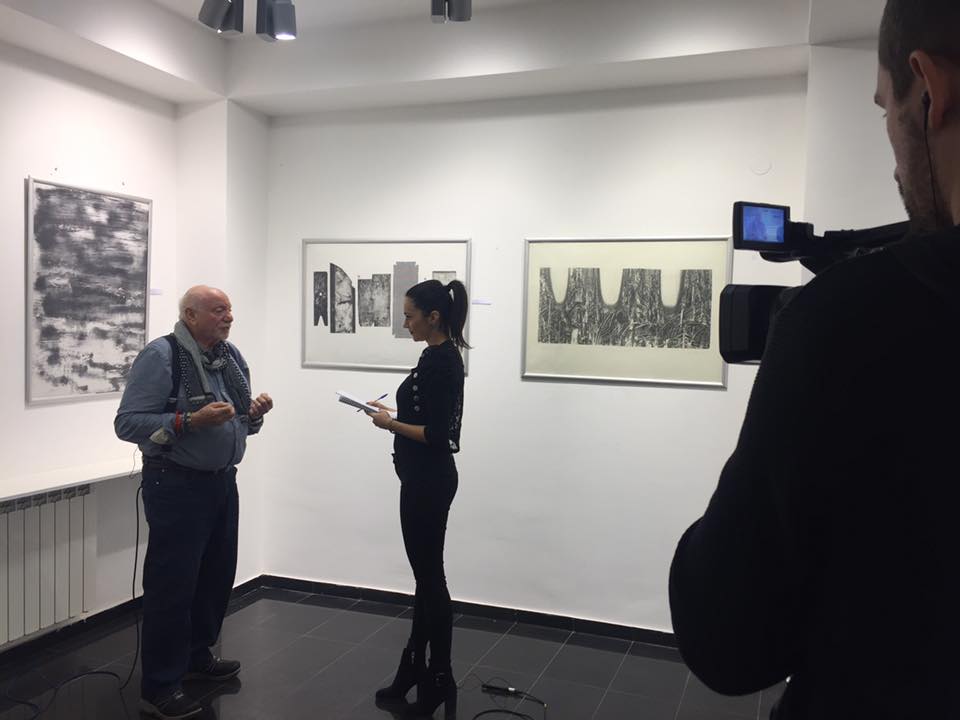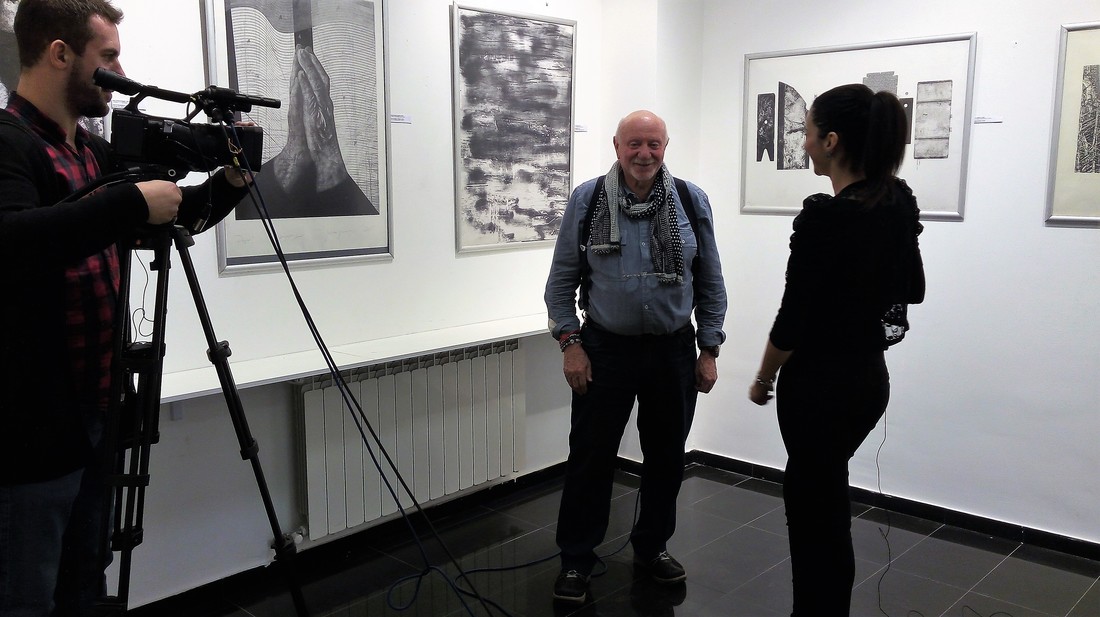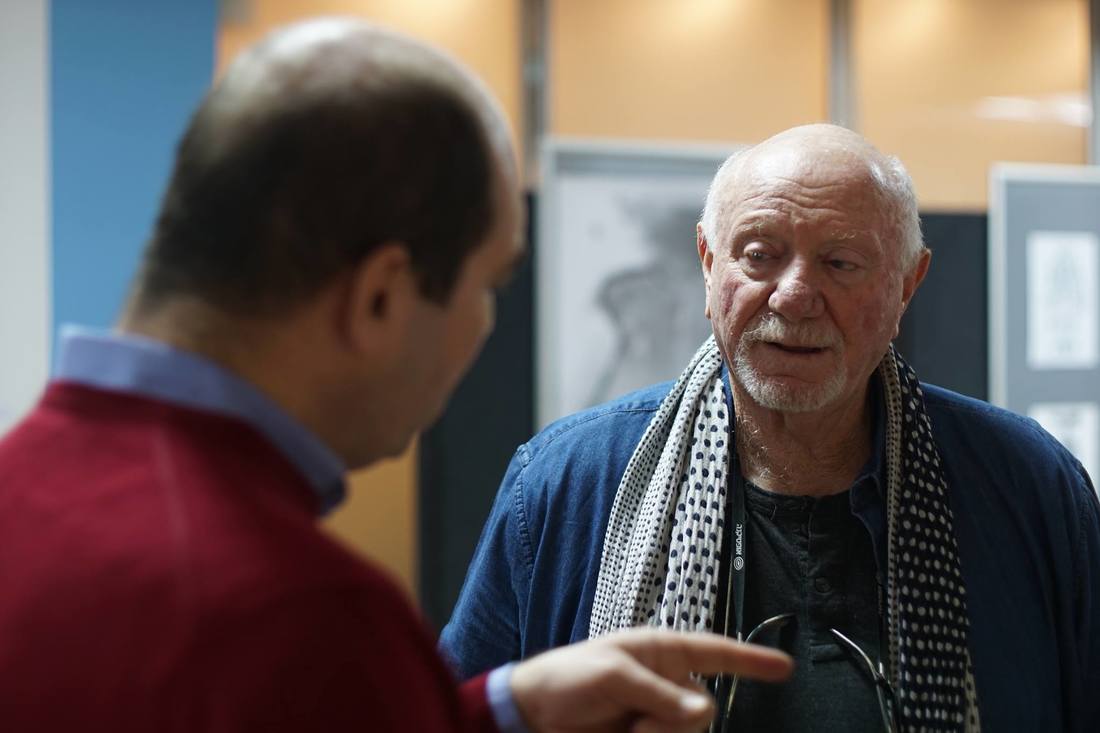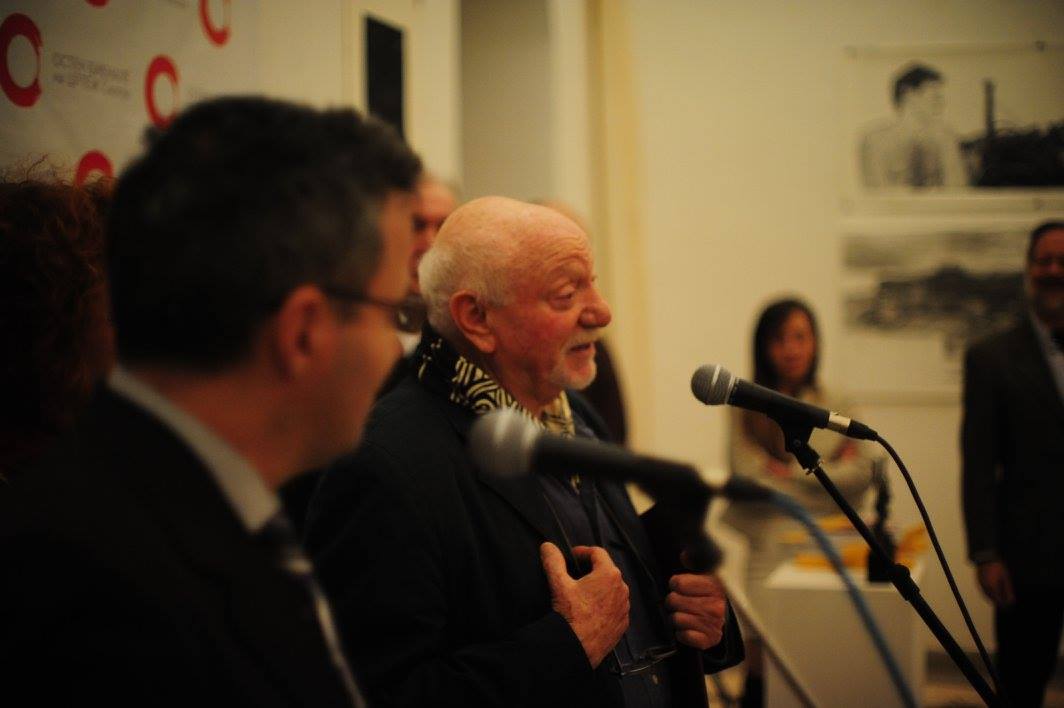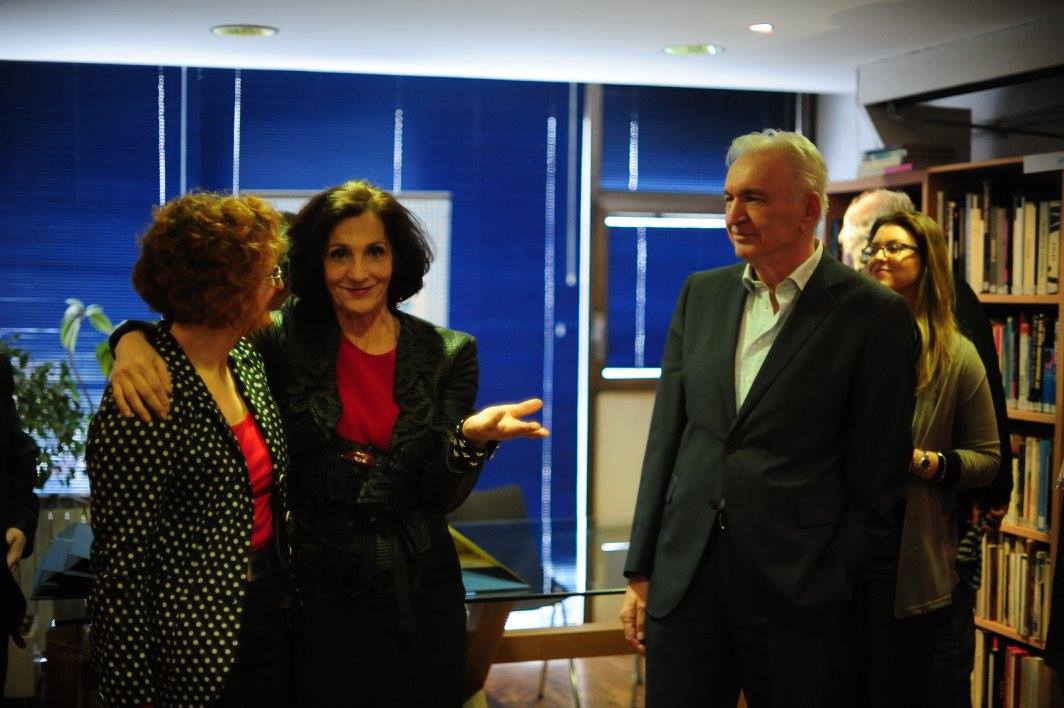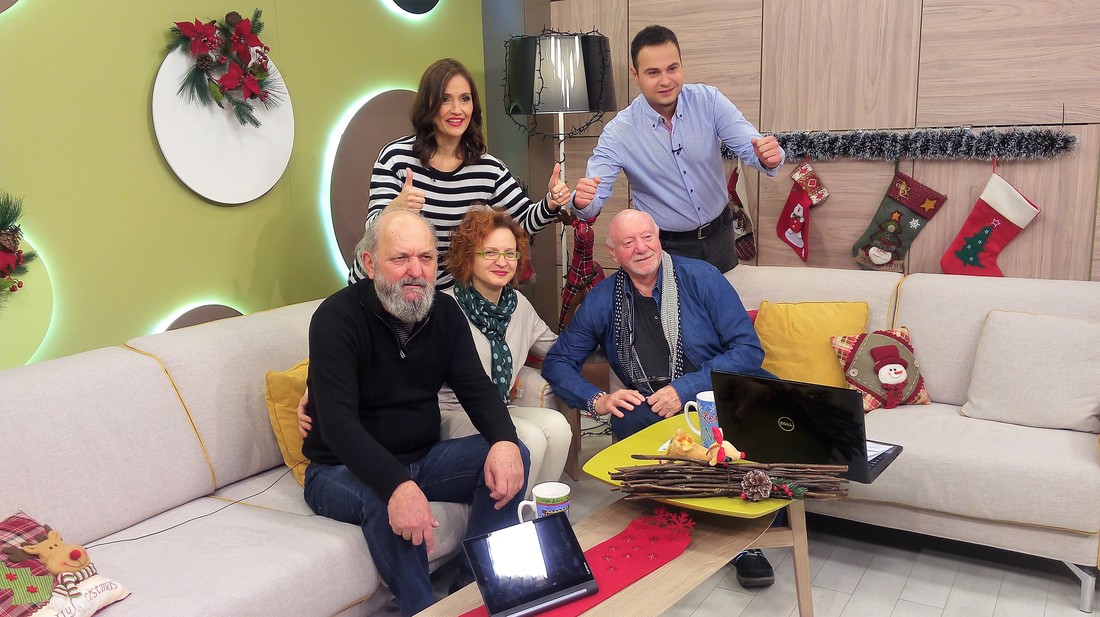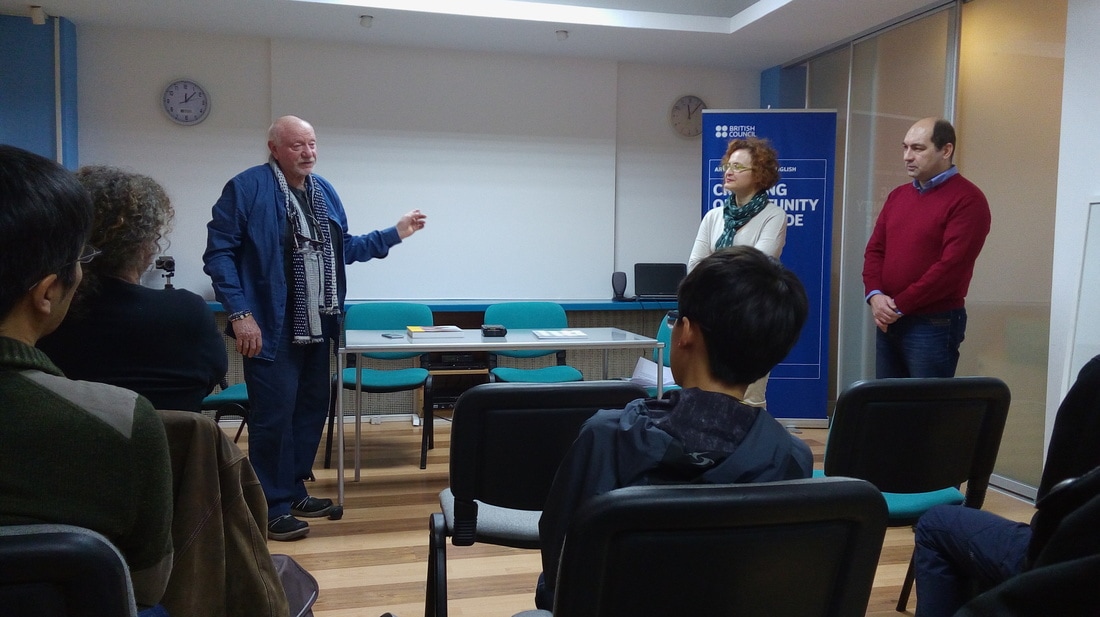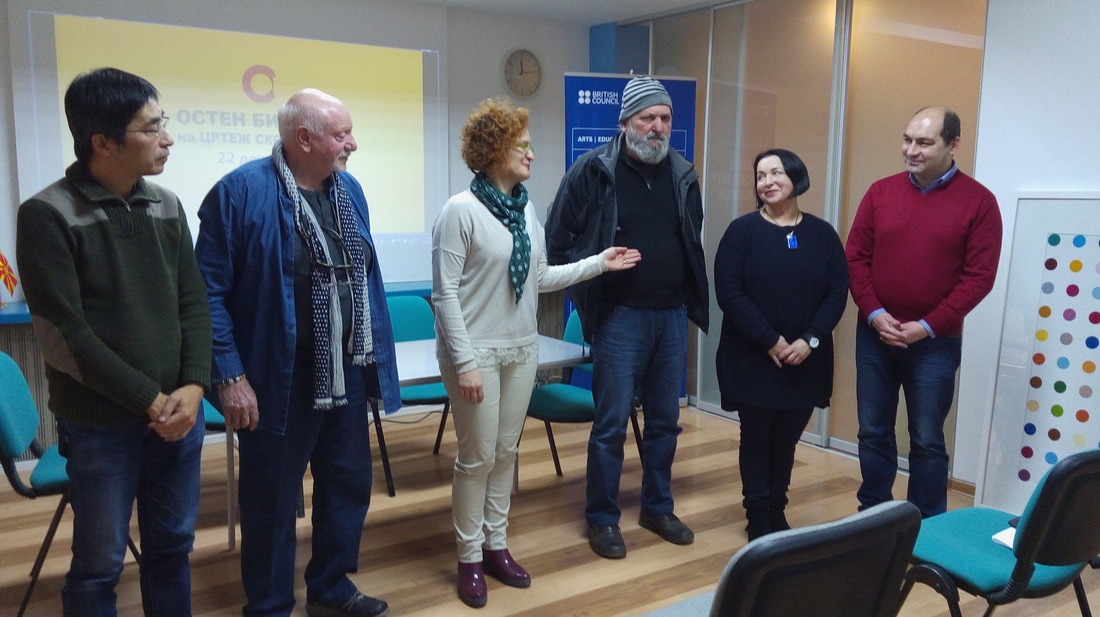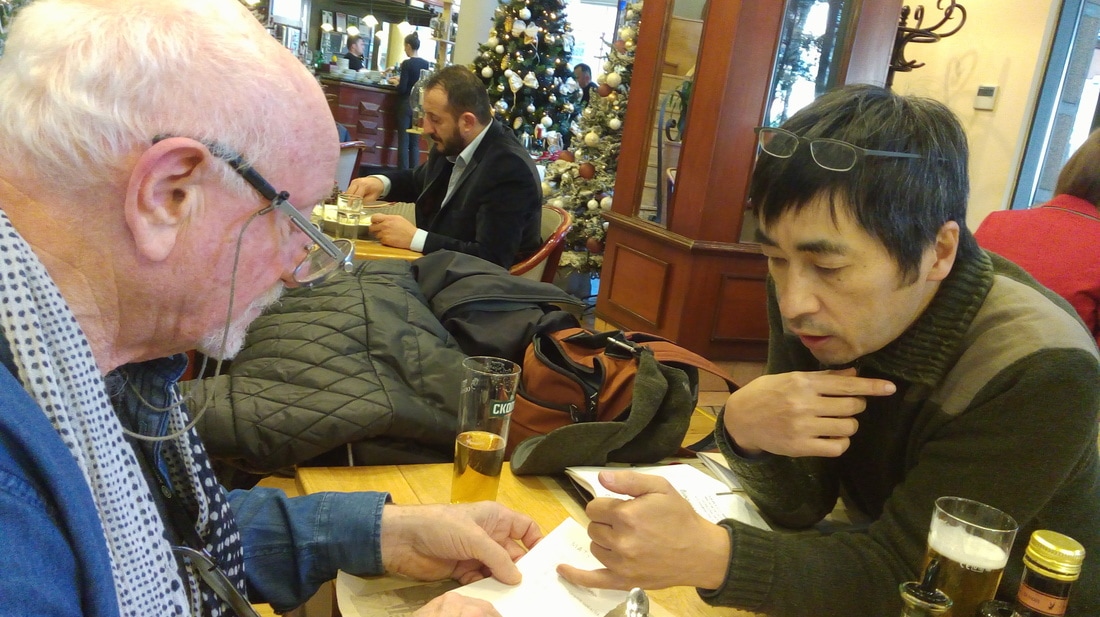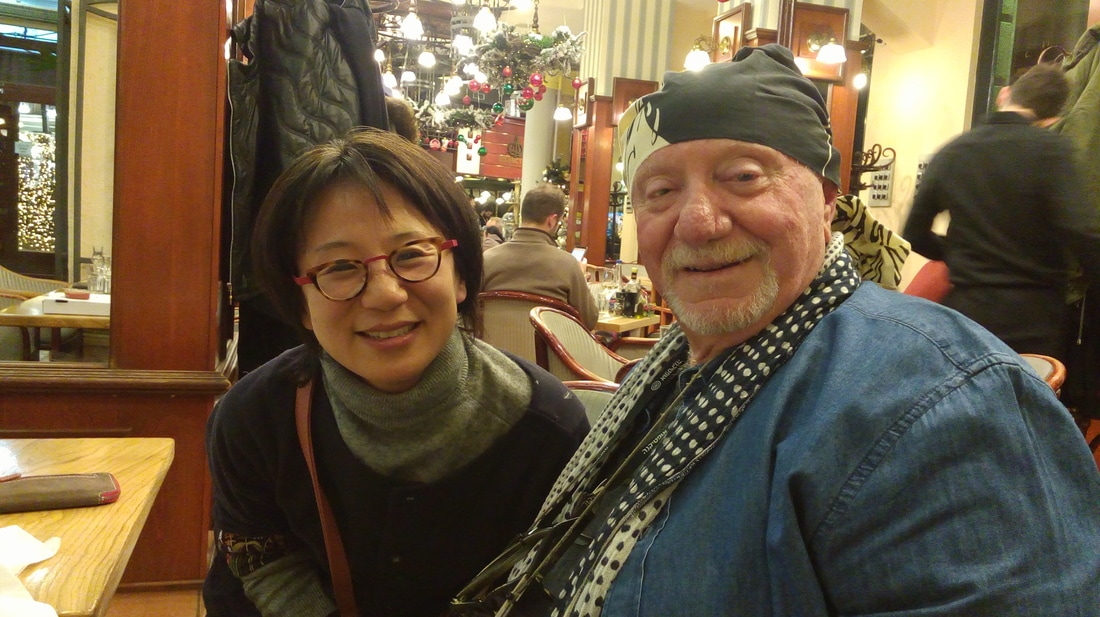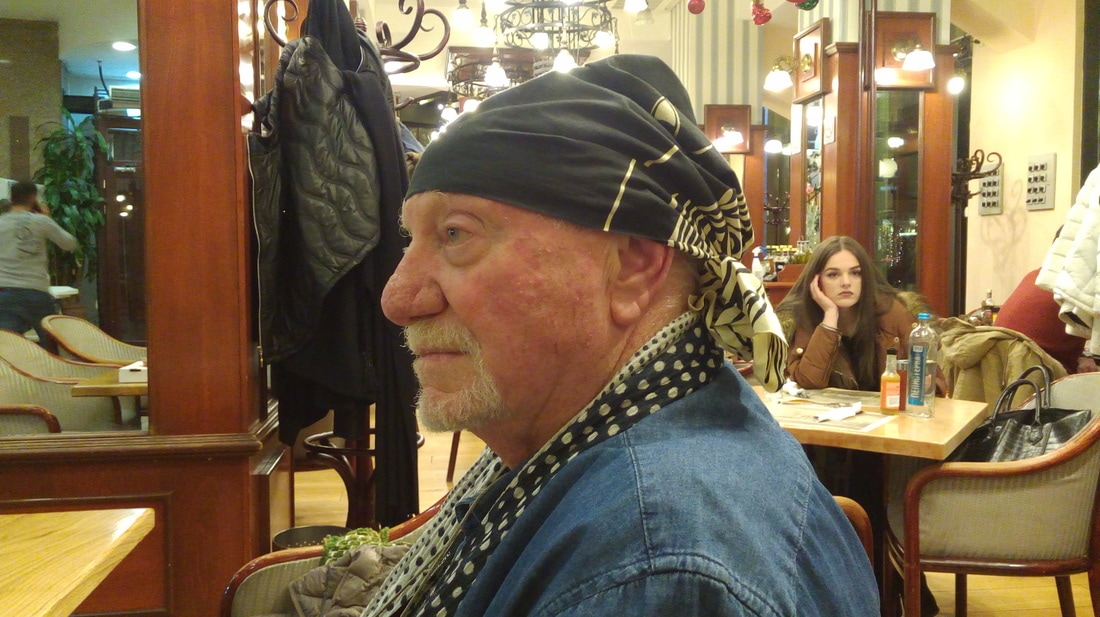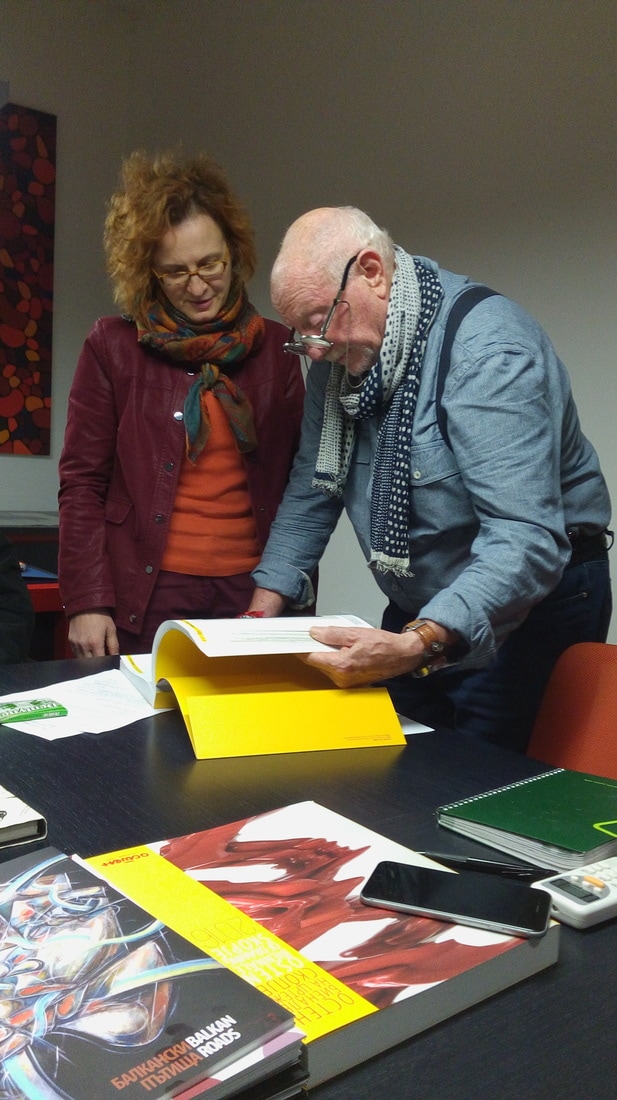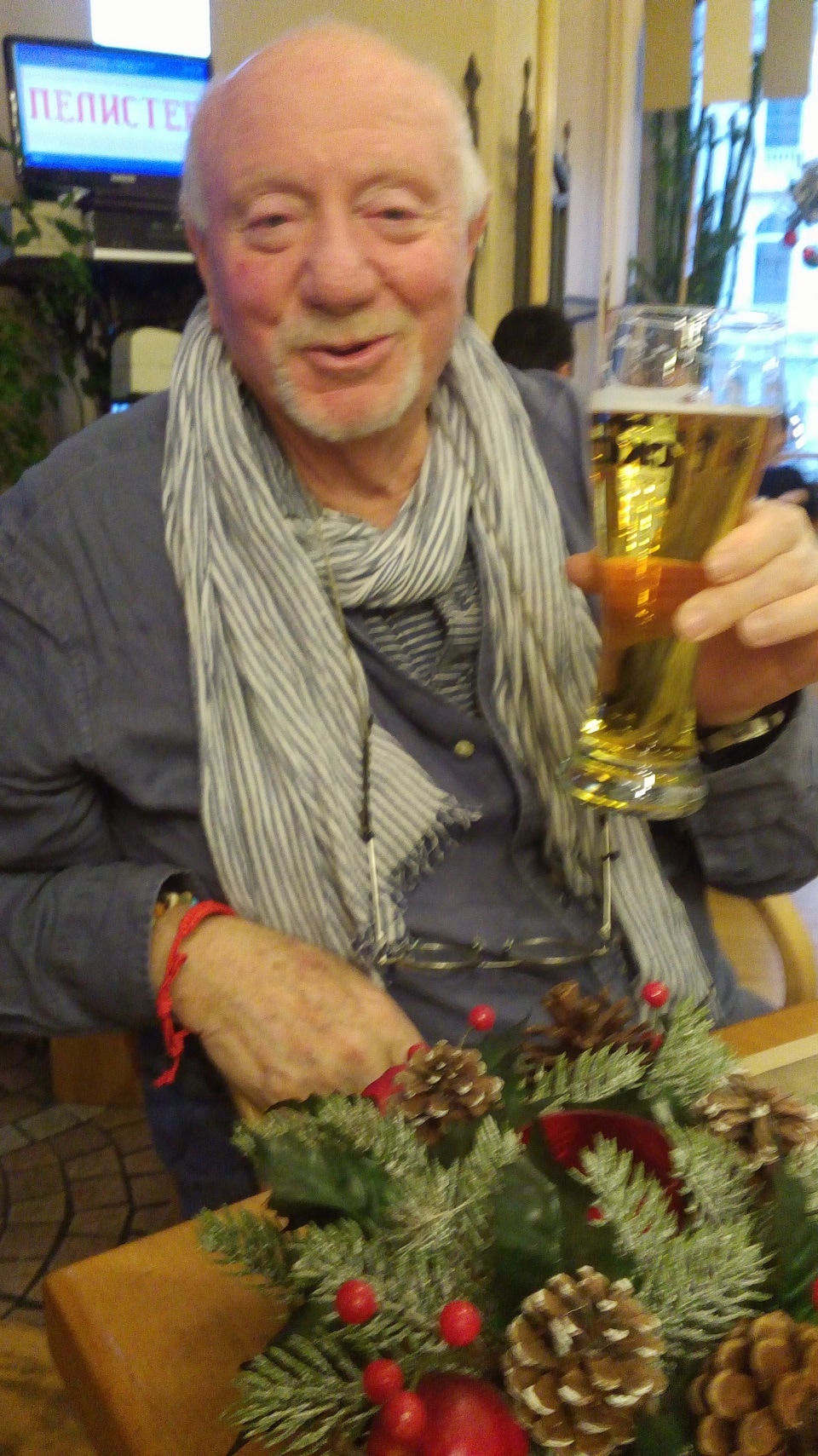| The 1001st menorah was created just these days, and is a gift from the State of Israel to the President of Northern Macedonia, Mr. Stevo Pendarovski, who will light the eighth candle of Hanukkah.The project is led by the Israeli Ambassador to Northern Macedonia and the Director of the Balkans Department, with whom we have been working in partnership for several years - Mr. Dan Oryan, and our wonderful friend - Dr. Rachel-Shelly Levi-Drummer, President of the Bitula Jewish Community Heritage Association, and Bar-Ilan University Academic Secretary. Maty Grunberg was born in N. Macedonia in 1943. He miraculously survived with his parents and sister, and they survived the Holocaust. In recent years Maty G. has devoted much time to his work in the ancient Jewish cemetery in the Balkans, in the city of Bitola / Monastir in Northern Macedonia. He created the sundial sculpture that will be placed in the center of the cemetery, in memory of Macedonian Jewry that perished in the Holocaust in 1943, a few days after his birth. Like the sundial sculpture, the 1001st Hanukkiah is a testimony memorial menorah for the Jewish community that lived in Northern Macedonia before the Holocaust. The menorah is engraved with the inscription: In memory of Macedonian Jewry taken to Treblinka extermination camp. March 11. 1943 No one returned. The beautiful menorah / Hanukkiah is made of bronze, and simulates a tree with its branches and leaves. When the candles are lit in it, it is filled with life and hope. This is similar to the sundial sculpture, which brings light and hope. The Hanukkiah has a complex structure, it stands out from the background panel. For Maty G. it also symbolizes the complexity and spiritual richness that characterized the community of Sephardic and Portuguese Jews. Photos that accompany the fascinating process of casting the menorah. The 1001st Hanukkiah was created as part of project "1000 Menorahs - illuminating the memory of the extinct Macedonian Jewry", in which many activities were and will be held during the festivity of Hanukkah with the intention of reviving the memory of the Macedonian Jewish community. The project is led by: Dan Oryan, Israeli Ambassador to Northern Macedonia. Dr. Rachel-Shelly Levy-Drummer, President of the Bitula Jewish Community Heritage Association. Maya Susha, project leader in Northern Macedonia - Acta Non Verba Adv. Maria (Mima) Gras Duchevska - ARHAM See Less Seasons Greetings Author© Naomi R. Azar |
|
0 Comments
last year, October 2019, Maty and me were guests of OSTEN GALLERY, Skopje N. Macedonia. together with other artists we stayed at an old Monastery, Svety Naum, on beautiful Ochrid lake N. Macedonia. The heads of clergy of N. Macedonia payed us visit. The priest standing by Maty G. is Macedonian, he lives in Russia and serves as personal priest of President Putin. Him and Maty G. had a conversation speaking... Hebrew. Maty created a 3 D canvas art work for OSTEN GALLERY BIANNALE 2020, which is taking place nowadays in the city of Skopje, capital f N. Macedonia, in National Gallery of N. Macedonia Cifte Hamam | 1 - 10 October 2020. 22.5.2020 Jerusalem Day Jerusalem 1967-1990 / Artist Portfolio / Yehuda Amichai / Maty Grunberg When Maty Grunberg was a student at Bezalel Art School he already knew he would one day create work on Jerusalem. On one of his visits to Israel, in the late 1980s, he traveled to Jerusalem and, as usual, photographed several places there. He returned to London and began looking for a concept to guide his work. He was drawn to the special strengths of this special city. In the initial exploration phase, he made abstract sketches of Jerusalem landscape. At the time, *Ron and Tula Pundak, who lived nearby, entered Maty's studio. A friendship has been established between them. Ron and Tula were enthusiastic about the abstract sketches and encouraged Maty to continue. But he was not satisfied with the abstractness that did not express the uniqueness of Jerusalem. He recalled that the "Bezalel Haggadah" he created (1984, New York) – he included wildlife in Jerusalem. He went for a visit at the "Museum of Nature" in Jerusalem, where he met with the director Dr. Moshe Tsurnmal, who lit his eyes as to the special characteristics of the animals in Jerusalem, arising from the location of the city between the desert and the lowlands. Tsurnmal used the phrase - "the predators and their prey". The phrase captured Maty G.'s imagination. At that moment, the idea leading the artist portfolio was formed and crystalized – wildlife confrontation in Jerusalem. He then met with a group of supporters who willingly sponsored the project. The first were Joan and *Richard Scheuer, and Susan and Martin Sanders, who, in the past, have supported his artwork for years. Maty returned to Jerusalem for a two-month stay at Mishkenot Sha'ananim, which was then a small place, not at all like the spiritual sanctuary it is today. Maty G. took with him to Jerusalem the minimal and most powerful tool an artist has - a pencil. He had the visual idea of the artist portfolio he was about to create, but he had no text. Over the years Maty created over 30 artist books, all of them were accompanied by texts written by the best writers. Now, he searched for text. While wandering around in bookstores, he encountered a poem written by the Israeli renowned poet Yehuda Amichai, who wrote this poem immediately after the city's 1967 occupation - "Jerusalem 1967". Amichai was not caught up in the euphoria that prevailed in the country, and wrote a poem that Maty saw as a harsh prophecy that is valid up to these days. The poem seized Maty. He contacted Yehuda Amichai who lived in the "Yemin Moshe" neighborhood, near Mishkenot Sha'ananim. Amichai trusted his hands on the project. The artists Avraham Ofek, Jacob Pines and Aryeh Azene, who lived in the city and knew it well, showed him their favorite places, their "hidden" places. Every night, he met Amichai and shared with him the day's sketches and impressions. Amichai was enthusiastic and wanted to write a new poem especially for the drawings. But Maty did not want people to say he illustrated Yehuda Amichai's poem. He sought to put side by side his visual work with Yehuda Amichai's text. The poem was translated into English by one of England's greatest poets - Stephen Michelle. The poem was printed in Hebrew and English. The encounter between the two languages, printed line by line, creates a special reading experience as the English translation has more words than the Hebrew source. Maty chose the technique of figurative woodcuts to carry out the work. The woodcuts fierce character, on a white paper with only black ink, would reflect well the nature of the city. Humans are absent from the woodcuts. The conflict is represented by the animals that are a kind of fable to the survivors throughout the city's ongoing history - the predators and their prey. Wolf or Jackal on the roof of a house. Three preying birds against the "Bezalel" building, a large black snake crawling toward mongoose against a nightly panorama of the city, a deer head against the cityscape, a preying mantis attacking a butterfly against the urban landscape of West Jerusalem, a poison grasshopper, Jerusalem partridge against the Tower of David, and more. The artist's decision to exclude human beings from his work skips the pothole of a local political work and makes it a universal, valid anywhere and at any time. In 1990, the creation of eight woodcut sequences ended, each containing seven images, a total of 56 woodcuts. The Friends of Bezalel Society in New York published the artist's portfolio "Jerusalem 1967-90". The entire edition was sold. An exhibition based on the artist's portfolio was presented in New York, London and Jerusalem. Maty G. wrote: "To observe Jerusalem is to be caught in an intricate puzzle. Its landscape is a complex vision of many meanings, which provide an endless kaleidoscope of further meanings – a mosaic of time… My visual encounter with Jerusalem took place where the sky shimmers on the earth – on the line of its horizon. The horizon inspired my black and white woodcuts. It is the animals that inhabit the air and earth in and around Jerusalem that have survived throughout its eras – a continuous lifetime throughout its long history. The confrontation in Jerusalem…has caused a perpetual conflict between the indigenous predators and their prey. This conflict is the focus of my work". Susan Goodman, today Senior Curator Emerita, The Jewish Museum, New York wrote back then: "…Maty Grunberg is an artist who has his own unique vision of the city. It belongs to his personal mythology and symbol system. For Grunberg, the landscape of Jerusalem is an inseparable part of the complexity of his physical, spiritual and sensual existence. 'Jerusalem as a theme' by Grunberg represents the essence of a given visual environment. The details of reality are reduced in his woodcuts by means of a tight system, composed of a plethora of forms organized on a surface where depth is integrated with shadow…" Dalia Manor, a curator and a critic, wrote: "… When a contemporary artist approaches the subject of Jerusalem he risks, I think, sliding into a trap of sentimental stereotypes and kitsch, which forms an inseparable part of Jerusalem cliché'. In this respect, Jerusalem – like other enchanted places – challenges the modern artist. Israeli artists have never avoided a confrontation either with the city or with the idea, whether approaching it with awe, as the works of Anna Ticho or Avigdor Stemtsky, or with a special view of local myths as manifested in the work of Joshua Neustein and Menashe Kadishman. Jerusalem has had an enduring presence in Israeli art since the establishment of the Bezalel Academy ,in 1906. The work of Maty Grunberg, a series of woodcut prints, joins the long, diverse and ongoing tradition of the theme of Jerusalem in Israeli art…" Second house in the poem "Jerusalem 1967" by Yehuda Amichai: I've come back to this city where names are given to distances as if to human beings and the numbers are not of bus-routs but: 70 After, 1917, 500 B.C., Forty-Eight. These are the lines you really travel on. And already the demons of the past are meeting with the demons of the future and negotiating about me above me, their give-and-take neither giving nor taking in the high arche of shell-orbits above my head. A man who comes back to Jerusalem is aware that the places that used to hurt don't hurt any more. But a light of warning remains in everything, like the movement of a light veil: warning. Project page of Maty's web:
http://www.matygrunberg.com/wildlife-confrontation-in-jerusalem.html A short firm – Project Jerusalem, Director – Jack Pizzey. https://youtu.be/so2B45o3WRc * Ron Pundak was later one of the planners of the Oslo Accords, serving as CEO of the Peres Center for Peace from 2001 to 2012, the year he passed away. * Richard Scheuer was a dear friend of Maty and a great supporter of his artwork for thirty years. He passed away in 2008. Written and edited by Naomi R. Azar For its innovative and unique perspective on an important art form, for its impressive and thoughtful collection of drawings, for all of the initiatives that help create a better understanding of and appreciation for artists from around the world, and for establishing a globally recognized voice in the art world in Skopje, Macedonia, OSTEN has received the 2016 BID International Quality Award in Paris, France, which is among the most prestigious recognitions for organizational excellence in the world. The exhibition space of OSTEN - Institution for Museum and Gallery Activities who runs three international events: OSTEN Biennial of Drawing, OSTEN Biennial of Awarded Artists and World Gallery of Cartoons (since 1969). The gallery is in the center of Skopje, the capital of Northern Macedonia, a destination we often visit in recent years due to the special connection of artist Maty Grunberg to Macedonia, his homeland, and the projects he performs there. Established in 1969, the Gallery is celebrating this year its 50th anniversary of being a World Gallery of Cartoons. www.osten.mk In 2016, artist Maty Grunberg was invited to take part in the OSTEN Biennale and was awarded a special recognition. See link: http://www.matygrunberg.com/exhibitions--events/archives/02-2017 This year, Maty and I were invited to attend a biennial of awarded artists of OSTEN Gallery. The biennial takes place at the St. Naum hotel, located on the shore of Lake Ochrid, one of the most beautiful places in North Macedonia. https://www.discoveringmacedonia.com/2018/the-magnificent-monastery-of-st-naum/ Eight artists participate in the biennial: Mice Jankulovski, owner of the gallery and an award-winning internationally recognized artist. From 2012 Mice paints only in black, creating refined three-dimensional textures in his paintings. http://www.osten.mk/en/blog-post/27877/mice-jankulovski Maty Grunberg writes about Mic's work: "While observing the black large canvases, our optic nerve transmits directly to the stream of consciousness, thus the artwork becomes a form of a mystic language. A journey into the depth of the large black paintings creates an inner process of the viewer, deeply touching his inner spirit." Maty Grunberg, my life mate, an Israeli sculptor artist, www.matygrunberg.com I accompany him as a writer and the studio manager . In his Maty is delving into minimalism, a three-dimensional circle. Like the rest of the artist, he creates a one work of 100 cm by 70 cm, (this work is 3 dimension) and a big work - 195 cm by 285 cm. This is the first time he has done this kind of work on canvas and not on paper. He titles the big work – Three of four shades of red, concentric circles. Harris Kondosphyris, Greek artist, creates installations, mainly interested in the relationship between the wall and the space around it. https://www.facebook.com/profile.php?id=100009785599318 Harris brings a small model of his artwork made of concrete and metal. He will enlarge this work to the size of the large work each artist is preparing for OSTEN biennial 2019: 195 x 285 cm. Joskin Silian, Serbian painter https://www.facebook.com/JoskinSiljan, Joshkin defines himself as a visual storyteller. For many years he has been working with autistic children who understand his paintings well and have a close and warm relationship with him. Rosica Lazeska, whose name means "a drop of dew", Macedonian painter from Skopje. https://www.facebook.com/rosica.lazeska Usually she is engaged in assembling collages, mostly she works on a small scale in a figurative abstract style, this time Rosica enlarges the collage to work on the large canvas Ahmet Albayrak, the youngest participant who comes from Kayseri City from urkey. https://www.ahmetalbayrak.net A recurring motif in his paintings is wind sleeves which he paints persistently almost obsessively.It is fascinating to follow his work and notice the formation of the wind sleeves . The hoopoe bird also appears in many of his paintings, in his studio yard hoopoe birds land during their migration. Nevat Beijtuli Kica, Macedonian painter who from the city of Tetovo. In his painting Kica captures a moment from an ancient legend that tells of a Turkish Muslim Pasha falling in love with a beautiful Christian Albanian girl, not a common thing in those days. The Sultan humbles him, but he refuses to obey and builds his own little kingdom and stays with his beloved. Kica paints the dramatic moment when Pasha first laid eyes on the beautiful girl. Goce Bozurski, Macedonian painter from the town of Komanuvo, Goce begins by drawing graffiti on the canvas surface, then paints a hyper- realistic torso object, a surprising contrast, Characteristic of his works his artworks. I notice that many names end with syllable ca which is pronounced as "tzah". Mice, Rosica, Kica, Goce. Maty and I consider changing our names to Matytzah and Naomitzah… It also turns out that according to an ancient Macedonian tradition, fortunately not preserved today, after marriage, the woman's first name becomes the man's name plus the " tzah ", that is, if I marry Maty my name becomes Mateytzah. Gaining a husband, the woman loses her identity and becomes man's property... And so, eight visual artists and one writer come together under the baton of the wonderful OSTEN gallery director – red head Kornelija Koneska, with a background of architecture and in-depth knowledge of the art and practical knowledge of the area, is energetic and visionary. Together with Mice Jankulovski, Kornelija leads OSTEN gallery towards international recognition. Despite the language limitations and the different styles of painting, the artists quickly connect with each other, everyone speaks the language of art, the language of creators. Between Macedonian, Serbian, English, Turkish and Hebrew - they all work out. For example, we find that when you raise a toast, "Lehaim" in Hebrew, which means - to life, in Macedonian - Jivli, also to life, in Serbian, as in Russian - Nazdrovia, in Turkish – Sherefe' - to your honor, in Albanian - Gazo, which is "beautiful" or "good". Toothpicks, in Macedonian - Chachalitzah, in Turkish - Churdan. Milk rice, a pampering dish that mothers and grandmothers around the world cook, in Arabic – Raz Behlib, in Turkey - in Sutlatch, in Serbian - Soukliash , and in Macedonian - Soutliash. OSTEN artist community is formed around the dining, wine and beer table. All the participants are excellent artists, renowned in their own country, some internationally renowned. Everyone, of course, is an Osten's award winner. The choice of the participating artists, and the climate that Cornelia and Mice enshrine around them create an environment of creativity, generosity, and mutual reciprocity. The atmosphere is relaxed, the artists exchange general and specific opinions and ideas about each other's works. Not an obvious thing about a bunch of competitive artists. One day there is excitement in the hotel staff. It turns out that the Macedonian top clergy is coming for a visit in this holy place. Saint Naum is named after its founder - Sveti Naum, who founded it in 905 as a monasterywhere he taught Cyrillic literature and cured people. Today, the complex includes an ancient church where masses of believers and tourists come to visit, a hotel we live in, and a restaurant overlooking beautiful Ohrid Lake. The archbishop of Macedonia and his colleague from Russia, who is from Northern Macedonian origin, and became President Putin's spiritual father, and an entourage of pastors, honor us by taking interest in the artworks and the artists. They pay us a special visit; each artist says a few words about his work. Mice Jankulovski presents Maty as the last Jewish baby who survived the Holocaust of the Jews of Macedonia and became a well-known artist, the welcome Maty with a Hebrew Shalom. Maty uses the short time and tell about his exhibition, which is part of the permanent exhibition at the Holocaust Museum in Skopje and the Sundial Monument he built for the old Jewish cemetery in the city of Bitola, in Macedonia. Mice Jankulovski grants the guests a portfolio of the OSTEN Biennale, 2018. They accept it with respect. We are a band of artists - Christians, Muslims, Jews, none of us is observant, some of us are absolute atheists, but we are all excited with this surprising visit. On Friday we take time out and tour in the magical city of Ochrid. The trip ends with the opening of an exhibition marking fifty years Anniversary of OSTEN Gallery's activities as an international cartoon gallery. Cartoons are a means of conveying visual messages in a clean and sharp way. OSTEN considers cartoons a weapon of peace. Each year the gallery hosts an international competition, thus allowing cartoonists to sharpen their "weapons". The current exhibition in Ochrid presents the 50 cartoons that won firstprize over the years. It is an intriguing and intelligent exhibition. The next day we go for a boat ride on the spring of St. Naum, the water is clear and cool, they come from Lake Prespa beyond the mountains, high above Lake Ohrid, the elevation differences and the structure of the land have caused an interesting phenomenon, the water springs flow from the ground in the river. Streams of water burst out of the sand. Zoran, the boat cruiser, says that twice a day the water in the river changes as a result of these springs, that's the reason the water is pure. Some believe the water is holy and purifies the body, a common belief is that St. Naum healed patients with this water. Zoran does the cruise ten times a day during high season, he thinks it's the best job in the world. He explains that the whole place does not belong to anyone and therefore belongs to everyone. The beauty of the world belongs to everyone. In this optimistic tone, we return to work. 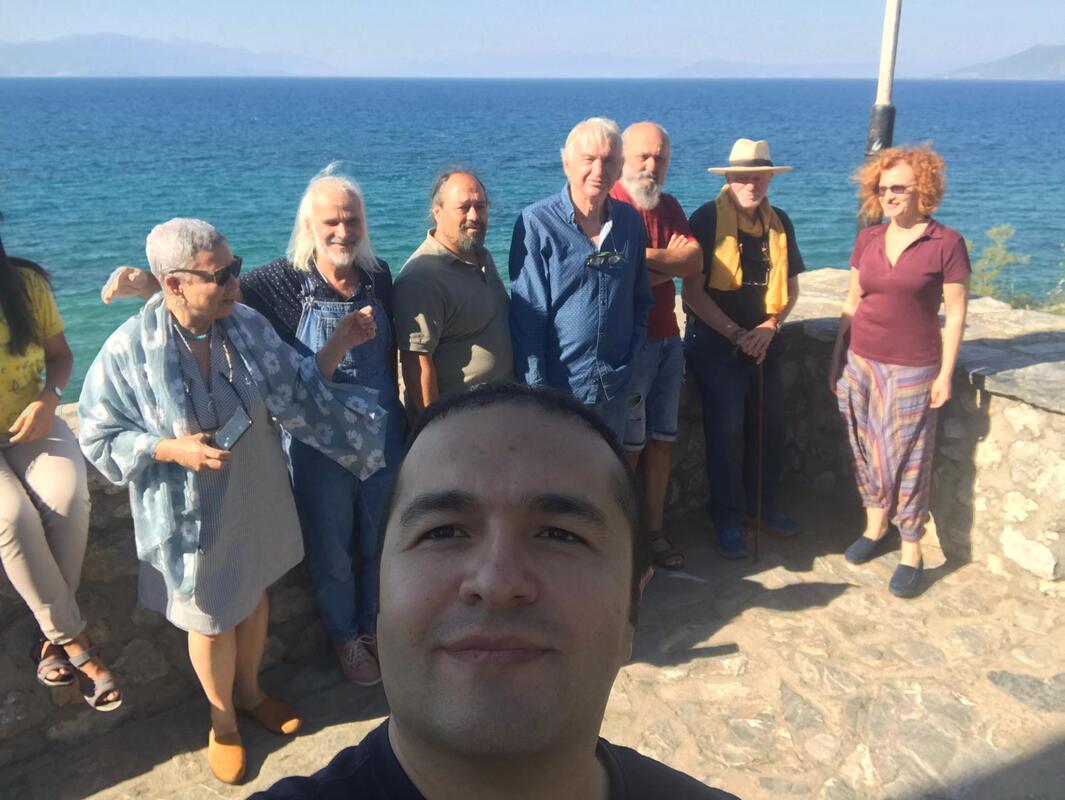 Towards the end of our stay, Raffi Kaiser, an Israeli painter who lives in Paris where he is very successful, is arriving to visit the Biennale. Raffi and Maty, old acquaintance, are surprised to meet each other on the banks of Ohrid lake. Raffi draws a small pencil work on paper as a gift to OSTEN gallery. This article was wrritten by me, Naomi. R. Azar, an Israeli writer, I accompanied my partner, artist Maty Grunberg, to OSTEN Biennale of awarded artists 2019. I also took the pictures. As there was no table in the room I improvised...
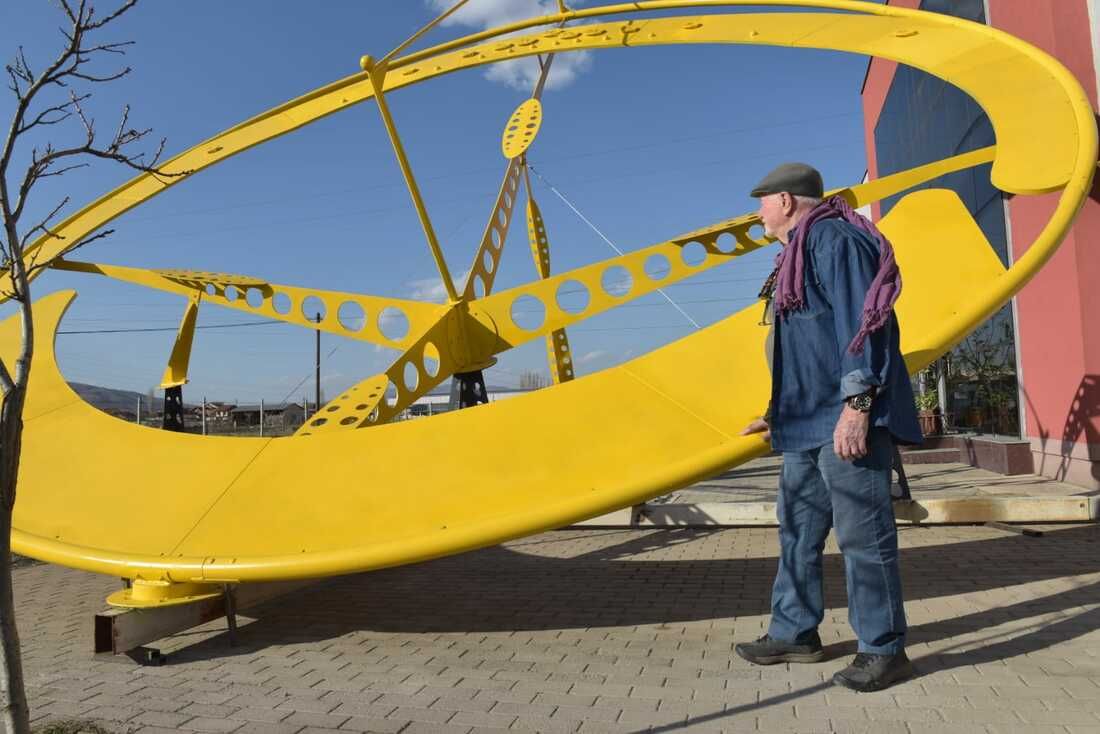 M.G. in front of sudial sculpture, Bitola / Monastir, photo: Shlomi Amsalem M.G. in front of sudial sculpture, Bitola / Monastir, photo: Shlomi Amsalem Setting up the sundial sculpture written by Naomi R. Azar M. Grunberg studio manager For the past four years, every March, Maty G. and I set out for Macedonia, the country of his birth, to attend memorial ceremonies held in the city of Bitola, which the Jews call Monastir, and in the capital, Skopje. During these years, Maty G. created a monumental sundial sculpture in memory of the Jews of Macedonia who perished in the Holocaust. The creation of the sculpture itself takes about three months, but all the "bureaucracy" (raising budget, obtaining permits ...) creeps in its slow time, as befits a sundial sculpture that knows it is eternal and is in no rush. The duty and the right to accompany this project in writing and in photography have fallen in my part, (links to previous lists are detailed at the end of this column). This time we are particularly excited. The sundial, with all its parts, is ready, painted bright yellow. We arrive to assemble the sculpture in the metal workshop where it was built. The sundial is a metal construction, 9 meters in diameter, and weighs close to 3 tons, Maty must ensure that its parts are properly assembled and reinforced. He wants to examine it carefully and make sure that everything is correct, both the sculptural aspect, and no less important - the safety aspect entrusted to a qualified safety engineer. Every morning we arrive at the metal workshop, follow the construction of the sculpture, send pictures to the astronomer, Ilan Manulis, the director of the observatory at the Weizmann Institute of Science, whose scientific calculations accompany Maty's sundials. In fact, this is a sort of 'grand rehearsal' before the sculpture is placed on the amazing platform built for it at the center of the huge hill that is the ancient Jewish cemetery in the Balkans, in Bitola/Monastir. As for art, in the central cities of Macedonia there are huge figurative statues in the public sphere, heroes adorned with enormous mustaches, gnarled muscles, swords drawn in their hands, plump women, giant breasts nursing chubby babies. (Sometimes gypsy child with a running nose, sits next to the heroic sculpture, begging for money, spoiling the picture…What a shame). The sundial sculpture, created by Maty G. is very unusual in this landscape, the first of its kind in the country, a clean contemporary construction that captures the abstract idea of time. At the end of the week the sundial stands. Maty goes through a few points that require refinement with Zvonko, the workshop manager, he adds reinforcements that will ensure the stability of the statue, which will be presented in public for the first time tomorrow, March 10th, as one of the stations in the "March of the Living" that will take place in Bitola / Monastir. The ancient Jewish cemetery in Bitola / Monastir – The base of the sundial We head to the cemetery to review the base that is in progress. The impressive platform was designed by ARCHAM group, four strong and determined Macedonian architects - Annie, Marianne, Vicky and Danielle, who even prepared a charming architectural layout for the park of life that will turn the cemetery into a place of living memory, with great respect for the dead. The leader of ARCHAM group is the energetic, full of Macedonian passion, lawyer Maria Geras Dochovska. On March 11, 1943, the Jews of Macedonia were rounded up by Bulgarian soldiers who sent them to their deaths in Treblinka death camp. On March 10, 2019 the "March of the Living" is taking place in Bitola / Monastir. I wrote a lot about the Holocaust, I even made a film about my family as Holocaust survivor - "A Jew from Hungary" - https://www.youtube.com/watch?v=XJfWE1fcTQ8&t=98s ,the subject touches the most sensitive nerves and depresses me deeply. Therefore, I turn my gaze and look at the life that is now bustling under the title - Memory of the Holocaust. "The revival of the memory of the Macedonian Jewish community in the ancient Jewish cemetery in Bitola / Monastir" reveals a whole world of activities that are not related to memory and are unrelated to the Holocaust, but are an accompaniment to the presence of Israelis and Jews from all over the world who come to remember, and bring along their talents and their ability to act. Currently Macedonia is engaged in many activities relating to its relations with Israel, formal and informal contacts created by encounters of people who would never meet, but who came, to remember and to remind, thus creating a process that moves towards the future Dan Oryan, Israel's Ambassador to Macedonia and Director of the Balkan Desk, leverages the project of reviving the ancient Jewish cemetery in Bitola, by turning it into park of the Living, and links it to Israel's agenda that is relevant today. He creates connections in many fields, a strong bridge between Macedonia, which is a small country but a great friend of Israel. This is how inspirational elements come from different population groups in Israel, each of whom becomes the ambassador of the project in Israel. Dr. Rachel Shelly Levy Drumer was born in Macedonia, she is assisting the ambassador with endless dedication, Dr. Drummer is the Academic Secretary of Bar-Ilan University in Israel. This year, over a thousand people, mostly locals and some from neighboring countries, take part in the March of the Living in Bitola/Monastir. About two hundred and fifty people come from Israel. "March of the Living" is an organization of 48 branches all over the world, represented in Bitola/Monatir march by Dr. Joel Rappel, Israeli Historian who worked many years with Elie Wiesel. The organization combines extensive activities to impart Holocaust remembrance. Journeys to the concentration camps in which Jewish and non-Jewish students participate during holidays between semesters, many years have left for Poland alone. Ttoday there is a tendency to decentralize the memory and not to concentrate it in Poland. As in Macedonia, the March of Living is also active in other European countries where Holocaust took place, reminding the locals of the horror that had taken place, and of their silent by standing that allowed it to occur, along with the oath, never again, neither to Jews nor to other minorities. To forget those who perished is to murder them for the second time, Dr. Rappel quotes Elie Wiesel. And we remember, a harsh memory, one cannot get used to it, one cannot remain indifferent. Suddenly, A detail from a long speech catches my attention - the Jews were imprisoned in Monopole Tabaco Factory for deportation to Treblinka, and the procedure states that one bathroom will serve three thousand people, the bathroom will work half an hour a day, the procedure also states that drinking is forbidden. I am horrified, and wonder about the person who wrote the procedure, and those who authorized it. Why? what have they thought? Evil is much more charismatic than the good, evil permeates the tiniest cells, creating a monstrous reality. Ze'ev Elkin - Minister of Jerusalem Affairs and Minister of Environmental Protection, honors the events with his presence. The minister inaugurates the Jerusalem Trail in the ancient Jewish cemetery. The construction of the path was made possible by the contribution of the Ministry to Jerusalem affairs. The encounter with the sundial The sundial waits patiently for us in the metal workshop near the cemetery. Its enormous size, its yellow color and its complexity, arouse wonder and curiosity among the spectators who ask Maty G. numerous questions and give him bags of compliments. The sundial is a little embarrassed by the attention and the press coverage, but it is very pleased. It worked hard to be born, and its mission is to be exposed to the general public, to preserve memory, and to bring hope. Maty and me volunteered for this project, our excitement and satisfaction are beyond words. If only our parents would be alive to see it… We are lucky to have our children recognizes this huge effort, appreciate it and remember our ancestors and our history. Skopje, a memorial service and the opening of the renewed Holocaust Museum The next day, a memorial ceremony is held in Monopole Tabaco Factory, there are many ambassadors from all over the world. Maty and me lay a wreath. Later in the day, a ceremony is held in which the Holocaust Museum in Skopje is reopened with a new and impressing permanent exhibition. It is the largest museum in the Balkans, and it is very worthwhile to put it on the map of trips in the region. Goran Sadikarijo, CEO of Holocaust Fund of the Jews from Macedonia, is the director of the Museum. In the evening there is another ceremony at the museum. Following her speech, Dr. Berta Romano Nicolik, President of Jewish community in Macedonia, introduces Maty Grunberg, the last Jewish child who survived the Holocaust of Macedonian Jewry. The story of his survival and his becoming into an international artist is a source of excitement and interest among those present, and he is warmly embraced. His works on the Holocaust are displayed on the third floor of the museum and are part of the Museum's permanent exhibition. It's a moving closure of a circle with his picture in the museum's display, as three-year-old in Macedonian outfit, and a picture of Maty, and his younger sister Liora, on the Kefalos ship at the entrance to Haifa port, 1948, the day they arrived Israel, a beginning of a new era. Links to previuos colomns -
Memory / Eyes on th Future - http://www.matygrunberg.com/memory--eyes-on-the-future-2016.html Haunted Memories - http://www.matygrunberg.com/huanted-memories-exhibition.html Sundial Sculpture / Work in Progress - http://www.matygrunberg.com/exhibitions--events/archives/06-2018 written by Naomi R. Azar At the stage we reached there is no need for words, the photos tell a good story. During the last three years Maty G. has been involved in the process of turning the ancient Jewish cemetery in Bitola / Monastir in Macedonia, the country of his birth, into a memorial park for the Jews of Macedonia (a community almost entirely annihilated during the Holocaust). It was important to Maty G. to bring a beam of light to the old cemetery. As part of this concept, he is creating a sundial sculpture that will be installed at the center of the cemetery in the near future. Many partners are working hard for this project. I will mention only the leading triumvirate - Dan Orian, the Israeli ambassador to Macedonia, and the director of the Balkan Desk, Dr. Rachel Shelly Levy Drumer, born in Macedonia, the academic secretary of Bar-Ilan University in Israel, and her Macedonian childhood friend, the energetic and fearless lawyer, project development director, Mima (Marija) Geras Dochovska. I accompany Maty G.'s work in a series of articles. Here is a link to one of the first posts that sheds light on Maty's work in Macedonia - Memory / Eyes on the Future http://www.matygrunberg.com/memory--eyes-on-the-future-2016.html This adventure began, 1946, after the war, Skopje, Macedonia (former Yugoslavia) Maty G. age 3 First visit, December 2015, Bitola / Monastir, Maty G. is overwhelmed by the size of the huge cemetery stretched out on the high hill, wondering what sculptural element he can create, an element that will be visible on this background that reduces everything in sight. December 2015, Bitola, Maty G. captures the idea (or the idea captures Maty G.) (photo: Hedva Goldschmidt) Initial sketch of the sundial sculpture Maty G. and his son, David Ben Grunberg, are working on various ideas for the planned memorial park Rendering of the sundial sculpture on site Maty G. in his studio working on a small scale model June 2018, Bitola, metal workshop, CNC machine cutting metal. Maty G. with Zvonko the owner and the manager. Maty G. explains the importance of the project to the workers, encouraging motivation visiting the site, at the cemetery Volunteers from Israel, Germany and Macedonia exposed around 4,000 tombstones. Thousands of other tombstones are resting under ground, waiting to be exposed by more sophisticated means of the generations to come. Now the effort is to restore the tombstones that were exposed. Maty G. is excited to find two old mulberry trees at the center of the cemetery, near the location of the sundial sculpture. One is red mulberry and the other is white. Mulberry trees accompanied his childhood with the taste of heaven and shirts stained irreparably to his mother's grief. At the cemetery, the concrete platform on which the sundial sculpture will be installed The city, which over the years approached the cemetery, looks in amazement at what is going on. Meanwhile, in the metal workshop, the sundial sculpture is approaching its planned shape Next week Maty G. and astronomer Ilan Manulis will leave for Macedonia. Astronomer Ilan Manulis is the director of the observatory at the Weizmann Institute of Science in Rehovot. Ilan's calculations escort every step that Maty G. makes. M.G. and Ilan will mark the scale of the hours on the sculpture, before it will be painted in bright yellow, so it will be clearly seen on the background of the green mountain of the cemetery. The yellow color of the badge the Jews were required to wear on their lapels to be marked as Jews during world war 2. Ilan and Maty will also make sure that the sculpture is positioned correctly, pointing to the true north, and showing the precise hour of the sun. To be continued... Astronomer Ilan Manulis - https://www.ilan-manulis.co.il/ For many years Maty G. has been obsessed with the concept of time. The idea of creating a sundial was born following a number of sundial sculptures he created. for more information -www.matygrunberg.com
The decision to expose these drawings to the public was not an easy one. It was the first meeting between the artist and the curators that opened the drawer on the original drawings. The 'Plants by Night' works were created using 21st century Digi graphical techniques, ink jet printing also known as giclée. Unlike the current art trend, and to a certain degree to the dissatisfaction of Maty G. who dislikes the description "beautiful" being assigned to his artwork, the works are hypnotizing in their beauty. When Carmela and Edna saw the "finished" works, they asked Maty G. if he still had the drafts. The question was of course redundant as Maty G. is a well-known hoarder who is loath to dispose of anything. In fact, the thought that accords him the most pleasure is that we will be ultimately buried with all his belongings in an underground pyramid and will succeed in interesting Tutankhamen in his treasures, maybe even trading some of them in exchange for some authentic artifacts of the Pharaohs… Maty G. reluctantly replied that the original drawings are almost certainly somewhere in his studio, hidden away deep in one of the drawers. "We want to see them", the two said. "What for?" Maty G. asked, "they are not meant for display - I used them when I planned the project." However, nothing can stand in Carmela and Edna's way when they insist, not even Maty G. and so, following their departure, off he went, grumbling under his breath, to look for the drawings. And finding them. The drawings arouse admiration no less than the final works. And so, the drawings/aquarelles drawn in pencil, Chinese ink, and water colors are displayed in the exhibition alongside the strong and vivid images of "Plants by Night". Observing them, one can discern the quest the way the images will be ultimately constructed. The power of the drawings is in their great delicacy, in the possibility to follow the movement of the artist's hand. The curators, Carmela and Edna, chose to hang the drawings densely, on a single wall, thereby creating a real wild field.
Among the list of thanks accompanying the exhibition, my eye was drawn to a special thank you from the artist to his son, David Ben-Grunberg, in which Maty G. thanks him for his computer skills, as well as his patience and sense of humor. In his childhood, David spent countless hours in his father's studio, and became an expert at constructing Lego buildings and is today a talented and successful architect. David assisted his father in organizing the preliminary images of wild plants into a collage on a computer screen. There is something touching in a father paving the creative path for his son with the latter reciprocating by opening the gate to renewing works for his father. Herein lies the added value of the exhibition in which two techniques are displayed alongside each other. The first, ancient, sketching and drawing, while the second – modern Digi graphic inkjet printing. Maty G. graduated from the Bezalel Academy of Arts and Design in Jerusalem and moved to London to further his studies and to specialize in 19th century etching technique. He worked with this technique for, subsequently also specializing in woodcut and silk printing techniques. He was then curious to see what could be achieved with modern-day computer software techniques and 21st century digital printing methods. One can detect Maty G.'s effervescent curiosity and courage to strive towards the unknown, even as a well-established and recognized artist, as can the personality trait, in my opinion rare among artists – the ability and need to work with other people, both learning from and teaching them, thereby enabling the exploration of new places, to excite and be excited. And indeed, in completing this project, printed at 'Jerusalem Fine Art Prints' headed by Yair Medina, Maty G. has expanded his own boundaries of performance, since creating many works with 21st century Digi-graphic techniques. * * * In many of his works, Maty G. deals with the eternal struggle for survival that has characterized life in Jerusalem for thousands of years. He drew and created woodcuttings of the animals in Jerusalem, both predators and hunted, in the portfolio "Jerusalem: 1967-1990" that he compiled together with the poet Yehuda Amichai. http://www.matygrunberg.com/wildlife-confrontation-in-jerusalem.html In 2006, he embarked in search of a new project, a different metaphor to represent the conflict inherent in life in Jerusalem. Inspired by the botanical gardens on Mount Scopus and working at dawn, during the day, at twilight and at night, he created in 2008 a giant work – 4 volumes of an artist's album – "Jerusalem: The Tulip and the Thorn" together with Dr. Michael Avishai, the botanical garden director, and the writer Amos Oz, sections of whose book 'A Tale of Love and Darkness' were integrated into the album. This time, it was the plants that were the heroes. Maty G. did not choose cultivated, well-pampered and elegant plants to glorify their owners by their beauty, but rather, wild plants, the unnoticed anti-heroes that grow on the waysides, in the rocky fences, in the wall, fighting for their lives – these are the true survivors. http://www.matygrunberg.com/the-tulip--the-thorn.html The work 'Plants by Night' was created in 2015 as a continuation to "Wild Plants". 2015 was a difficult year – terror attacks in Israel and overseas caused a feeling that the country's security, even existence, was under threat, and a sense of international isolation. This was all set against the geo-political backdrop in which Israel dwells, an extremely unstable environment, and which is characterized by painful struggles and cruel wars in our neighbors' countries. The prints displayed in the exhibition express the artist's view of this reality. It is specifically when set against the dark night, that the vivid colors of the modest wild plants are striking, alive more than ever, frontstage for one moment, lit up by the lights of a passing car. The exhibition is a gesture by Maty Grunberg to the artist Reuven Rubin, many of whose works feature flowers, and especially to the painting "Cyclamen". The Rubin Museum http://www.rubinmuseum.org.il/he/home/a/main/ written by Naomi R. Azar, M.G. Studio Manager 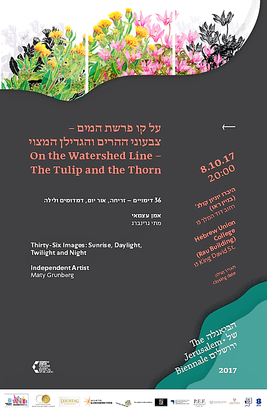 26 Exhibitions took part in Jerusalem Biennale of Art 2017 (http://www.jerusalembiennale.org/biennale2017-1/). Among them, Maty Grunberg's Exhibition – "On the Watershed Line – The Tulip and the Thorn", http://www.jerusalembiennale.org/exhibitions2017/#/new-gallery-38/ The exhibition was curated by Yivsam Azgad, curator and head of department of Media and Relation of Weizmann Institute of Science, where the exhibition was hosted during the last years in the department of Plant & Environmental Science. Now, the exhibition changed place to HUC - Hebrew Union College in Jerusalem, as part of Jerusalem Biennale of Art, 2017, and will stay there for the time . About the Project: Thirty-Six Images: Sunrise, Daylight, Twilight and Night The wild plants commonly found in Jerusalem and the surrounding area serve as the inspiration for this work of the artist, Maty Grunberg. Jerusalem and its surrounding environs are home to a varied population of many wild plants: from the charming and delicate Jerusalem tulip to the thorny and threateningly strong thistle. For thousands of years, plants scattered here from Central Asia, Asia Minor, Africa, Southern Europe and from the shores of the Mediterranean islands. Each one of them adapted to the habitat in the Jerusalem hills - from the blazing and sunburned summer to freezing winter nights; from rainy season to drought; and from the incomparably wonderful days of the Jerusalem autumn and Israeli spring. The work depicts a series of the wild plants' meetings between two cultures, between abundance and shortage, between softness and obstinacy. These encounters occasionally seem like hesitant initial contacts stemming from curiosity, sometimes like a type of peace negotiation or attempt to establish coexistence, and at others, as a never-ending struggle between the survivors. Jerusalem is a city that lies on the borderline – not just the political border, but also the border between the temperate north with its chill and snow and the hot south, the desert and the Negev. A border that marks an ecological boundary, a watershed line that distinguishes between the western hills, the freshness of their winter rains, and the wide expanse of wilderness east of the city that descends to the arid, dry shores of the lowest place on earth – the Dead Sea. It is this uniqueness that attracts and enables the existence of so many and such a rich variety of plants. More than one thousand species succeed in taking root, growing, flowering, bearing fruit and surviving here. Jerusalem's plant population, the like of which exists in only a few other places in the world, thrives despite, and perhaps because of, more than three thousand years of human history, fire and flood, and the cattle, sheep and goats that ate these plants. A fitting metaphor indeed for the history of the people who lived, and still live, in this unique landscape. Link to short video describing the work "The Tulip & the Thorn" https://youtu.be/6yKjL1ibFhE Hebrew Union College, Rau Building, , 13 King David St. Jerusalem Hebrew Union College - http://huc.edu/ written by Naomi R. Azar, M.G. Studio Manager
The Official Program of the OSTEN BIENNIAL of DRAWING Skopje 2016
seen through eyes of the photographer Alexandros Stamatiou.
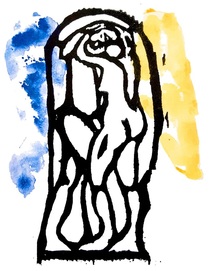 Next week Maty Grünberg will open an exhibition in which some of his artist's books will be on display. The exhibition presents a variety of works spread over decades of creation, using different techniques, from painting, through nineteenth century etchings, preparatory sketches with intrinsic artistic value, to twenty-first century digi-graphic methods. All the graphic works produced by MG are always accompanied by independent text. This property characterizes the connection between MG's visual work and writing. Each of the areas is independent and is created separately. The connection of image and text in the artist's book arouses an additional tier within the viewer… Over the past thirty years MG has created over thirty artist's book in cooperation with top writers including Nathan Zach, Yehuda Amichai, Amos Oz and others. The following artist's books will be on display in the present exhibition:
An artist-widower who lived in London most of his life returns to the city of Bat-Yam, Israel, where he meets a widow from bourgeois Ra'anana. They are both no longer young. Life has left its impression on them. Is love possible? Along with the texts written as Naomi's personal diary in which she describes the development of their relationship over the first years of their love, MG placed sketches he had made in London from 1970 to 1990 in preparation for various works. When Maty G. read the short items Naomi wrote he said to her: "I have sketches that have been waiting in my drawer for these texts for thirty years." "What are you talking about? She wondered, it's just my little diary, between me and myself, between me and you." "Don't you understand, he replied, don't you understand a man waits his entire life for such a love letter."
A short video, in Hebrew, Maty G. is covering the exhibition. https://www.youtube.com/watch?v=R-E8RG-wJ9Y&feature=youtu.be www.artisthouse.co.il
|
|

